

IN THE FUTURE ISSUE
STARRING:
COLAGRECO & MOLLY GODDARD PLUS: AI ART, ELECTRIC CARS, SUBMERSIBLE SUPERYACHTS & FASHION’S STARS OF TOMORROW
ALISON JACQUES, MARIJE VOGELZANG, MAURO
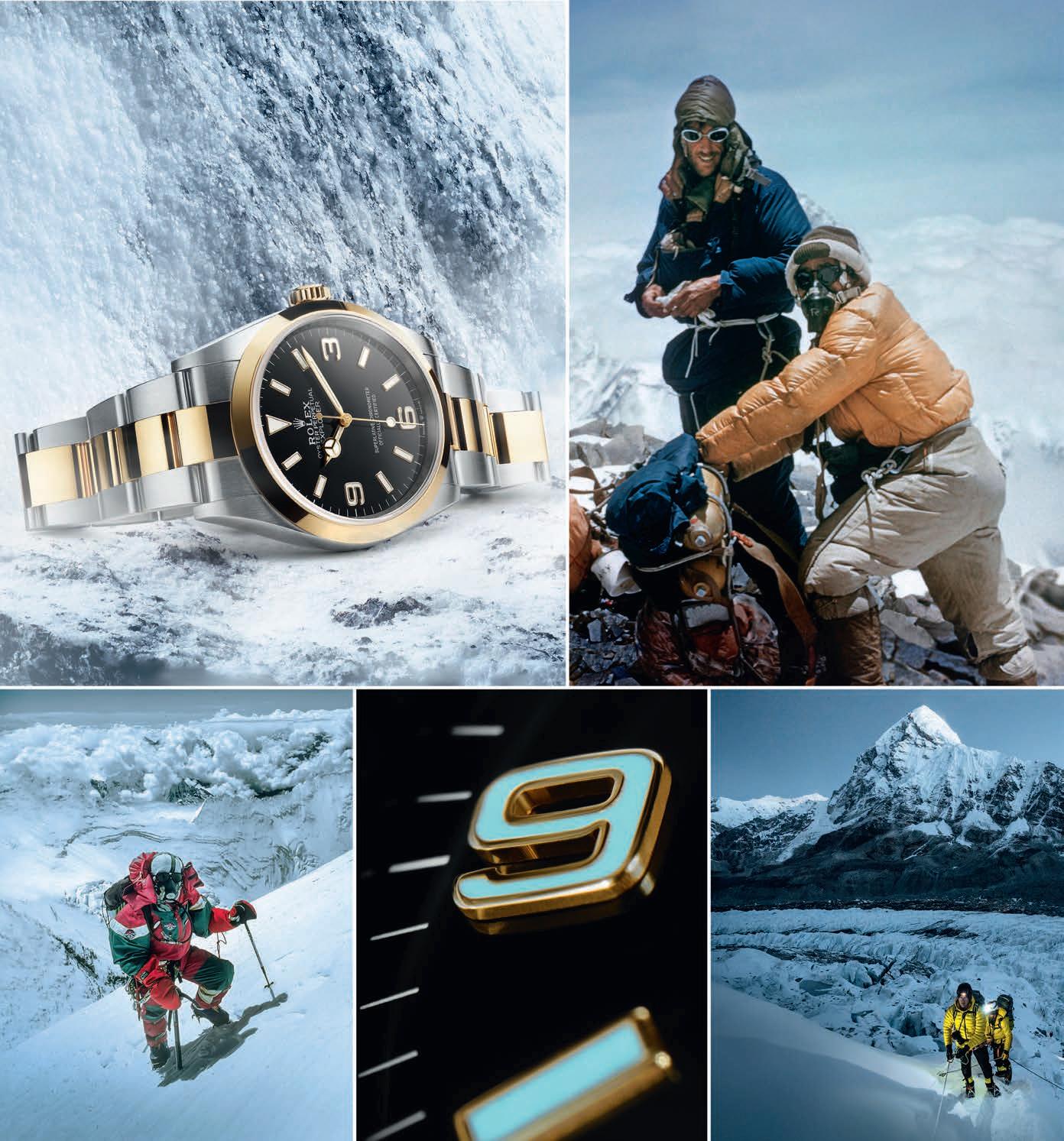










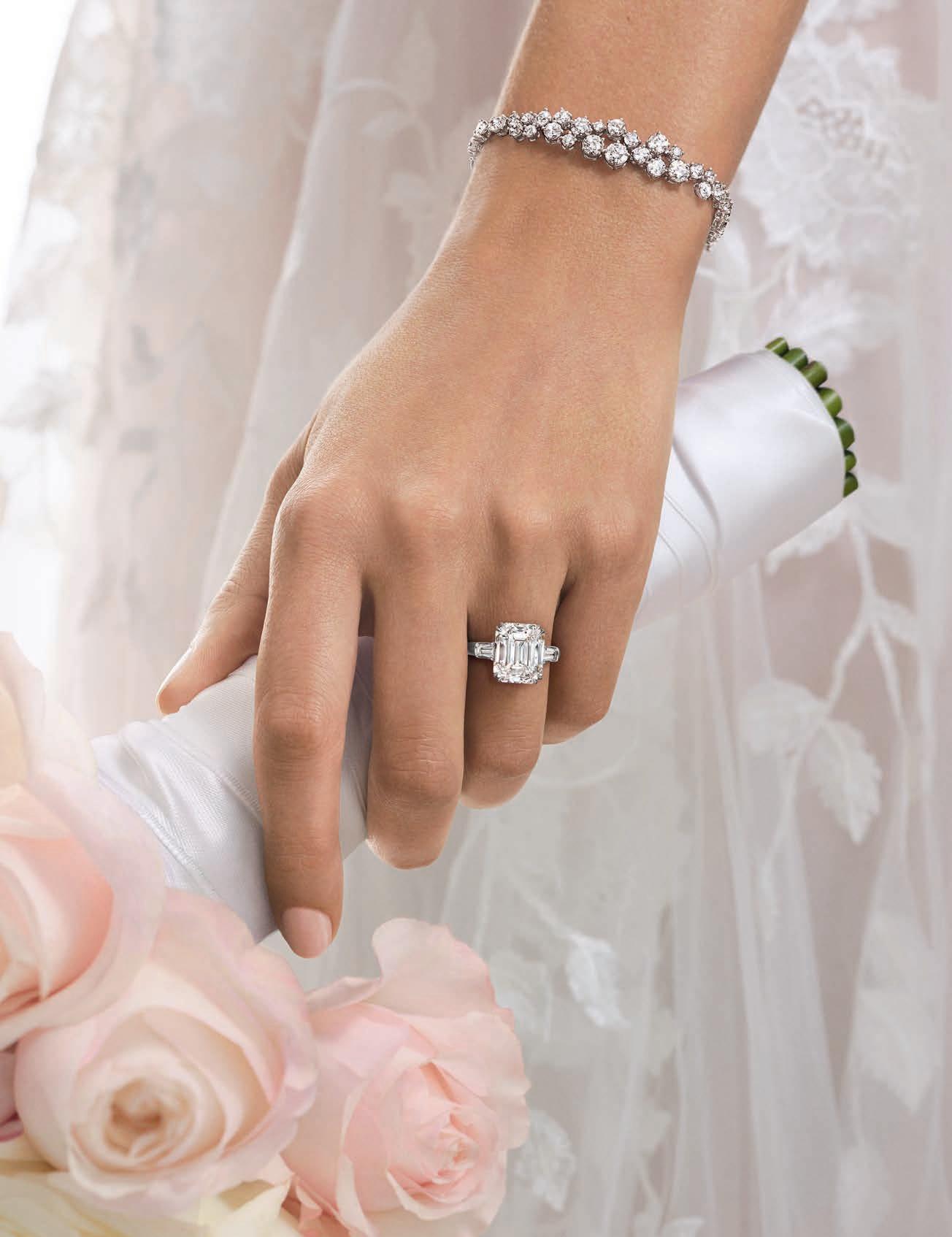


CLASSIC WINSTON ©2024 Harry Winston Inc. HARRYWINSTON.COM
makes muse?

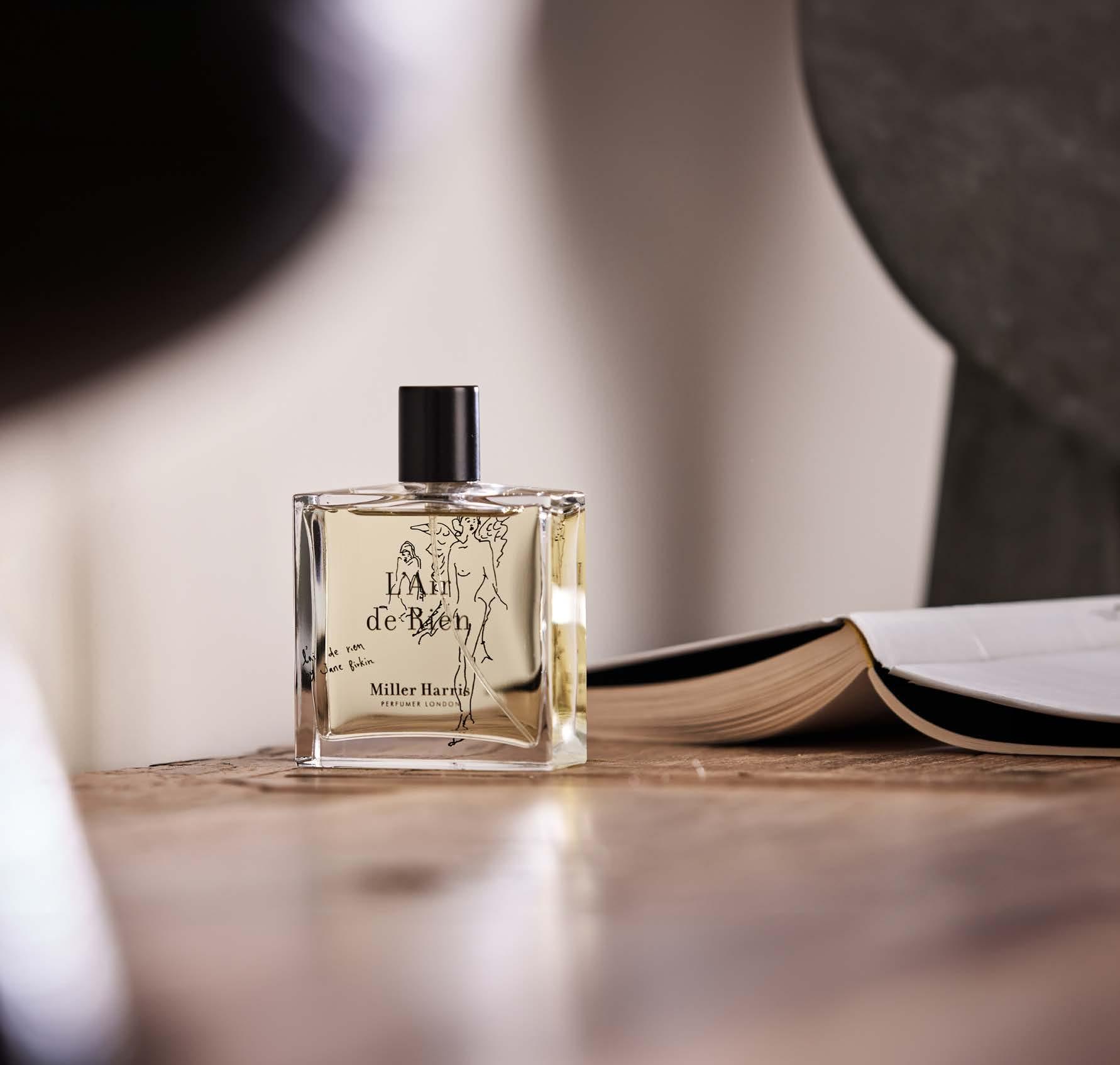


A muse is born from passion, fuelled by curiosity, and flourishes in the alchemy of creativity. With a spirit untamed and originality unmatched, their beauty is timeless. Radiating a presence that lingers in the air, they leave an indelible mark on all they touch - forever celebrated in the stories they inspire.
L’Air De Rien | The Scent of a Muse
Discover a Miller Harris scent, and discover your muse.

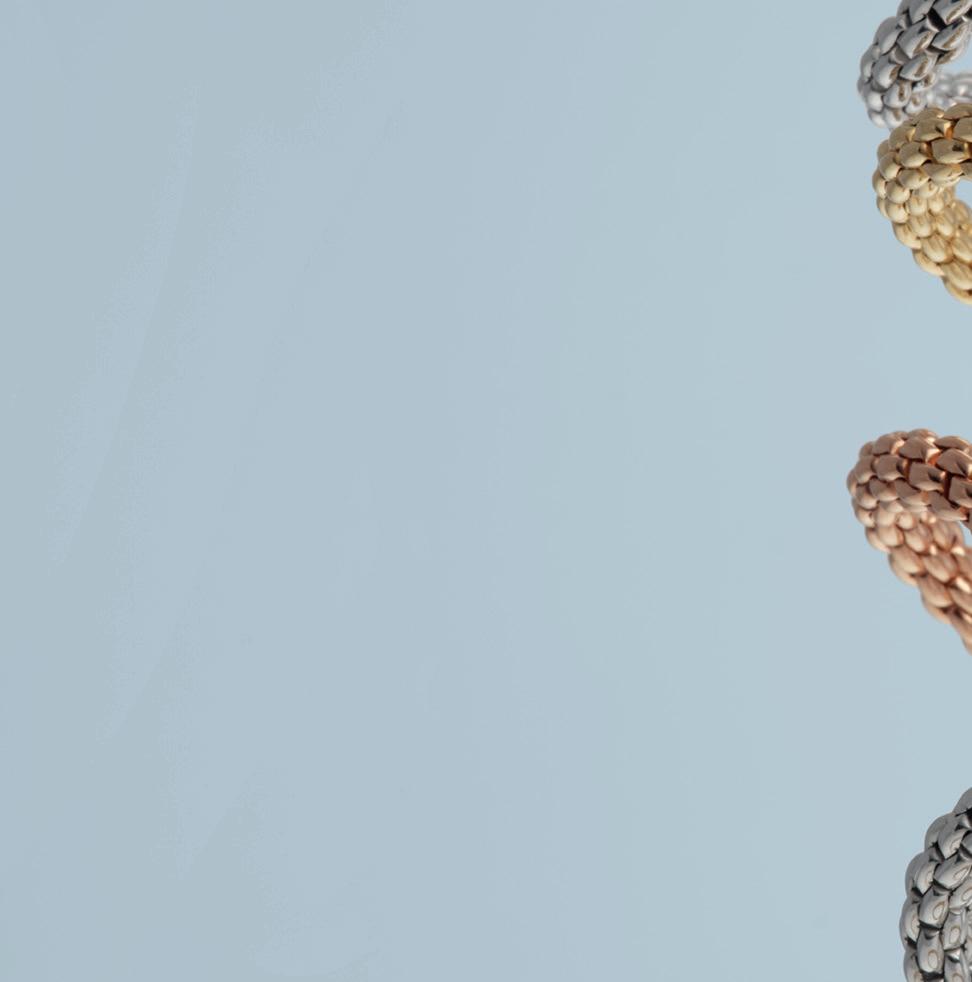

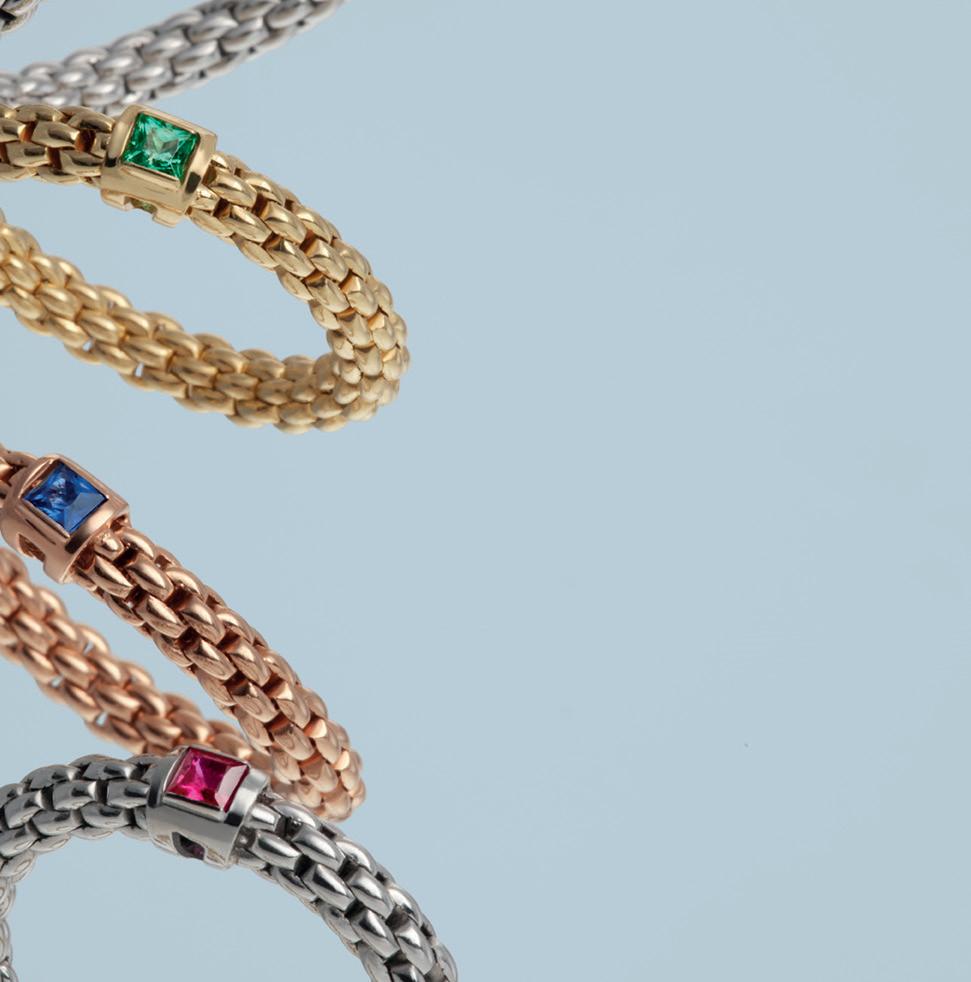







DISCOVER MORE AT OUR LONDON FLAGSHIP BOUTIQUE AT 1A OLD BOND STREETfope.com
CONTENTS
UP FRONT
15 THE BRIEFING
The latest news from the world of luxury
INTERVIEWS
38 FOOD FOR THOUGHT
Meet Marije Vogelzang, one of a new generation of ‘food designers’
42 S TATE OF THE ART
Gallerist Alison Jacques on why she’ll always champion the underdog
48 SMOO TH OPERATOR
How Emily in Paris star Lucien Laviscount became Hollywood’s next leading man
CULTURE
58 THE FUTURE AGENDA
Your curated guide to pioneering culture in the capital
66 WHO FRAMED AI?
How seriously should we take art generated by artificial intelligence?
72 WAITING IN VAIN
Inside Bob Marley’s search for an alternative cancer cure
COUTURE
82 NEW BL OOD
The rising star designers who are changing the way we dress
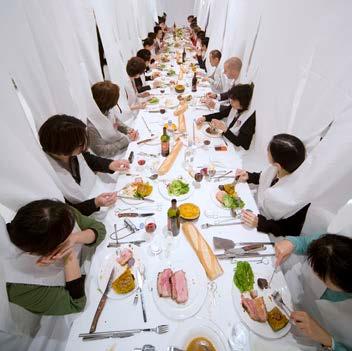

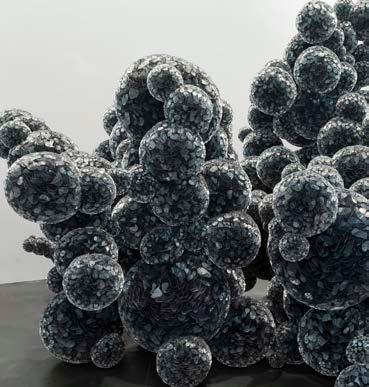


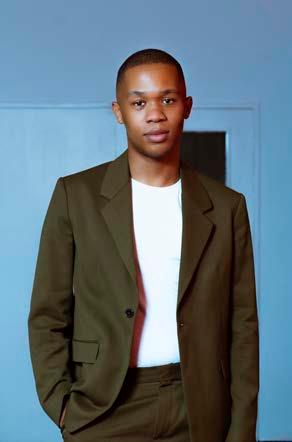
38 22 90 89 63 58
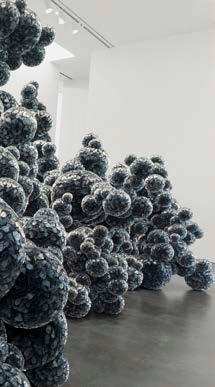
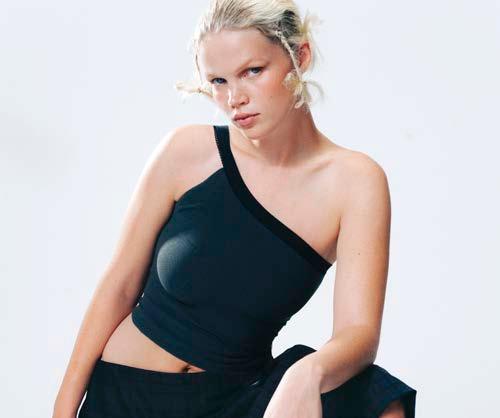

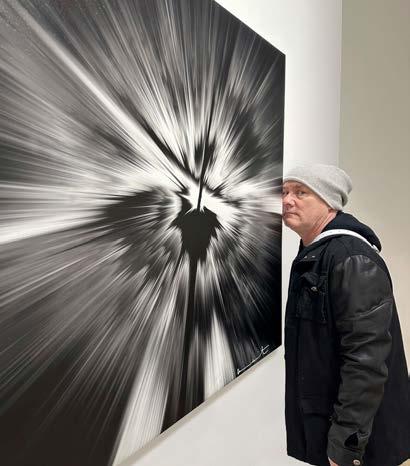

90 KILLING TIME
The watch brands keeping time on the future
94 CUT FROM A DIFFERENT CLOTH
The unlikely bio-textiles providing an alternative to conventional fabrics
ESCAPE
104 THE HOT LIST
The biggest hotel openings to know about in 2024
114 BREAKING OLD GROUND
AlUla has opened up to the world, and travellers are in for a surprise
122 HOW SYDNEY GOT IT S SWAG BACK
The Australian city has rediscovered its mojo thanks to a slew of sophisticated new openings
128 HOT PROPERTY
Inside the first apartment to go on sale at The Whiteley
130 ON THE MARKET
An 18th century mansion receives a £50 million renovation

THE FUTURE ISSUE lucien COVER Man of the Moment: Lucien Laviscount photographed by Dean Isidro, page 48 66 60 16 86
FROM THE EDITOR
SPRING 2024
Issue 35
There’s a watch on page 91 that will tell you how long it takes light to travel to each planet in our solar system. The watch costs north of £60,000, so I’ll save you the money. From the Sun to the closest planet, Mercury, it takes 3.2 minutes. To Earth, 8.3 minutes. To Neptune, the furthest away planet, 4.1 hours. You can look up the rest yourself.
Felix Baumgartner and Martin Frei, the watch’s creators, are fascinated by space and time. Their watch, the UR-100V LightSpeed, invites us to consider the out-of-sync relationship we have with the ‘present’. The light we see today, they and their watch points out, is an echo of a past that no longer exists. Light travels to us from a point we haven’t yet experienced. Which was a long and winding way of introducing the theme of our 2024 spring issue: that wispy hypothetical that is the future.
In the not too distant past, Lucien Laviscount, our physically impoverished cover star, was a jobbing actor constantly in search of work. And then came Emily in Paris. And suddenly the erstwhile soap star was being invited to Oscar parties and hearing his name swirling in the James Bond rumour mill. With the attention of Hollywood piqued, the future is something the Burnley boy plans on grabbing with both hands (p48).
Mauro Colagreco, the much-garlanded three-Michelin-star chef behind 2019’s World’s Best Restaurant (Mirazur in Menton), believes the future of food, and the health of our planet, relies on a shift to local produce, particularly fruits and vegetables. Discover how that commitment is manifested at Colagreco’s eponymous restaurant at the new Raffles hotel on page 30. On the subject of food, did you know that almost 50 per cent of the massmarket products we eat today weren’t invented five years ago? Meet Marije Vogelzang, one of a growing number of ‘food designers’ concocting the dishes of tomorrow, on page 38.
Who else? Art gallerist Alison Jacques, who is on a mission to provide overlooked artists of the past with a platform in the present (p42); eight rising star fashion designers changing the way we dress (p82); and a cohort of spaceage watchmakers experimenting with the very way we measure time (p90).
Plus: is artificial intelligence the future of art (p66)? Are algae trousers the future of fashion (p94)? Will, and should, Saudi Arabia’s sci-fi vision of the future, Neom, ever be built (p16)? And, now that it’s open to international travellers, will AlUla, the country’s ancient World Heritage region, become the new Petra (p114)?
Make your own predictions. Enjoy tomorrow’s issue.
Richard Brown
RICHARD BROWN Editorial Director
Anna Solomon
Rob Crossan
Josh Sims
Charlie Thomas
Juhong
Georgia Evans
Louis Nassé
Tom Henry
Asleen Mauthoor
Daphne Kovacs
Sophie Lockyer
Alice Ford
Eren Ellwood

LUXURYLONDON.CO.UK
6 SALEM ROAD, LONDON, W2 4BU T: 020 8152 7855 WWW.LUXURYLONDONMEDIA.CO.UK PUBLISHED BY EDITORIAL DIRECTOR
DIGITAL EDITORIAL
DIRECTOR
Zoe Gunn SENIOR EDITOR
ASSISTANT DIGITAL
EDITOR
& COMMERCIAL
EDITOR-AT-LARGE
CONTRIBUTING EDITORS
Annie Lewis BRANDED CONTENT
WRITER Hitanshi Kamdar
Annabel Harrison
HEAD
DESIGNER
OF DESIGN Laddawan
& PRODUCTION
MARKETING
MANAGER
ASSOCIATE
MANAGING DIRECTOR
BUSINESS DEVELOPMENT MANAGERS
DIRECTOR Fiona Smith
Rachel Gilfillan
RELATIONSHIP
CLIENT
MANAGER
CHAIRMAN
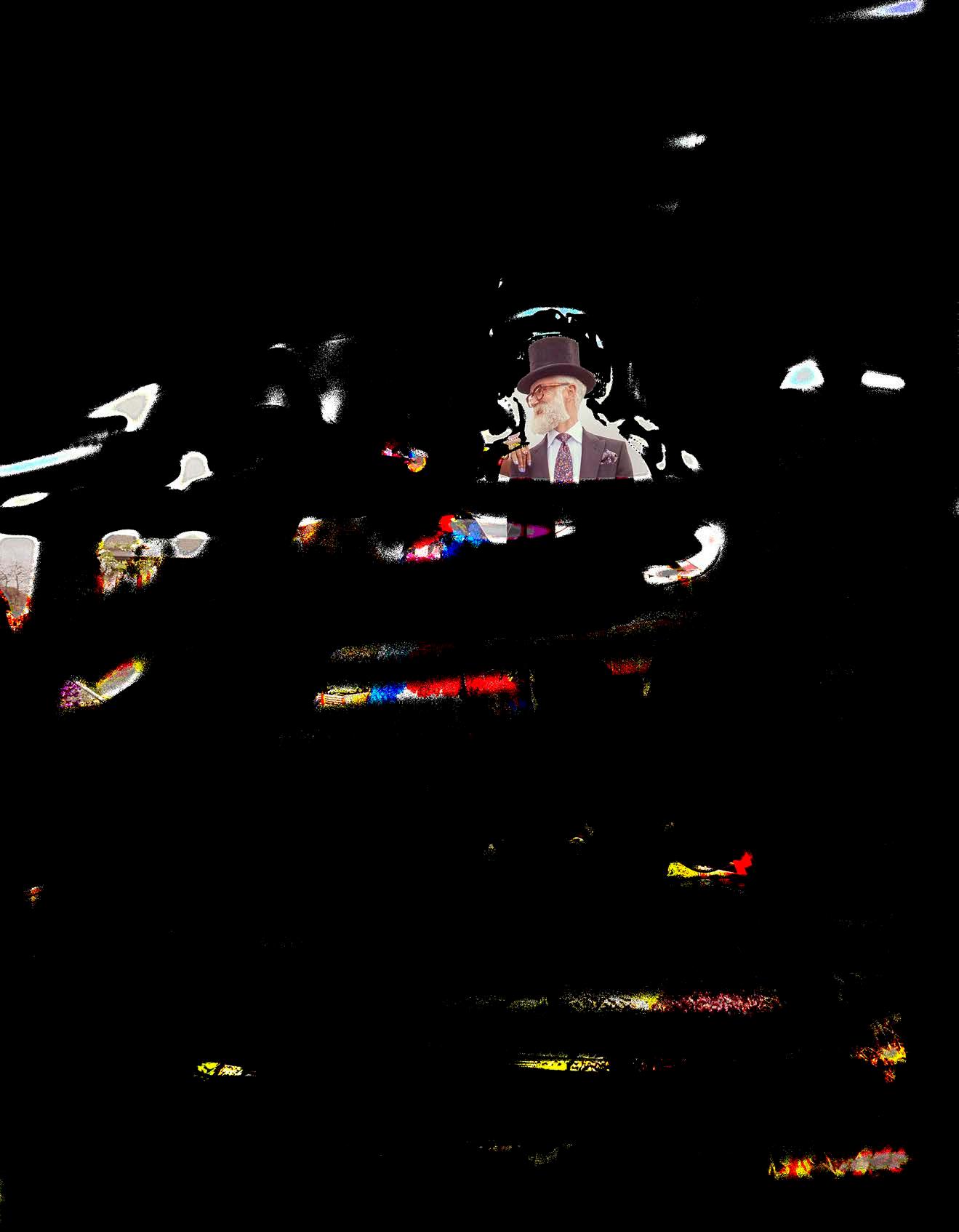



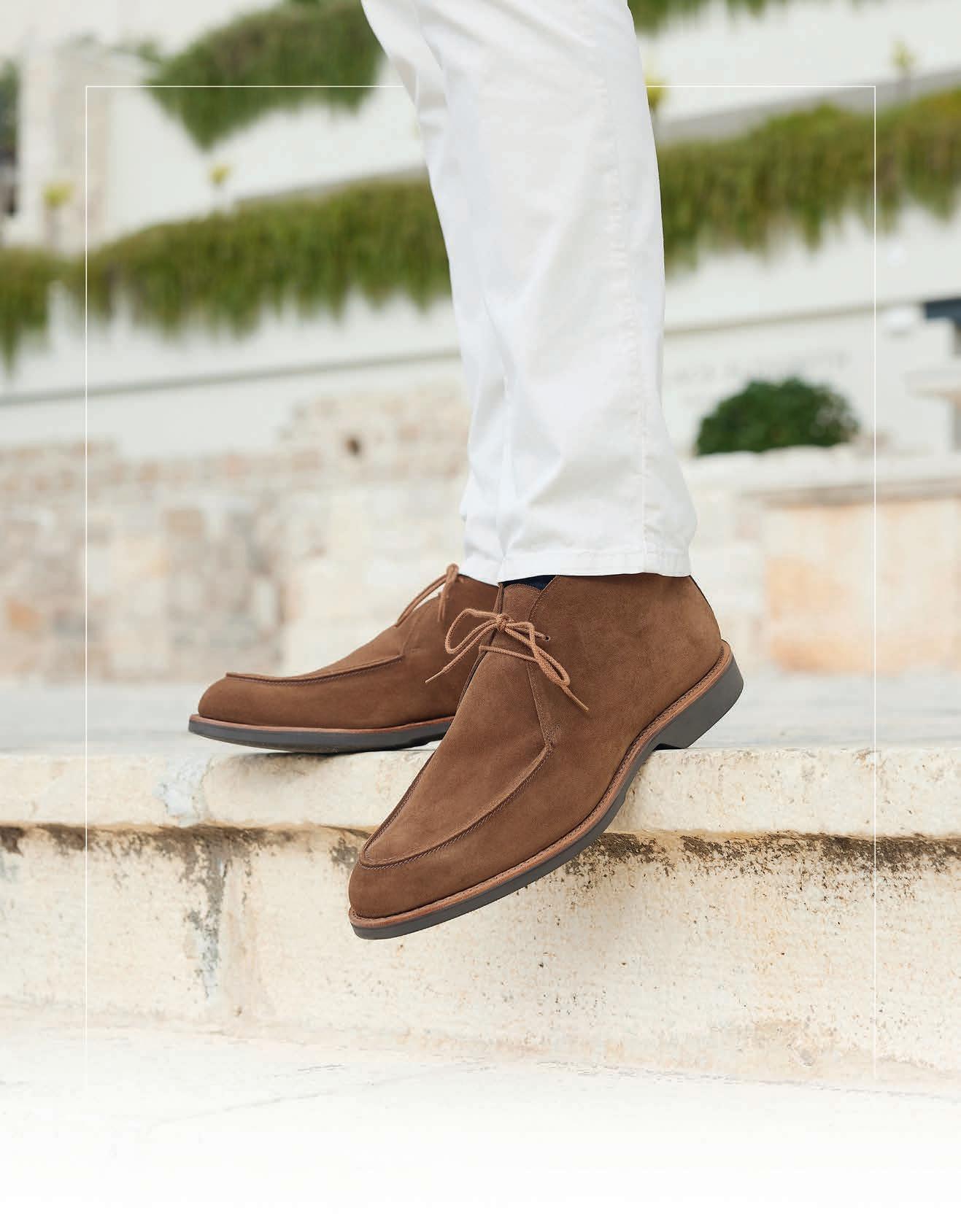
Bibury
Our
Snu
BY APPOINTMENT TO HRH THE PRINCE OF WALES MANUFACTURER AND SUPPLIER OF FOOTWEAR CROCKETT & JONES LIMITED, NORTHAMPTON MADE IN ENGLAND | SINCE 1879 CROCKETTANDJONES.COM
Suede
a summer classic, The Chukka featuring our new Wedge Rubber Sole
relaxed adaptation of

The Briefing
LUXURYLONDON.CO.UK
16 The Giga-project Is Saudi Arabia’s sci-fi city about to become a reality? 22 The Car The all-new, all-electric, very un-Lotus-y Eletre S 26 The Hotel Is the new Peninsula London worth the money? 30 The Restaurant Does Mauro Colagreco at Raffles live up to expectations?
LATEST NEWS FROM THE WORLD OF LUXURY
34 The Submersible A new submersible superyacht promises to take guests under water for four weeks at a time
THE
SIRANNA, A DEVELOPMENT DESIGNED BY ARCHITECTS WOODS BAGOT FOR SAUDI ARABIA’S PROPOSED NEOM PROJECT, P.16


THE GIGA-PROJECT
Neom, Saudi Arabia
DESPITE SPIRALLING COSTS, MISSED DEADLINES AND SERIOUS QUESTIONS OVER ITS REAL-WORLD FEASIBILITY, SAUDI ARABIA PLOUGHS AHEAD WITH ITS $500 BILLION VISION OF THE FUTURE
Words: George Thompson
01 THE TERMINUS OF ONE END OF THE LINE, A 170KM-LONG, 500M-HIGH LINEAR CITY PROPOSED FOR THE SAUDI ARABIAN DESERT ©NEOM
Technological progress has, in the grand, epoch-spanning scheme of things, raised living standards across the world in an astonishingly short space of time. In the span of 100 years, personal transport has gone from loud, unreliable motorised wagons to highly-efficient electric cars capable of travelling hundreds of miles on a single charge. In just 20 years, mobile phones have transformed from simple devices to handheld computers, complete with 4K video and AI capabilities. Improvements in medicine mean that we are living longer. Reliable supplies of water, food, electricity and, more recently, the internet, have made everyday life that much easier.
Yet not all progress has arrived without cost. The production of electric cars, for example, isn’t as green as manufacturers and governments would have you believe. Once on the road, there is no question that EVs are more environmentally friendly than combustion engines. But, according to a 2021 study by the Internetwork for Sustainability, electric cars create far more carbon emissions during their production than internal combustion vehicles. Then there’s the question of charging infrastructure, with many EV stations drawing their electricity from fossil fuel sources.
Similarly, mobile phones aren’t all good news, with links between social media and poor mental health, and the metal extraction used for production particularly harmful to the environment. Whenever something ground-breaking materialises, promising
to revolutionise the way we live, there’s usually a caveat buried somewhere in the small print. And so to Neom, a giga-project of quite unfathomable proportions currently under construction in the Kingdom of Saudi Arabia.
Neom is quite sure that it will change the world. In various advertisements the project is described as a ‘civilisation revolution’ and ‘a new way of living’. It claims ‘the world needs Neom because the world needs change’. But since it was announced in 2017, the project has garnered more criticism than praise, with environmental concerns, possible human rights abuses and the simple, overriding question: ‘why?’
What, then, exactly is Neom? Read the marketing material and it’s easy to get confused. In essence, it will be a new urban environment built entirely from the ground up, encompassing a number of regions and cities within a 10,200 square mile radius, an area of desert larger than the size of Wales, which borders the Red Sea.
It’s one of the biggest talking points of Saudi Arabia’s Vision 2030 plan to diversify the country’s income away from oil. Mohammed bin Salman Al Saud, Saudi’s Crown Prince, is overseeing the project personally, with the idea to transform the country into a world leader in tourism, education and business. The Kingdom will draw upon the great wealth it has accumulated from oil to fund Neom, with $500 billion already committed to making the Crown Prince’s science-fiction-like dreams a reality.

18 LUXURY LONDON THE BRIEFING LUXURYLONDON.CO.UK
A SPORTS STADIUM IN NORLANA, A WELLBEING-FOCUSED WATERFRONT COMMUNITY WITHIN NEOM ©NEOM

A CGI OF HOW LIFE MIGHT LOOK INSIDE THE LINE ©NEOM


You’ve probably seen videos of what Neom will look like on Instagram or TikTok. Photos of a vast channel dug into the sand for Neom’s hero project, The Line, have gone viral. A 500m-high, 200m-wide, mirror-walled linear city, The Line will stretch arrow-straight for 170 kilometres through the desert. The city, which will be car free, has been designed to house nine million people within walkable communities, with all basic services reachable within a five-minute walking distance.
Google ‘The Line’ and you could be forgiven for presuming the images and videos thrown up are the dystopian setting of some new Denis Villeneuve film. They are, in fact, real masterplans. Even
more unbelievably, construction is well under way on making those CGIs a reality.
Building work has begun for Neom’s other districts, too, overseen, quite bemusingly, by a number of the world’s top architects and architectural firms. There’s Aquellum, an upside-down, subterranean skyscraper built into a mountain, designed by Name Architecture. Another is Trojena, a new ski resort located in the Tabuk mountains. It’s been designed by LAVA, Zaha Hadid Architects, UNStudio, Aedas, Mecanoo and Bureau Proberts.
Other projects include Norlana, a coastal port town, by 10 Design; Oxagon, an octagonal port city by Danish studio BIG; and Xaynor, a beach member’s club by Mexican studio Sordo Madaleno Arquitectos. Each project looks like a different take on a Bond villain lair, but it is The Line that is the most stupefying – a project so vast, complicated and otherworldly, that it’s hard to imagine it would be possible to build, even if anyone actually believed it was a good idea to do so.
Giles Pendleton, chief operating officer of The Line (formerly chief development officer of South African real estate investment fund, Attacq) has posted a series on LinkedIn titled ‘Neom is real’, almost to convince himself that the project is making headway. Denis Hickey, The Line’s chief development officer (previously of ING Real Estate) has claimed in a video uploaded to Neom’s official YouTube channel that “the first phase of The Line will be complete by 2030... We are committed”. A video advertisement released
20 LUXURY LONDON THE BRIEFING LUXURYLONDON.CO.UK
THIS IMAGE PART OF NEOM’S TROJENA SKI RESORT, CO-DESIGNED BY ZAHA HADID ARCHITECTS ©NEOM BELOW THE ADVENTURE HOTEL IN NEOM’S LUXURY TOURISM RESORT, LEYJA, DESIGNED BY CHRIS VAN DUIJN/OMA ©NEOM
in February 2024 declares that “one of the most ambitious projects that the world has ever seen is progressing rapidly.”
At the time of writing, the foundations are, indeed, being laid, with 2,000 trucks reportedly working on the channel in which The Line will be built. Originally, the project was slated to be finished by 2025, before a new deadline of 2030 was proposed. Suspending disbelief, and assuming all goes to plan, what will The Line actually be like once it’s complete?
The city’s nine million residents will, supposedly, be able to travel from end to end in 20 minutes, although it’s not yet been explained how this will be possible. Many services will be autonomous, using artificial intelligence in one form or another. Energy and water supplies are said to be 100 per cent renewable, while the mirror glass façade is intended to work with and complement the surrounding landscape, in a similar fashion to the Maraya building in Saudi Arabia’s AlUla region (p.114).
While renderings of Neom are, undoubtedly, breath-taking, many of the design world’s foremost figures are sceptical. Marshall Brown, director of the Princeton Urban Imagination Center told architecture and design magazine Dezeen: “There would be so many physical and environmental phenomena that would have to be dealt with to achieve the incredible minimal and singular character that the renderings propose... These images project a degree of control which is very difficult to retain, especially over a period of time, even in a very autocratic society.”
Philip Oldfield, director of the architecture programme at the University of New South Wales, Sydney, also points towards the pragmatics. He told Dezeen: “Some of the internal spaces at The Line look incredibly alluring – lush atria, vast cavernous interior spaces Grand Canyon-esque in scale, with residents perched on the edge enjoying picnics. Even if these were built, the satisfaction of residents would mostly be informed by how such spaces are operated and managed, not how dramatic they look.”
He posed some important questions, which are yet to be answered. “What rules will be set?”, he asked. “Can visitors use all the spaces? Which are public, which are private? Will you really be allowed to have a picnic on a ledge above a 200-metre-high atrium? Call me a cynic, but I highly doubt it.”
There are more concrete, and serious, issues related to Neom. Celebrated British architect Sir Norman Foster was initially part of the advisory board for Neom when it was announced in 2017. But he resigned after the Saudi government was found responsible for the murder of journalist Jamal Khashoggi at the Saudi consulate in Istanbul in 2018. Sir Jonathan Ive, former chief design officer at Apple, was also originally listed

as an advisor, but a week after Khashoggi’s murder, Apple claimed his inclusion on Neom’s list was a ‘mistake’.
On 2 October 2022, Saudi’s Specialised Criminal Court sentenced family members Shadli, Ataullah and Ibrahim Salih al-Huwaiti to death for opposing eviction to make way for Neom, according to ALQST, an independent organisation working to defend human rights in Saudi Arabia. Shadli is the brother of Abdul Rahim al-Huwaiti, who “was shot dead by security forces in April 2020... after he posted videos on social media opposing the displacement of local residents to make way for the project,” according to ALQST –a news story also reported by the BBC.
When the United Nations Human Rights Council issued a statement denouncing the planned executions, the Saudi government responded by claiming the men were being killed for their connection to Daesh and Al-Qaeda. The government also denied that any forcible relocations had taken place, stating that 6,360 individuals have so far been relocated, and fully compensated for doing so.
If, how and to what extent Neom will ever be realised remains unclear. So far, the project has been a story of awe, controversy and contradiction. A recent advertisement claimed that The Line will be a ‘a sustainable city with zero emissions’, and in the same sentence explained how ‘millions of cubic metres of earth and water are being moved per week’.
The only certainty is that Neom is intended to be a show of force and an exclamation of power. It demonstrates Saudi Arabia’s aspirations of becoming a leading nation. Just how seriously the sci-fi giga-project plays into those ambitions remains to be seen.
21 LUXURYLONDON.CO.UK
THE WELLNESS HOTEL CONCEPT IN LEYJA BY SHAUN KILLA/KILLA DESIGN ©NEOM

02
THE CAR
Lotus Eletre S
THE BRAND NEW, ALL-ELECTRIC LOTUS IS VERY UN-LOTUS-Y. NOT ONLY IS THE CAR AN SUV – IT’S ALSO BUILT IN CHINA
Words: Jeremy Taylor
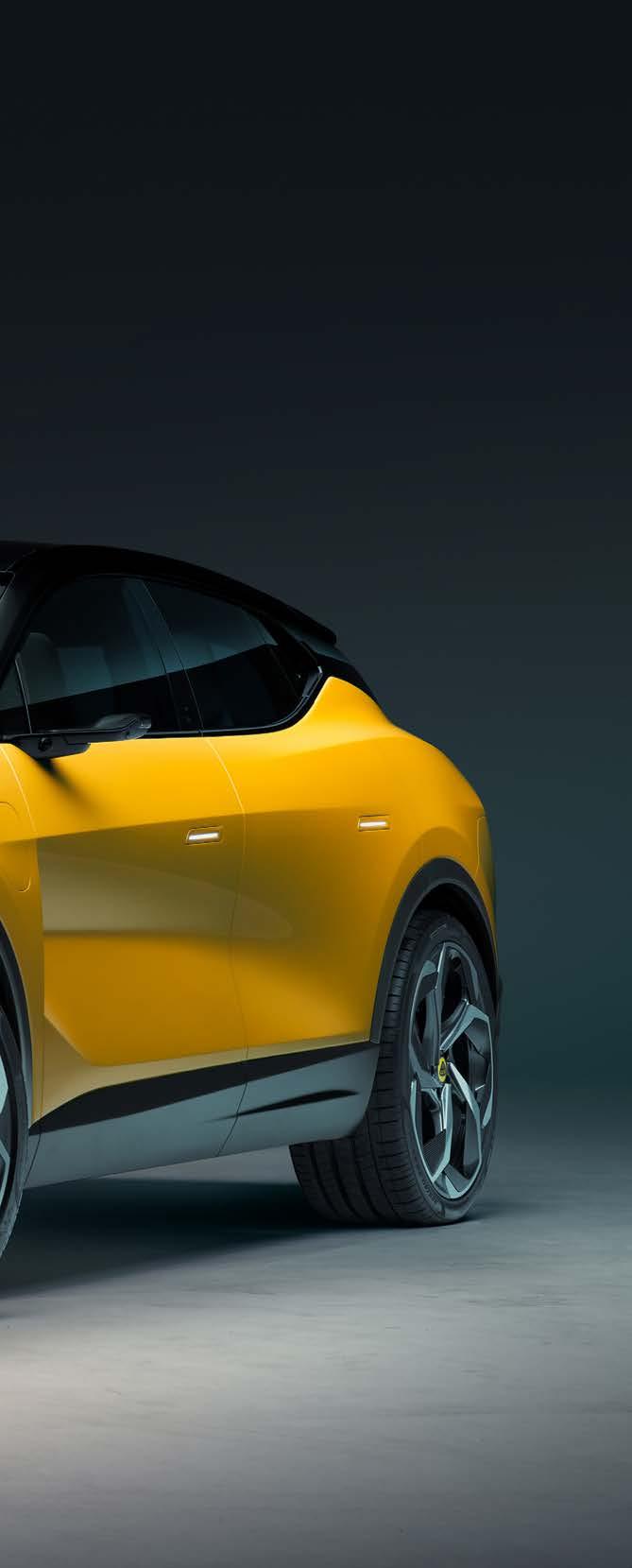
Anyone who has been to the Norfolk village of Hethel will know the story of Lotus. Back in the mid-1960s, Colin Chapman’s growing sports car business was pushed out of the capital by rapid expansion and forced to set up in a remote site near Norwich. Hethel’s only other claims to fame include England’s oldest living hawthorn tree and a splendid Saxon church.
Even the official Lotus website admits that the site, a former RAF bomber base, was ‘on the edge’. But the flat, open terrain of the Hethel airfield turned out to be perfect for Chapman’s expansion plans and test track requirements. The first model to come out of Lotus’ Norfolk era was the Europa coupé. Now, almost 60 years later, the marque has just built the most controversial car in its history: the Eletre S.
Chapman was obsessed with speed, and his mantra was ‘simplify, then add lightness’. Lotus has thus developed a reputation for lightweight cars, and the performance that accompanies them. The all-new, 2.5-ton SUV Eletre is, then, a big deal.
Most of that weight is down to the EV’s 650kg battery. The lithium-ion pack alone weighs more than Chapman’s legendary Lotus Seven – the iconic two-seater that personified his philosophy of performance through simplicity. The Seven dates back to 1957 and is still built to this day as the Caterham 7.
Chapman might have been able to deal with the prospect of his company manufacturing a bulky SUV, but knowing that the largest and heaviest Lotus ever would also be the first to be built outside of Norfolk probably would have been beyond the pale. Parent company Geely – the automotive giant behind Volvo and Polestar – now has a Lotus plant in Wuhan, China. The Eletre was designed in Coventry, at least.
A coupé -esque SUV with more than a hint of Lamborghini Urus styling, the svelte Eletre certainly looks the business. It may be a sports utility vehicle, but the Lotus boasts sharp, angular lines that more than hint at dynamic performance, as do touches of carbon fibre.
The aerodynamic team at Lotus has been hard at work reducing the drag coefficient to 0.26, helped by a series of vents in the bonnet, lower grille and front bumpers. The most noticeable are


located at the outer edges of the rear, and channel air in behind the back wheels and out through the bodywork.
Despite the outsize dimensions, chief designer Ben Payne has managed to give the Eletre the feel of a genuine Lotus: the ‘shark’ nose bonnet, enormous 22-inch wheels, deployable roof spoiler and glass canopy cabin all add serious quality.
I’m not so sure, however, about the gimmicky, full-width ribbon light at the rear, which changes colour according to the battery charge. Elsewhere,
in a nod to the Chapman philosophy, body panels are cut from aluminium.
The dual motor, all-wheel drive Lotus is certainly fast. Eletre is sold as either a 905 bhp ‘R’ model starting from £120,000, or as the entry level ‘Eletre’ and ‘S’ models, costing from £104,500 and offering 603 bhp.
I drove the mid-range S, with a 112 kWh battery pack that promises an official range of up to 373 miles. That’s trimmed to 310 miles for the barnstorming R, which silently races from 0-62mph in under three seconds – giving the Tesla Model X Plaid a run for its money. Lotus claims the car is the world’s fastest dual-motor production SUV.
Behind the wheel, the S is unflustered at speed, with excellent grip aided by active air suspension and optional active anti-roll bars. Some might also find the optional rear-wheel steering takes some getting used to; it’s standard on the R, as is the Lotus Dynamic Handling Pack, which adds launch control and racing-spec tyres.
The Eletre measures 5.1 metres, but somehow looks smaller when you see it in the metal. Parked next to a chunky Range Rover, the futuristic SUV also looks like it has arrived from another planet.
With the right charger, the 800-volt architecture can add 250 miles in 20 minutes. Which is a good thing, considering I found the predicted in-car range depleted much, much faster than expected (and I wasn’t gunning it).
That, the silly key card entry system, and the incredibly annoying driver assistance alerts aside (if I need a beeping reminder than I’m near the
24 LUXURY LONDON THE BRIEFING LUXURYLONDON.CO.UK
LOTUS ELETRE S – THE NUMBERS

edge of the road I probably shouldn’t be driving a Lotus in the first place) – the Eletre is a very decent first stab at a super-SUV. At least Lotus hasn’t installed any fake engine noises, pumped through the sound system to ‘enhance’ the EV driving experience.
Available as a four or five-seater, the interior is the best I’ve seen in a Lotus: top-quality leather, sustainable materials, and genuinely practical. There is nothing Lotus-esque about the layout, but everything feels premium to the touch. Expect decent head and legroom, plus 688-litres of rear boot space – not forgetting the 46-litre frunk.
Finding your way around the infotainment system and other controls can be tiresome; few of the switches and dials fall to hand intuitively. For example, door mirror adjustment is operated via a button on the driver’s door, followed by fiddly, over-sensitive buttons on the steering wheel. Everything’s there, somewhere, but usually involves a sub-menu. You might have to read the manual, heaven forbid.
Lamborghini and Aston Martin have proved that high-sided SUVs can be a blast, and the Eletre is certainly cut from the same cloth. The pricier R model, which undercuts both rivals, represents great value in comparison, and has genuine

novelty value – at least for now. And let’s not forget that the Lotus is an electric vehicle, which waves two fingers at the Congestion Charge.
Judge the Eletre as an electric SUV, and not as a Lotus, and it makes a compelling proposition. The tweed-capped traditionalists will loathe it, of course, but if the Eletre helps a great British brand survive and thrive, I imagine even Chapman would have approved in the end.
From £89,500, lotuscars.com
25 LUXURY LONDON THE BRIEFING LUXURYLONDON.CO.UK
MAX POWER 603HP MAX TORQUE 710NM 0-62 MPH 4.50 SEC TOP SPEED 160MPH CHARGING TIME 0-100% 5.8 HOURS COMBINED RANGE 373 MILES
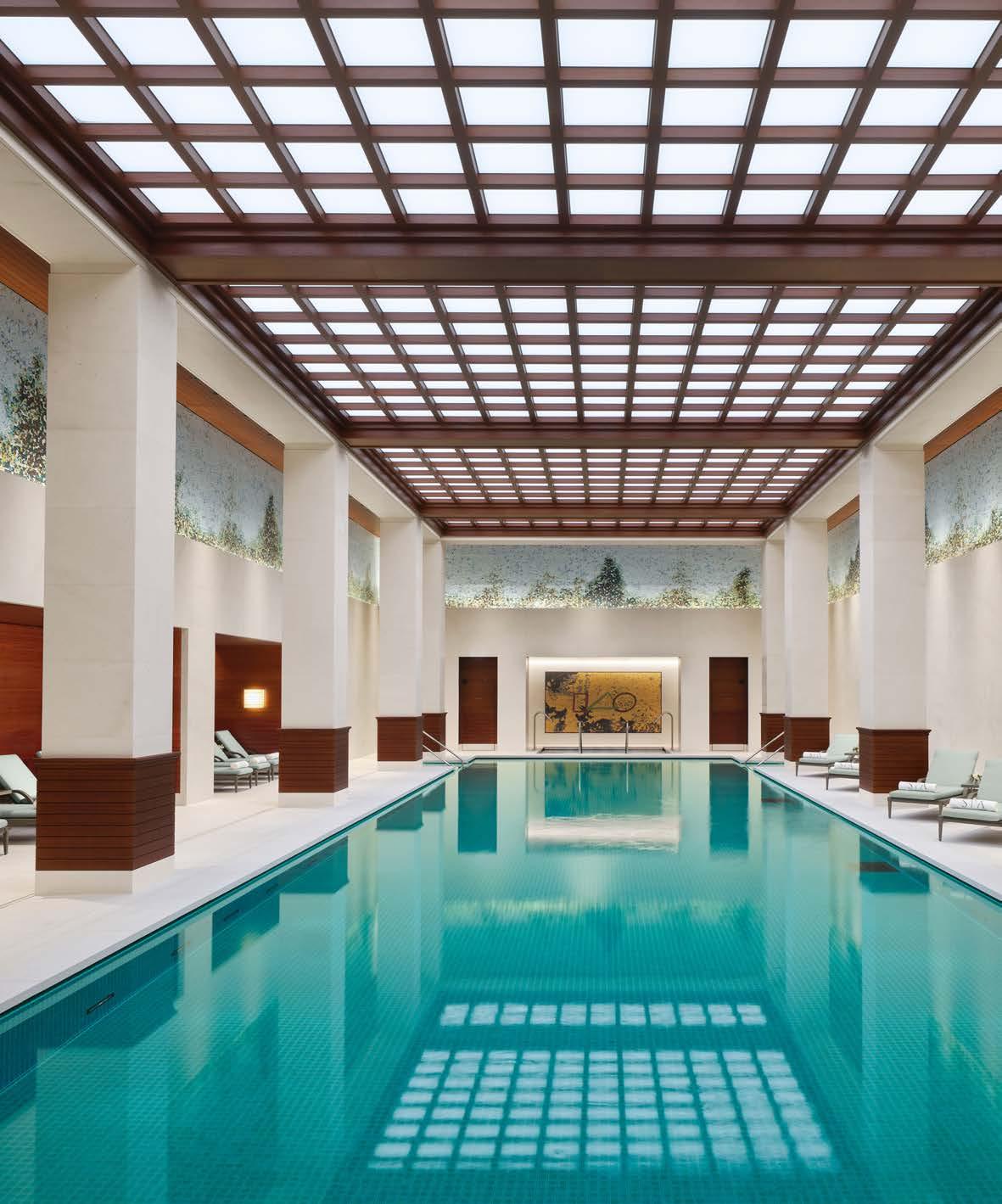
26 LUXURY LONDON THE BRIEFING LUXURYLONDON.CO.UK

THE HOTEL
Peninsula London, Belgravia
HAS LONDON’S NEW, MOTOR RACING-ENTHUSED SUPER-HOTEL TAKEN THE CAPITAL’S HOSPITALITY SCENE UP A GEAR, OR HAS IT STALLED AT THE STARTING LINE?
Words: Anna Prendergast
Like the birth of any star, The Peninsula’s inception hinged first on the collapse of material: the demolition of a concrete 1970s office block at Hyde Park Corner. Then, a stellar crew of architects, designers and feng shui masters were enrolled to deliver what promised to be London’s first five-star newbuild hotel since 2012, when the Bulgari opened in Knightsbridge.
Four months after the grand opening, I travelled from Brixton to Belgravia in a custombuilt, ‘Peninsula Green’ BMW i7 to find out how the hotel was getting on now that the stardust had settled. Its fleet of green machines are signature ‘Pen’ – the hotel group first ordered a recordbreaking seven Silver Shadows for the Hong Kong outpost in 1970; just four years later, The Man with the Golden Gun was released in cinemas, in which Mary Goodnight, played by Britt Ekland, tells Roger Moore’s James Bond: “Everyone knows all the green Rolls-Royces belong to the Peninsula.”
Behind the wheel is Laszlo, a softly-spoken Hungarian who trained as a SWAT officer before moving to the UK and becoming a chauffeur. He deposits me in a cobbled courtyard inspired by Palazzo Farnese in Rome, in front of the hotel’s Portland stone façade.
Inside, check-in is fast and painless, and I’m whisked up to my Peter Marino-designed
03
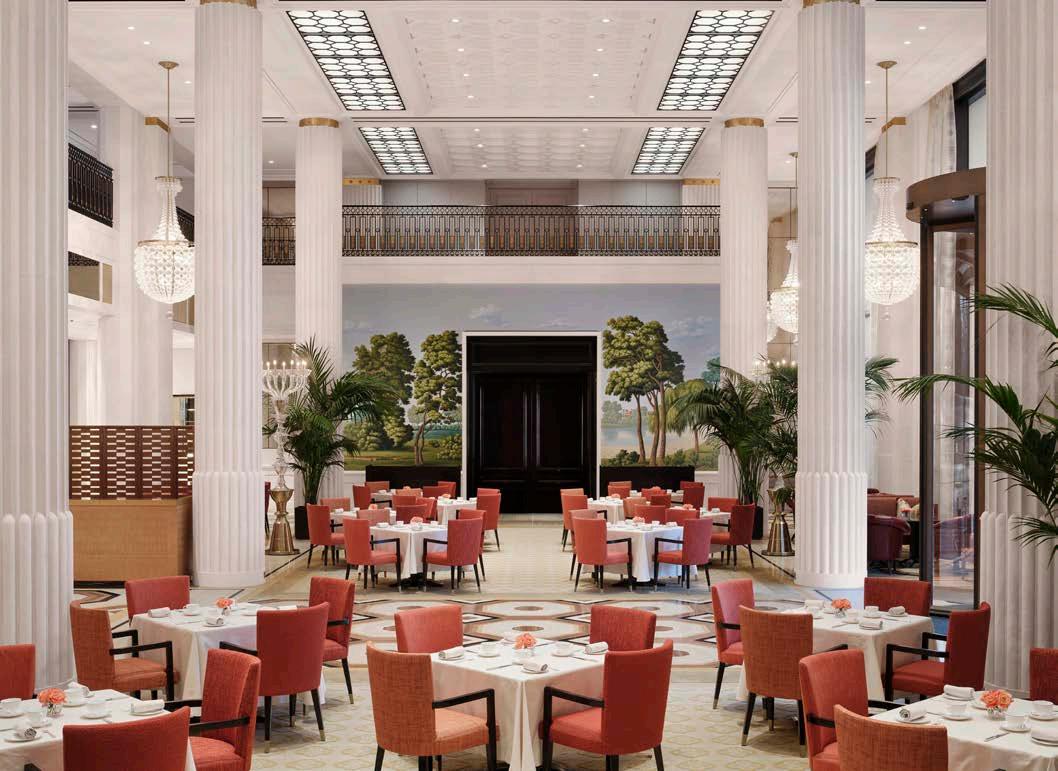
bedroom. The architect’s clients include Dior, Chanel and Ermenegildo Zegna, and his expertise in ‘quiet luxury’ is evident. The room is elegant and polished, but it’s the thoughtful details that impress the most: a drawer in the walk-in wardrobe reveals nail-drying technology – supposedly, the wife of Peninsula owner and Hong Kong billionaire Sir Michael Kadoorie was so often late due to wet nail varnish that he had them installed in all the rooms.
The hidden valet cupboard that staff can access from the corridor allows for contactless room service. Meanwhile, a bureau houses the usual mini fridge and refreshments, as well as a stationery cupboard and printer that’s fully operational. Later, when I switch the bathroom to ‘spa mode’ and I’m gazing up at the honey-onyx tiles, I notice that the veining has been meticulously matched to create a continuous flow of amber lines. I also realise that, despite my proximity to one of the busiest roundabouts in the city, I can’t hear a peep.
Kadoorie’s grandfather founded The Peninsula in Kowloon, Hong Kong, in 1928, and the dynasty’s Asian roots are apparent throughout the London hotel. During construction, seventh-generation feng shui master Lui Chun was flown to the capital
to advise on the energy flow of the building, and again to bless the property upon opening. Elsewhere, landscape architect Enzo Enea placed two 120-year-old Japanese maple trees in the courtyard to signify longevity. Everything here has been built to last 150 years, which also happens to be the length of the hotel’s leasehold from the Grosvenor Estate.
It took 35 years for Kadoorie to settle on the right location for his first London property, and a further seven to develop it. He told Tatler Asia: “I test everything, and believe you me, nine times out of 10 it doesn’t work for me.” I wonder how he’d feel about the fact that the thermostat doesn’t work in my room, rendering it hotter than a July day in Hong Kong. Reception sends an engineer at 1am, but I wonder if Chun’s mastery of energy might be more effective.
The Peninsula owner is, apparently, as obsessed with motoring and aviation as he is with guest experience: he has a pilot’s licence, plus a private collection of classic cars, which includes a 1932 Rolls-Royce Phantom II and a Talbot T150 CSS Pourtout coupé previously owned by racing driver Pierre Boncompagni.
28 LUXURY LONDON THE BRIEFING LUXURYLONDON.CO.UK
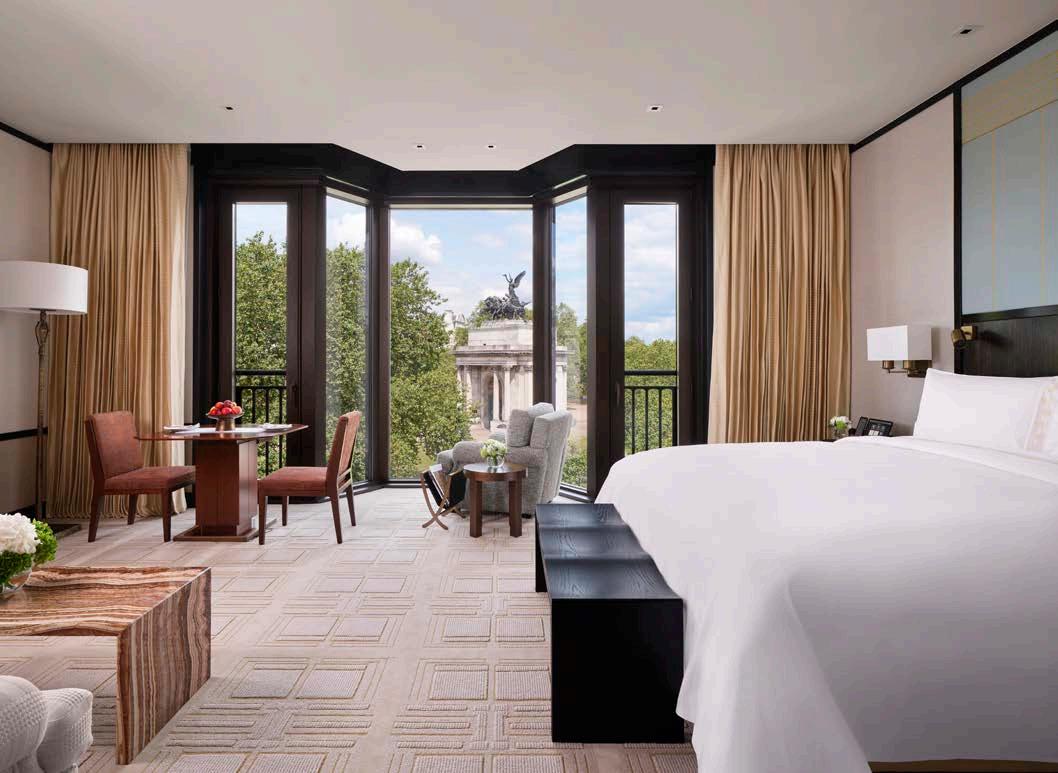
Kadoorie’s passion is part of what makes The Peninsula so much fun – a word not often associated with the stuffiness and snobbery of fivestar institutions. Where else can you arrive for drinks in a wicker-lined lift that looks and sounds like a hot air balloon? Or recline in your chair –upholstered in white leather, just like a Rolls Royce – and pull a lever to signal to the bartender that drinks are running low?
In 1935, English racing driver John Cobb broke the lap record at Brooklands Race Course in a Napier Railton – he later compared driving the car to “seeing how far you could lean out of a ninth-storey window without falling out”. Now, the very same silver bullet of a vehicle is parked in the lobby of The Peninsula. The hotel’s restaurant and bar, Brooklands, is named after the Surrey racecourse, and the restaurant is designed to celebrate Concorde.
In the bar, the motoring theme feels light-hearted and original, but in the eighth floor restaurant, the aircraft-inspired interiors seem rather clinical and cold. But, with chef Claude Bosi at the helm, dining is an elevated experience (both literally and figuratively). Emphasis is on championing British
ingredients, exemplified in a delicate dessert that riffs on all things apple and manages to be cidersweet, comforting like crumble, crisp as the first bite of a Pink Lady and cinnamon-laced like the strudels of my childhood. Simultaneously new and nostalgic.
Downstairs, Chef Dicky To heads up the kitchen at Canton Blue, a reverential homage to Chinese cuisine: both the menu and Henry Leung’s interiors were inspired by the spice routes taken by 19th-century trading ship, Keying. While the hotel as a whole feels like a fusion of Asian and British hospitality, style and craftsmanship, the restaurants stick to their relative geographical spheres; one a transportative experience of Chinese cuisine and culture, and the other quintessentially British in its eccentricity.
The restaurants came to represent my experience of The Peninsula: a meal at Brooklands is a little like taking The Pen for a test drive – a thrilling experience that leaves you wanting to stay inside much longer. If you can’t justify the cost of an overnight stay, visit for the food, which is where this hotel races ahead.
From £1,100 per night, peninsula.com
29 LUXURY LONDON THE BRIEFING LUXURYLONDON.CO.UK
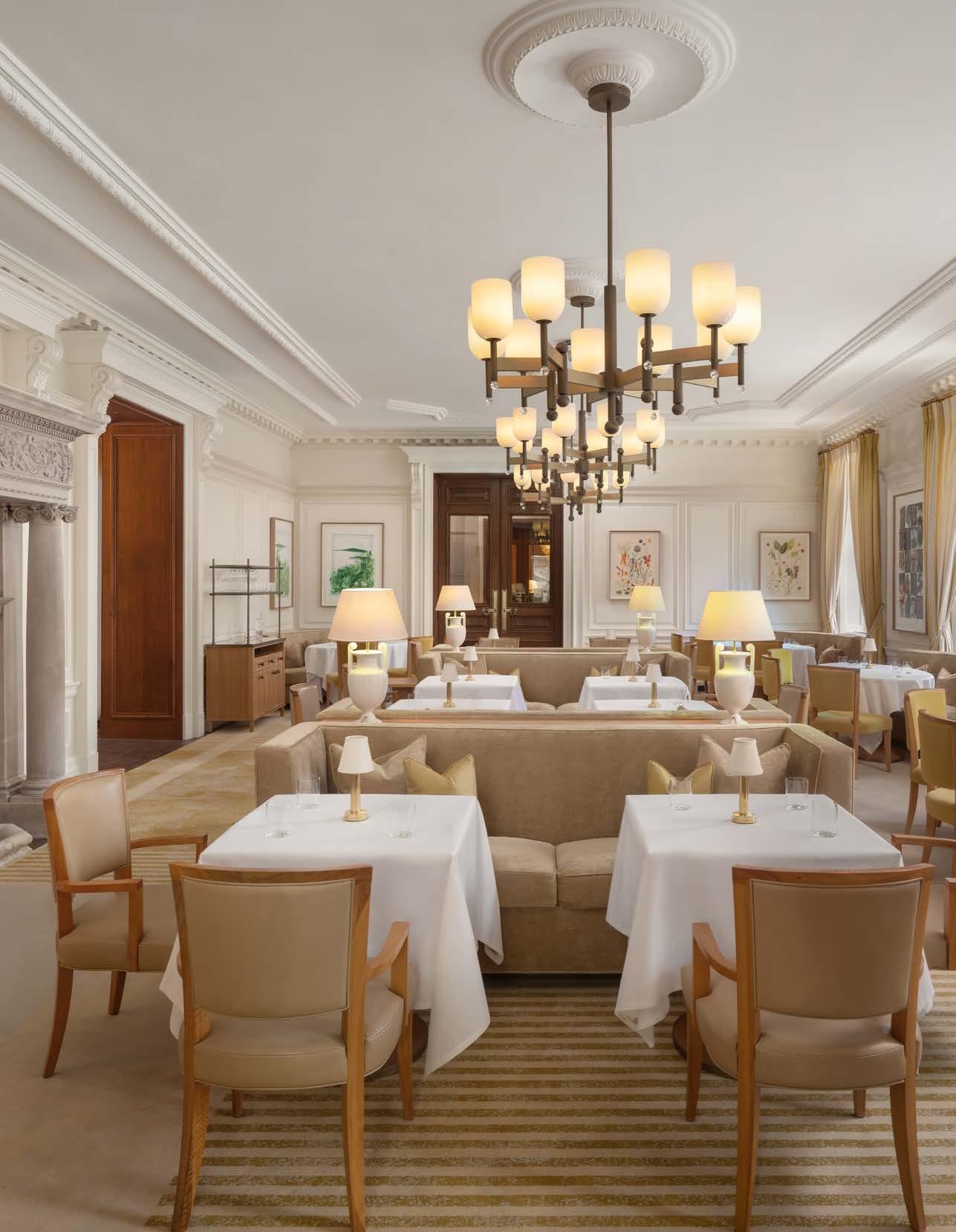

THE RESTAURANT
Mauro Colagreco at Raffles London
MAURO COLAGRECO’S REPUTATION PRECEDES HIM. DOES HIS NEW RAFFLES RESTAURANT LIVE UP TO EXPECTATIONS?
Words: Richard Brown
The Evening Standard described the curtain raising of Raffles London, which launched inside The Old War Office building in Whitehall at the end of September, as ‘the opening of the century.’
Condé Nast Traveller added a caveat: ‘The London hotel opening of the 21st century,’ said the glossy travel monthly. Subeditors at the Financial Times were happy to continue the centennial, and wholly arbitrary, theme. ‘The biggest hotel launch in a century,’ declared the business broadsheet of Raffles’ first UK digs. Click-baity ring to it, I guess.
Traveller claimed that it was the first publication to be allowed inside the sprawling, Grade II-listed former British Army headquarters, now simply known as The OWO. So did the FT. Codswallop.
’Twas Luxury London that first got its foot through the door. It was my foot.
Last summer, we were looking for somewhere sparkly and new to shoot some sparkly and new
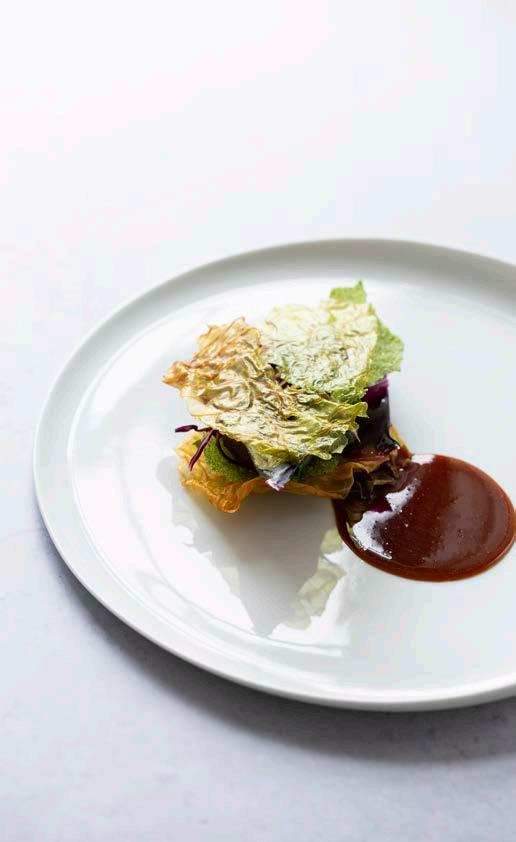
watches and jewellery. We knew that Raffles was about to become big news – the opening of the century, in case you hadn’t heard – so we spoke to an insider who pulled some strings which led to a form that said we could go inside on the proviso we didn’t smash anything (no easy feat with a production headcount of 16 and a Muse gigs’ worth of lighting equipment).
We were given free rein of a two-bedroom apartment. It was on sale for £8 million (half of Raffles is a 120-room hotel; the other half is divided into 85 private residences, one of which has reportedly been snapped up by Michael Bloomberg, the former New York City mayor). We didn’t stay the night, granted, but we did get a look through the keyhole.
Two things struck. The sheer pomp and circumstance of the pile the Hinduja Group had inherited (originally opened in 1906). And the colossal amount of dosh the Indian mega-
31 LUXURY LONDON THE BRIEFING LUXURYLONDON.CO.UK
04
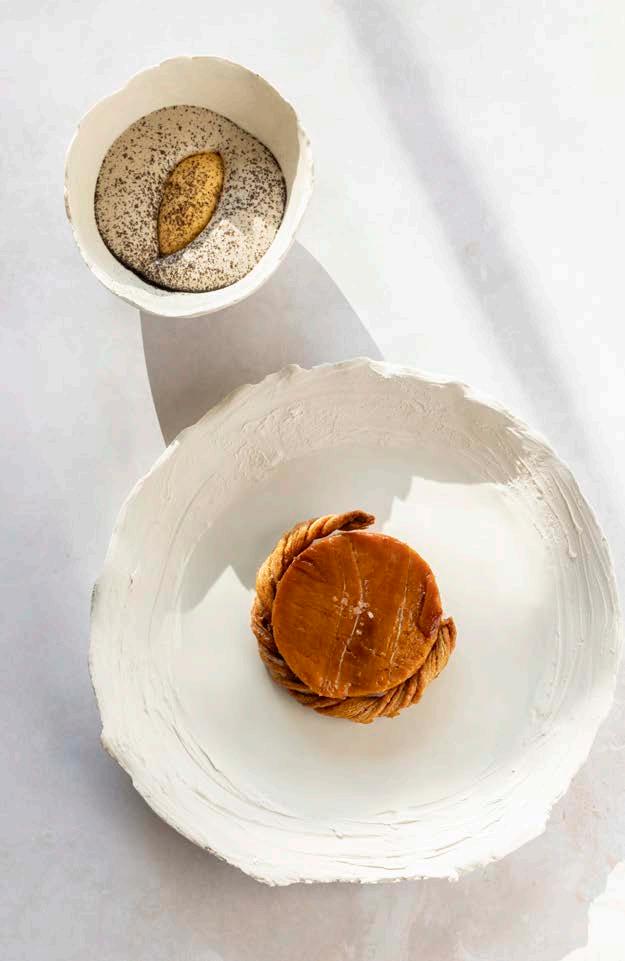
company had spent tarting the place up (£1.4 billion, purportedly). Behind the vast Portland stone façade is a warren of elaborate mosaic floors, stonking period features, immense plasterwork, chandeliers the size of people-carriers and universes of marble.
Since the Evening Standard, FT and Condé Nast Traveller trailed us through the door, plenty of other people have followed. The scores are in, and, for the most part, they are high. About ‘Mauro Colagreco at Raffles London’ – the flagship restaurant of the hotel of the century – however, everyone seems to be saying the same thing. It’s all very nice, they say, but – to paraphrase – a little bit, well, meh
Which is fair to assume probably wasn’t the reception Mauro Colagreco was hoping for.
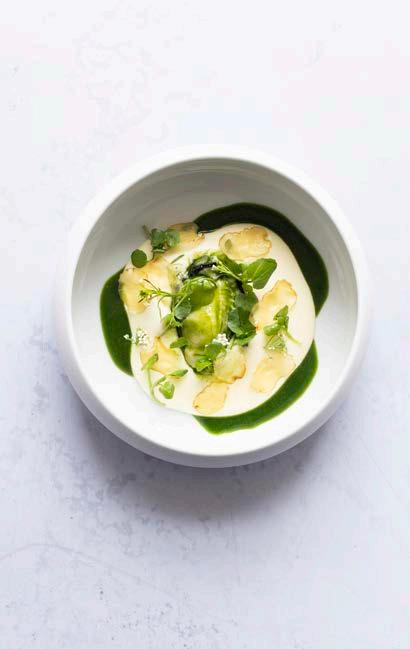
Or what Raffles was expecting when it invited the three-Michelin-star wonder-cook, UNESCO goodwill ambassador, and head chef behind 2019’s ‘World’s Best Restaurant’ (Mirazur in Menton) to head up its culinary proposition.
Colagreco had been a coup. On the international hospitality circuit, the garlanded Argentinean is hot property. To distil a distinguished résumé into two paragraphs: after dropping out of an economics degree in Buenos Aires, a 20-year-old Colagreco hotfooted it to France to study at the prestigious Lycée Hôtelier de La Rochelle cookery school. Then to Paris, and tenures under Alain Passard at the rarefied L’Arpège and Alain Ducasse at the legendary Hôtel Plaza Athénée. Colagreco opened Mirazur in 2006, aged just 29. It took all of nine months to achieve his first Michelin star.
The second arrived in 2012; the third in 2019, making Colagreco the first non-native to be awarded three Michelin stars in France. It was in that year that Mirazur was named the World’s Best Restaurant, having placed 3rd in 2018 and 4th in 2017. In 2022, UNESCO named Colagreco as its first goodwill ambassador for biodiversity. If, at the tail-end of 2022, you were looking for a zeitgeist-y super-chef to spearhead the gastronomic gamut of a zeitgeist-y new superhotel, few names would have topped ‘Colagreco’.
Mauro Colagreco at Raffles London is not a vegetarian restaurant, although you could be
32 LUXURY LONDON THE BRIEFING LUXURYLONDON.CO.UK
forgiven for thinking so from skim-reading the menu. Colagreco has a long history of making vegetables the heroes of his dishes (hence the UNESCO gig). His time at L’Arpège coincided with Passard’s efforts to revolutionise French cooking by putting vegetables first. It was a philosophy that Colagreco carried with him to Mirazur, where meat and fish play second fiddle to fruit and veg. At that sun-drenched Riviera restaurant, Colagreco has five wild gardens from which to pick his ingredients. In London, he sources his greens from a hydroponic farm in Elephant and Castle.
To the meat and gravy, then. Or, in this case, the lettuce and cabbage. Choose between a five-course tasting menu (£165), a three-course à la carte menu (£110), or a three-course set lunch menu (£60). Pair with wine for an extra £125, or £500 if you’ve got pockets deep enough to go top shelf.
The dining room itself – hushed, deferential, deep-pile – is a Georgian love letter to Vitruvius’ theories on order and principle. A symmetrical, beige-on-taupe-on-mushroom mood-board that could inspire a million Pinterest pages. There’s frieze work to make the Royal Albert Hall jealous. And a fireplace large enough to seat a symphony orchestra (which might provide a welcome departure from the dreary, low-beat background music).
Bookended by painstakingly put-together amuse-bouches and petit fours so decadent they could send a diabetic into a hyperosmolar coma, main-event dishes are visual works of art, each arriving on a plate that looks like it belongs in New York’s Museum of Modern Art. Named after their hero fruit or vegetable, the ‘Pear’ dish was actually a faultlessly-done duck breast with spiced wine, Bordelaise sauce and a ribbon of pear on top. ‘Squash’ was a knockout curried chicken on a bed of squash noodles. ‘Lettuce’ was flaky smoked haddock smothered in a vermouth cockle sauce and served with a warm-but-raw red oak lettuce. Everything tastes as fresh and crisp as packed snow, as if it were scootered over from Elephant and Castle that very morning (it may well have been).
And yet, despite the stateliness of the surroundings, the deftness of the dishes, the museum-worthiness of the crockery and the glitziness of the hotel in which it sits, somehow Mauro Colagreco at Raffles manages to feel less than the sum of its parts. The room is something from Architectural Digest, but not necessarily the most suitable of spaces for sociable get-togethers. It certainly doesn’t encourage intimacy. The food is beautiful and intricate and no doubt put together with tweezers and pipettes. But it’s not lip-smackingly delicious. And at these prices, you
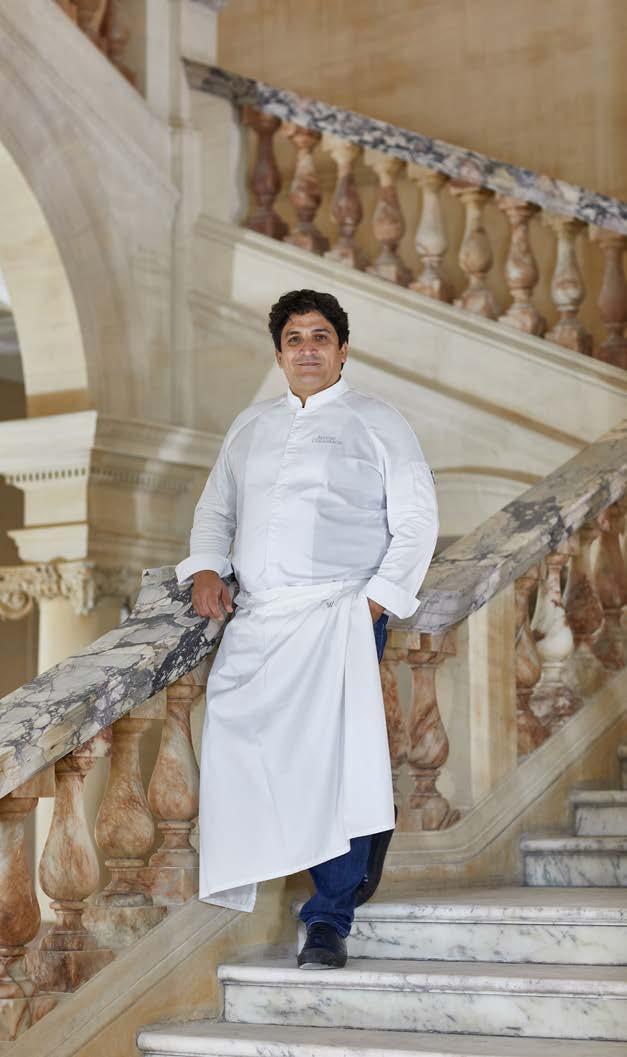
want something to write home about. It’s all very nice, but, well, a little bit meh Observer magazine was more restrained in its coverage of the hotel’s opening. It steered clear of century-related superlatives and simply described Raffles as ‘one of London’s most notable openings of the year.’ It’s headline: ‘Mauro Colagreco Is Ready to Disrupt the London Dining Scene.’
So far, the starry Argentinian is yet to cause the faintest of ripples.
Raffles London at The OWO, Old War Office Building, 57 Whitehall, SW1, raffles.com
33 LUXURY LONDON THE BRIEFING LUXURYLONDON.CO.UK
THE SUBMERSIBLE
Migaloo M5
A $2 BILLION SUPERYACHT PROMISES TO TAKE GUESTS UNDER WATER FOR UP TO FOUR WEEKS AT A TIME
Words: Anna Solomon
Have you ever been sitting on your superyacht and thought ‘this is all very nice and everything, but I really wish we could go under water’? No? Oh. Well, you could, if you wanted to. With Migaloo’s new M5 submersible.
The Austrian firm recently floated (wahey) the concept of a superyacht that doubles as a submersible – the first of its kind. The Migaloo M5 would be 544 feet long, and would be able to accommodate 20 guests and 40 crew. It would have a range of more than 9,300 miles, top speeds of up to 20 knots
while surfaced and 12 under water, and be able to function in all conditions, from the Tropics to the Arctic.
Stretching across 1,000 square metres, the styling of the seacraft would be customisable, to be worked out with a prospective owner (don’t you hate it when you spend 10 figures on a submersible and the walls are the wrong shade of white?). Plans for the M5 include all the amenities of a typical luxury superyacht, including a 36-seater dining room with glass walls, a wine cellar, a cinema, two swimming pools, and a jacuzzi. It would also come with two ‘midget submarines’ for further exploration, a 12.5m tender, and a collection of water toys. Oh, and a helipad. No superyacht is complete without a helipad.
At more than twice the cost of the world’s most expensive yacht (Lürssen’s $800 million Dilbar), not even two thirds of the world’s billionaires are worth as much as this vessel, never mind having the cash to splash on it. Which leads to the question, why?
It’s all about innovation, apparently. Migaloo CEO, Christian Gumpold, told Boat International that he believes that submersible superyachts will play an important role in the future, predicting that they will become “an additional category of private vessels that owners can choose from”. The first-ever motoryacht was a concept too, once. migaloo-submarines.com

34 LUXURY LONDON THE BRIEFING LUXURYLONDON.CO.UK
05
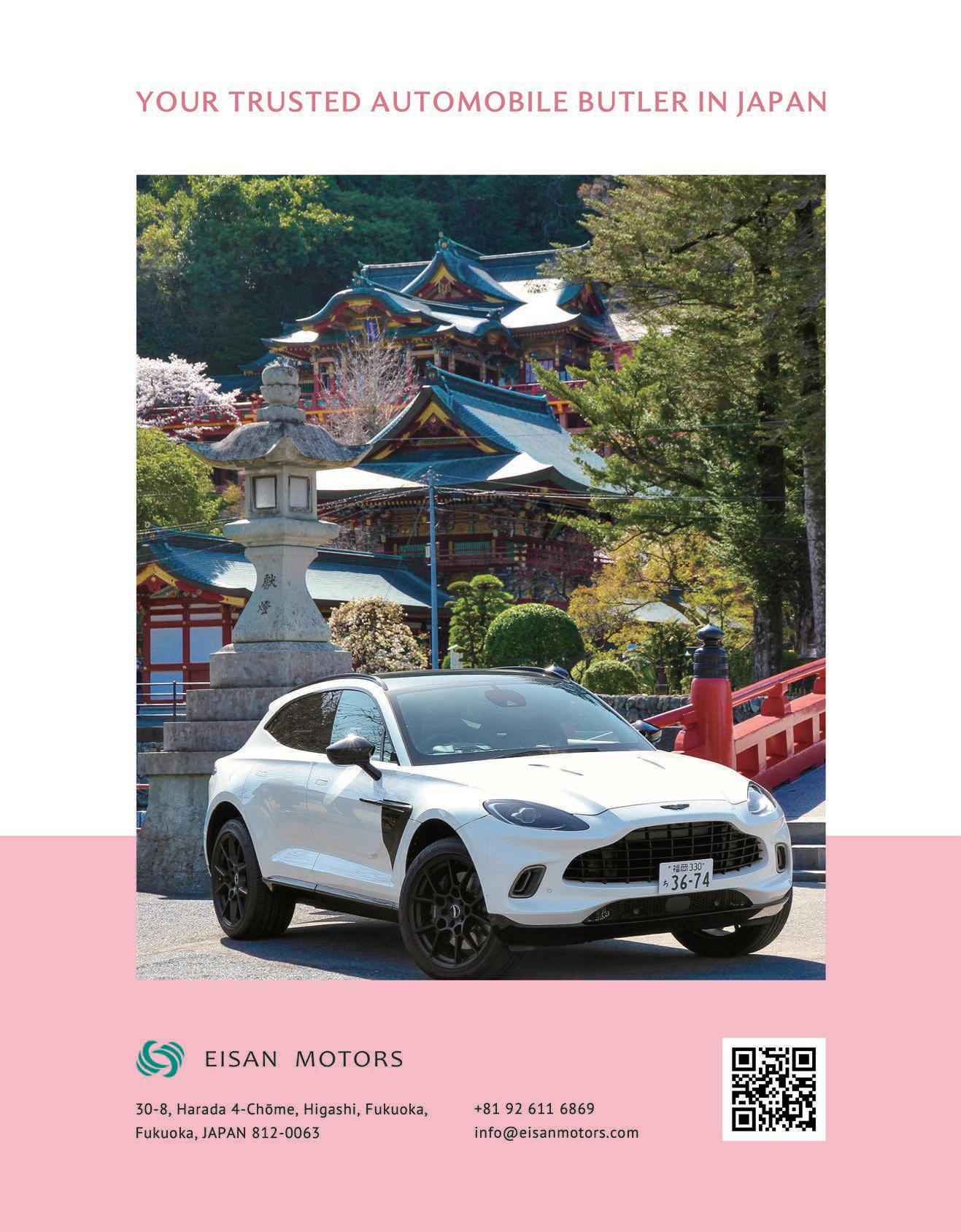

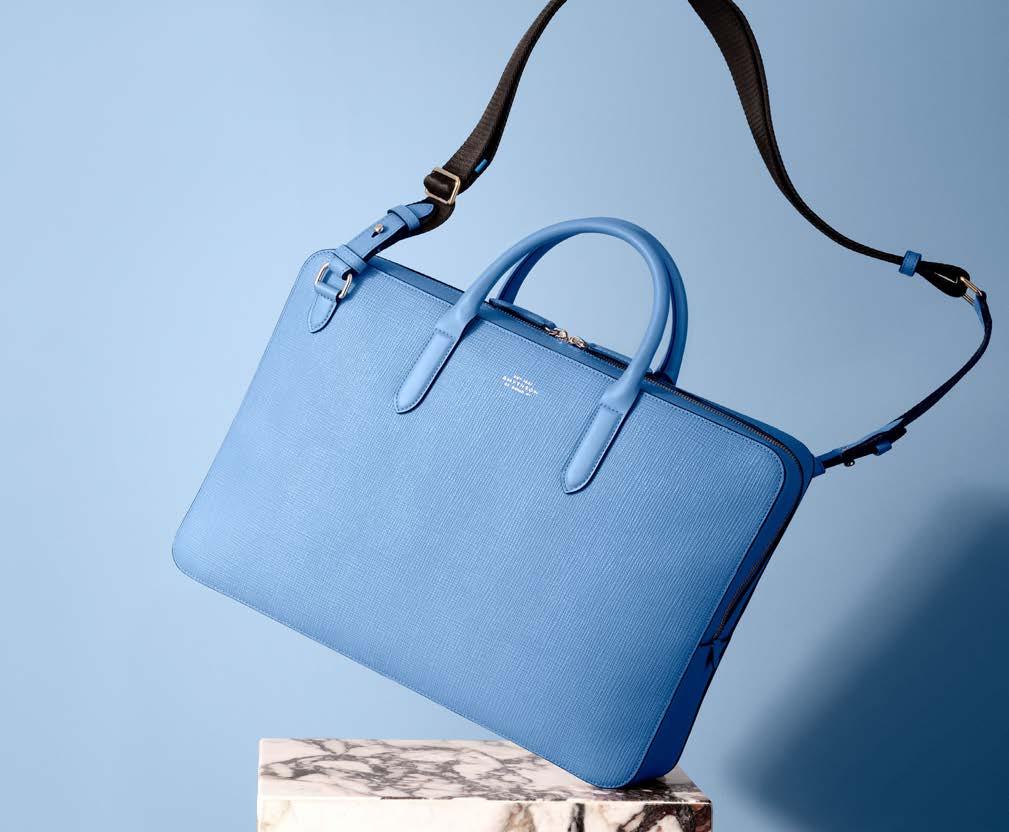
FOR DAYS LESS EVERYDAY SMYTHSON.COM

THE WORLD ACCORDING TO THE PEOPLE SHAPING IT Interviews 38 Marije Vogelzang On the future of food 42 Alison Jacques The contemporary art gallerist taking on overlooked talent 48 Lucien Laviscount From jobbing actor to the apple of Hollywood’s eye 54 Bernie Gallagher Stamps her mark on the London hotel scene LONDON GALLERIST ALISON JACQUES IS HOPING TO STEER THE FUTURE OF ART BY CHAMPIONING UNDER-ACKNOWLEDGED ARTISTS OF THE PAST, P.42

NICK HELDERMAN
Food for Thought
MARIJE VOGELZANG IS NOT A CHEF. SHE IS ONE OF A NEW GENERATION OF ‘FOOD DESIGNERS’. BECAUSE, JUST AS MUCH AS A CHAIR OR A CAR, FOOD NEEDS TO BE DESIGNED. INDEED, SOME 50 PER CENT OF THE MASS-MARKET FOOD PRODUCTS WE CONSUME TODAY WERE UNKNOWN JUST FIVE YEARS AGO.
WELCOME TO THE PIONEERING NEW WORLD OF FOOD DESIGN
Words: Josh Sims
Marije Vogelzang remembers her first experiment in food design. When she was eight, her parents charged her with the task of making some cheesy canapés for a dinner party. She made sure each one looked different. “To me it wasn’t so much about how they tasted,” says Vogelzang, who published her first book, Eat Love, in 2008. “I was more fascinated by who would pick which canapé – how the guests would behave in response to food.”
Vogelzang is, arguably, the pioneer of a rapidlygrowing new design discipline. In 2015 she founded the Dutch Institute of Food and Design – a global platform for designers working with a material that not only engages all our senses, but which enters our body to become part of it. In some ways, Vogelzang points out, many foods have been designed through cultivation and breeding.
“A banana has been ‘designed’,” she says, “it never used to be yellow and sweet like that. Vogelzang’s aim is to explore, develop, change and create within the world of food – to challenge the food system, and to inspire new creatives focusing on food and living matter.
Vogelzang’s first exhibition, 1999’s White Funeral, invited visitors to recognise how “all food comes from death”. Other projects of hers have asked us to develop a new appreciation for the sensory qualities of foods and drinks we tend to think of as bland – tap water, for example. Others have encouraged participants to become hyperaware of the density of nerve endings in their lips, offering feedback we typically bypass through using cutlery.
“Health issues, climate change, pollinator decline, the use of pesticides and food waste – to name just a few – they all need creative thinking.
39 LUXURY LONDON INTERVIEWS LUXURYLONDON.CO.UK
I’m not saying that creative thinking can solve it all but it can certainly provide alternatives.”
Vogelzang once dyed cubes of different vegetable matter black, before stimulating her test subjects’ olfactory sense while they ate them. How did colour – or the lack thereof – shape our perception of food? Could a synesthetic response be prompted?
The Amsterdam-based artist-designer has asked whether the aroma of a certain historic period can be captured by baking it into bread and then releasing it elsewhere? She has also pondered the kind of pressing food issues of which we’re more acutely aware: can food itself be designed to prevent overeating? How can we get kids to eat more vegetables? (By making it fun, is Vogelzang’s answer.)
Vogelzang is not, then, a designer of food in the same way a chef might be. It’s more a provocative blend of psychology, philosophy, performance, experimentation and art, all through the medium of things we eat.
“When I started out people didn’t get it. People told me I had no reason to work with food, that was just for housewives and chefs. But I loved the sensorial quality of food, its relationship to our bodies; that it’s both banal, because it’s something we all consume, and yet incredibly complex. A potato is just a potato looked at one way. Look at it in another way, and it’s about landscape, politics, history, culture.”
Vogelzang argues that understanding how we interact with food – “eating design” rather than simply “food design” – really matters. “Design has traditionally been about making things that don’t disintegrate – people think ‘design’ and then ‘expensive chair’. But that mindset is changing among younger designers now. They’re more interested in organic materials of all kinds – they appreciate that their transience is the beauty of them. We all eat food every day. So it’s incredible how underexplored the potential of food design has been so far.”
That Vogelzang started working with food came about as a combination of kicking against her experience – “we never really ate anything exotic at home, and while my mum cooked she never really liked it, so maybe it was some kind of lack that inspired me” – and having the right mentor at the Netherlands’ prestigious art institution, the Design Academy Eindhoven.
It was there that the chair – and legendary trend forecaster – Lidewij Edelkoort encouraged Vogelzang to explore this strange, new tangent. It was a bold decision. There were no reference points. No established canon of work. But, says Vogelzang, being unconstrained by tradition made the prospect even more exhilarating.
“I don’t think anyone back then thought that food design would become a new discipline, and I did feel insecure about it. But it has turned out to be fascinating – less for the aesthetics, and more as to how the way we think about food shapes how we experience it.”
In 2022, Vogelzang published her most recent book, Lick It. Over the course of 32 unique food challenges, and 22 chapters of alternate angles, the book sets out to examine everything from food politics and sex to hunger and queer food. “For many of us, food is plentiful, so we don’t really think about it at all,” she says. “Yet we all have a mouth and brain and my aim is to connect them; to combine the act of eating with imagination, with fantasy. I think if that connection was there, we would value food much more.”
Vogelzang’s work often resonates long after its initial unveiling. Her Faked Meat project of 2016, for example, questioned why so many new soy- and plant-based foods aim not to provide a distinct alternative to meat but rather to mimic it, in presentation, texture and flavour. In doing so, Vogelzang suggests, we’re presenting new food
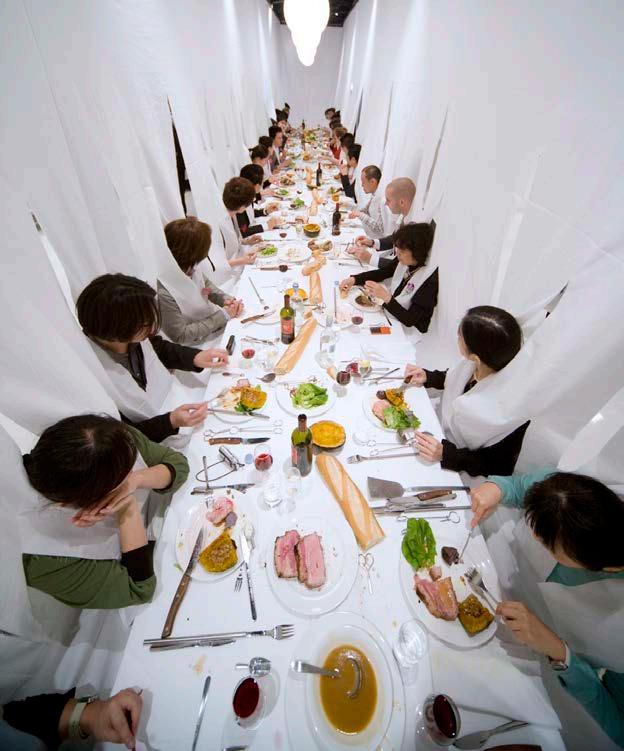
40 LUXURY LONDON INTERVIEWS LUXURYLONDON.CO.UK
A SHARING DINNER, HOSTED BY VOGELZANG ©KENJI MASUNAGA
A SHARING DINNER, HOSTED BY VOGELZANG ©FRED ERNST

products as inferior. She proposed vegetarian foods that derived from their own fictional animals.
“That project got some negative reactions. ‘Who would be interested in that?!’,” she recalls some asking. “But with increased vegetarianism a lot of people are more interested [in the ideas it proposed]. I think sometimes people have to be primed to have a discussion about some issues.”
To this end, one recent project was run in conjunction with one of the largest poultry farmers in the Netherlands, asking whether it is ethical to industrially farm chickens. This has involved setting up a pop-up ‘Eggs-change’ where people are gifted a fertilised egg. It is, Vogelzang explains, a way of challenging the way we think about eggs. Do we take the egg at face value, or think about the value of what will happen if we let it hatch?
“When I said I was working with industrial poultry farmers, a lot of my friends said I was working with the devil,” laughs Vogelzang. “But that’s a useless response. If you take that attitude you never change anything. You have to be curious and not get lost in some political agenda – and food can get very politicised.”
Vogelzang sees the same disconnection in the global corporations that produce so much of the supermarket foods we consume, including in her own clients, which include Nestle and Procter & Gamble. “They’re an important part of the whole world of food,” she says, “and, of course, there’s room for improvement in all sorts of ways – making
“You have to be curious and not get lost in some political agenda –and food can get very politicised”
foods healthier, less environmentally impactful, dealing with the raw resources better, and so on – but what they should really be doing is thinking less about products and more about people.”
It is, arguably, in Vogelzang’s intimate and often revelatory gatherings that her work most resonates. Guests are invited to explore aspects of food consumption they haven’t considered, often leaving perplexed as to why they haven’t previously. Take, for example, those who attended a Burns supper that Vogelzang devised for the whisky company, Glenmorangie. Broth and haggis was served in an edible bowl; three kinds of fish were presented in hollowed out chicken’s eggs, each rubber stamped with the first letter of its contents; and cheese came as though it were painted onto an art palette.
Should you ever receive a dinner invitation from Vogelzang, be sure to accept. Chances are, you’ll never look at food in the same way again.
41 LUXURYLONDON.CO.UK

SOPHIE DAVIDSON
State of the Art
IT’S RARE TO FIND A GALLERIST THAT COURTS MODERATELYSUCCESSFUL ARTISTS IN THE TWILIGHT OF THEIR CAREERS.
YET ALISON JACQUES HAS A UNIQUE EYE FOR TALENT THAT OTHERS HAVE OVERLOOKED. HERE, THE LONDON GALLERY OWNER EXPLAINS WHY SHE’LL ALWAYS CHAMPION THE UNDERDOG
Words: Anna Solomon
Alison Jacques believes the future is female. And elderly. The Financial Times even dubbed her ‘the queen of old ladies’. The gallerist can be credited with invigorating the careers of numerous older women, including Brazilian painter Lygia Clark, American artist Sheila Hicks and Slovakian sculptor Mária Bartuszová; she has made a name for herself providing artists with new-found notoriety later on in life, or even posthumously. Think of it as backdating acclaim to make up for historical inequalities in the art world.
You’ve likely heard of American surrealist painter Dorothea Tanning, for example. But, I think it would be fair to say, you might not have had Jacques not gotten in touch with Tanning after spotting a forgotten artwork of hers in The Metropolitan Museum of Modern Art. That was back in 2010, and Tanning was already a centenarian. Indeed, if it were not for Jacques’ determination to exhibit Tanning, she may have spent posterity being defined by the proximity to her husband, German painter Max Ernst.
Thanks to Jacques, Clark, Hicks and Bartuszová have enjoyed major international shows. Arguably Jacques’ greatest achievement, however, is promoting the lesser-known works of American photographer Robert Mapplethorpe, who rose to prominence during the 1980s before his untimely death due to complications from HIV/AIDs in
1989. She has been looking after Mapplethorpe’s estate since 1999.
Jacques’ foray into the art world came via a postgraduate curating course in Prato, Italy, which included a placement at the Kunstverein Düsseldorf. She then worked as an art journalist; during an interview with dealer Leslie Waddington, he offered her a job at his Cork Street gallery. Jacques’ first client was collector Charles Asprey, whom she met at an opening; the pair later joined forces and, in 1998, opened the Asprey Jacques gallery – a venture that ran until Jacques struck out on her own in 2004. On the day that her eponymous space opened in a townhouse off Bond Street, collectors Charles Saatchi and Jerry Speyer stopped by to proffer their support.
In 2007, the Alison Jacques gallery relocated to Berners Street in Fitzrovia. It was around this time that Jacques began carving out her niche: she was keen to exhibit American performance artist and sculptor Hannah Wilke, who created work exploring sexuality and femininity throughout the 1970s – but it wasn’t until the end of her life, when Wilkes documented herself dying from lymphoma, that people really began paying attention.
Jacques wanted to platform Wilke, even retroactively. The gallery held an exhibition of her work, and the Tate bought a piece; the institution would later purchase Wilke’s largest installation, and her pieces can now fetch close to £1 million.
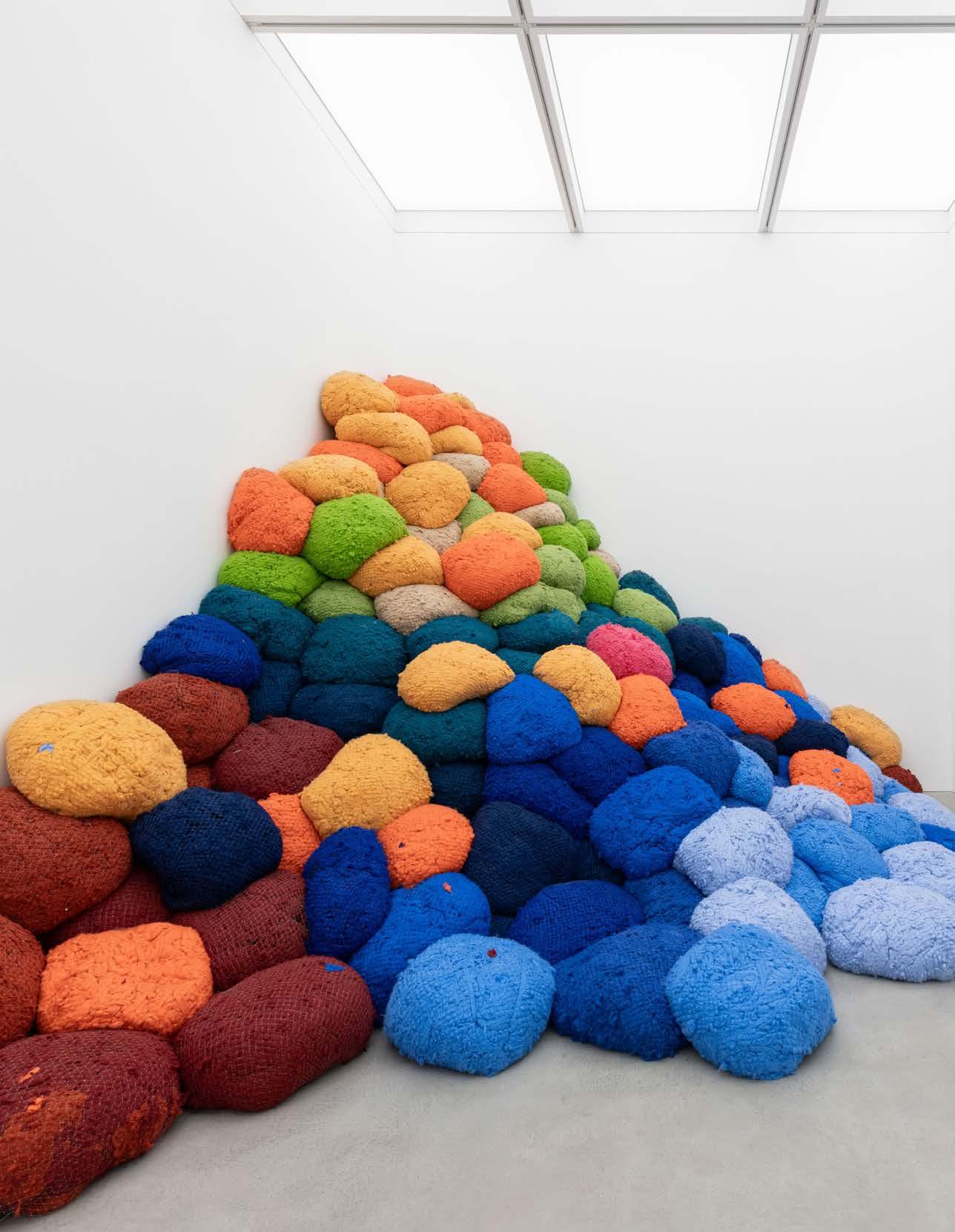
SHEILA HICKS, INFINITE POTENTIAL, 2023. COURTESY ALISON JACQUES, LONDON ©SHEILA HICKS. PHOTO: MICHAEL BRZEZINSKI

Last year, Jacques moved her gallery again, this time to a three-story space on Cork Street, a stone’s throw from where she worked with Waddington. She did so with a renewed pledge to “discover or rediscover artists who haven’t had their dues”, as well as a promise to start taking on younger artists.
Q A Why do you believe it so important to draw attention to older female artists, or to platform them posthumously?
I have not deliberately chosen these artists, but I am committed to championing the work of those who were under-acknowledged during their lifetime. Many of them are women. Prior to 2000, it was a white, male-dominated art world. Mediocre work by male artists was often shown at the expense of female artists, whose work has now finally become acknowledged by museums. These female artists were previously left in the shadows, along with many great artists of colour. Thank God, in the art world, the pendulum has finally swung.
Q A Can you explain your process for discovering artists, and your criteria for representing them?
I look and I feel. It’s a gut feeling, and a belief in the importance and possibility of an artist’s presence in the world, and my need to share their voice with others.
I am passionate about creating museum opportunities for my artists. Over the years, curators have seen my exhibitions, and the resulting museum shows are a particular source of pride for me, from Dorothea Tanning and Mária Bartuszová retrospectives at Tate Modern, to Lygia Clark at MoMA, and her forthcoming solo show at the Whitechapel in London. This will be followed by a comprehensive European retrospective at the Neue Nationalgalerie, Berlin, in 2025.
This year, we have a survey show of our artist Nicola L. at Camden Arts Centre during Frieze week. I always encourage museums to exhibit our artists.
Q A You work with the estate of Robert Mapplethorpe. How would you describe his contribution to art photography?
Mapplethorpe should be seen as nothing less than one of the most groundbreaking photographers of the 20th century. He was a pioneer and trailblazer, fearless to make art that was beautiful and shocking. He paved the way for what a lot of artists have subsequently been able to do by challenging conservatism and censorship.
In our recent exhibition, which marks 24 years of my collaboration with the Robert Mapplethorpe Foundation, there were many images that had not previously been widely exhibited, proving that there is still something new to be seen despite Mapplethorpe’s death 34 years ago.
45 LUXURY LONDON INTERVIEWS LUXURYLONDON.CO.UK
SHEILA HICKS, TALKING STICKS, 2021-2023.
COURTESY ALISON JACQUES, LONDON
©SHEILA HICKS. PHOTO: MICHAEL BRZEZINSKI


Past Mapplethorpe shows that I have staged have been curated by David Hockney, the Scissor Sisters and Patti Smith, and have included littleknown aspects of Mapplethorpe’s work, such as his Polaroids and sculptures. He was not just a photographer; he was an artist, and remains an integral part of the gallery, as well as having a special place in my heart.
Q A What is your favourite exhibition you’ve ever staged?
I am not sure I can answer that question, as I have curated so many over the past two decades – I tend to dive into each exhibition with a hook-line-
“It was a white, maledominated art world. Mediocre work by male artists was often shown at the expense of women”
and-sinker attitude. A memory fresh in my mind, however, is moving to our new gallery space on Cork Street, Mayfair. To inaugurate the space we held a solo exhibition of works by the legendary 89-year-old artist Sheila Hicks, who I have worked with for the last 12 years.
Sheila created Infinite Potential, a monumental architectural installation for our seven-metre-tall gallery (we removed a concrete ceiling during the renovation to create this incredible height). Sheila’s unique voice set the bar incredibly high for all that is to come.
Q A What provided the inspiration to set up your own space?
I was working in Milan as an editor at Flash Art magazine. With Flash Art, I visited Unfair in Cologne – this is where I first had the idea to start my own gallery. I was inspired by the gallerists I met there, and remember thinking, ‘I’d like to be a part of this’.
I returned to London and worked at Victoria Miro, before being offered a job by Leslie Waddington on Cork Street. I remember sitting at the reception desk and dreaming of opening my own gallery there. Serendipitously, our new space is opposite Waddington. Plus, when we were installing Sheila’s show in October, British artist Ian Davenport was installing his exhibition at Waddington – I was Ian’s artist liaison when I worked there 30 years ago! It was a full circle moment and, as I don’t believe in coincidences, it felt like my new space was meant to be.
Q
A What was the first artwork that you ever sold?
My first sale was at Waddington in 1995 to young British collector Charles Asprey, and he acquired a painting by Ian Davenport. So, my first sale was an Ian Davenport, and Ian was installing his show at the same time as our inaugural exhibition at 22 Cork Street!
Q A Is London the capital of the art world?
I think that Mayfair and St. James’s are the epicentres of the contemporary art world. Hence our new location in the heart of the area, on a street which is rich in gallery history, with legendary
46 LUXURY LONDON INTERVIEWS LUXURYLONDON.CO.UK
ABOVE MONICA SJÖÖ, CORN MOTHER AND CROPCIRCLES AT SILBURY, 1990
BELOW MONICA SJÖÖ, SERPENT POWER ON BODMIN MOOR, 1994

gallerists such as Robert Fraser having trailblazed here in the ’60s. I love the fact that the inspirational Peggy Guggenheim – whose museum in Venice I worked in during the ’90s, and who gave me my lucky break in the art world – had a gallery in the ’30s at 30 Cork Street. Another coincidence…
Q A To what extent are you looking to work with younger artists?
I do work with younger artists. To be honest, the age, gender or background of an artist is completely irrelevant – it’s all about their art.
Q A Which artists, emerging or otherwise, are exciting you at the moment?
Graham Little, who I have worked with for two decades, currently has a survey exhibition open at the FLAG Art Foundation in New York – his first solo presentation in the United States. I also represent young British artist Sophie Barber, who graduated in 2017, and has already had her first solo public space exhibition at Goldsmiths CCA [London], and has a forthcoming solo museum exhibition at Hastings Contemporary.
Q A What should we be looking out for at the Alison Jacques gallery?
We just opened an exhibition of paintings and sculpture by Betty Parsons. Her prowess as founder of the legendary Betty Parsons Gallery has obscured appreciation for her own practice. She gave now-famous artists, including Barnett Newman and Robert Rauschenberg, their first solo

exhibitions, but parallel to this, she was working away on her own art.
My desire to show Betty’s work is driven by a belief that she was a great artist who should be viewed alongside the artists that she discovered. Her painted sculptures, made from driftwood she collected on the beach near her studio, reveal a unique voice that needs to be heard.
I am only sorry that Betty is no longer here to experience the international recognition her work is now receiving.
Alison Jacques, 22 Cork Street, W1S, alisonjacques.com
47 LUXURY LONDON INTERVIEWS LUXURYLONDON.CO.UK
ABOVE MONICA SJÖÖ, THE GODDESS AT CARNAC, 1980 BELOW MONICA SJÖÖ, TRIPPLE CERRIDWEN AT PENTRE IFAN, 1992


Smooth Operator
PRIOR TO THE PANDEMIC, LUCIEN LAVISCOUNT WAS A JOBBING ACTOR CONSTANTLY IN SEARCH OF HIS NEXT PROJECT. THEN CAME NETFLIX SMASH-HIT EMILY IN PARIS AND SUDDENLY THE FORMER SOAP STAR WAS BEING INVITED TO OSCAR PARTIES AND HEARING HIS NAME SWIRLING IN THE JAMES BOND RUMOUR MILL. NOW, HAVING PIQUED THE INTEREST OF HOLLYWOOD PRODUCERS, THE BOY FROM BURNLEY IS LOOKING LIKE TOMORROW’S LEADING MAN
Words: Anna Solomon Photography: Dean Isidro
“Paris is full o’ traffic and overpriced restauran’s and scam ar’is’s, just like any ova big ci’y. It’s selling you somefink dat’s not real,” says Alfie, boyfriend of Emily of Emily in Paris, in an accent so riddled with glottal stops that it prompted The Telegraph to decree season two of the show – in which the titular character moves to France to find its inhabitants chain smoking, croissant eating and witheringly rude – ‘now as offensive to the British as it is to the French’.
London-boy Alfie eats at greasy spoons and calls everyone ‘mate’; they should have had him do a rendition of Chim Chim Cher-ee and called it a day. So I almost do a double take (as far as that’s possible on Zoom) when Lucien Laviscount, who plays Alfie, greets me in a broad northern accent. Not only has the chaffing Dick Van Dyke delivery disappeared, also gone is the character’s razor-edge shave and Photoshop-worthy fade, replaced by an untrimmed beard and slightly shaggy haircut.
Although Laviscount may have been born in Burnley, growing up in nearby Read, the man sitting in front of me is ‘Antigua’ Laviscount – the actor spends “as much time as he can” on the island where his dad was born. He’s currently wearing a pale-grey T-shirt, but ‘Antigua’ Laviscount can often be found sporting a gold chain and harem pants, sans shirt, showcasing insanely chiselled abs (yes, I scrolled back to 2020 on his Instagram to establish this – it’s called research).
“When I’m away working, just having it in the back of my mind that Antigua is ‘home’ is enough to get me through,” says the impossibly symmetrically-faced 31-year-old. “I love to be out here. The culture, the vibe, the energy – it’s just so different from the city and the smoke.”
‘Showbiz’ Laviscount, meanwhile, is exceedingly polished and infinitely debonair. He can be found on the sleb circuit doing slebby things, like being papped at London Fashion Week, or presenting Harry Styles with a BRIT award, or saying “f*** the Tories” on the Oscars red carpet (that was in 2023; he also flipped them the bird).
Laviscount was in a New York restaurant when, in 2021, he got a call from Emily creator Darren Star, letting him know that he’d been cast in the
show – a romantic comedy-drama lauded/derided by critics for its brand of OTT silliness that draws you in until you’re powerless to do anything other than watch the whole series back-to-back as your neurons perish. He’d met Star for the first time over Zoom just 36 hours earlier.
“I bolted out of my seat and ran out of the restaurant into the middle of the road. I think my friends were a bit spooked – they didn’t know if I was happy, or going to be violently sick.”
Laviscount had been in the game long enough to know that being cast in Emily in Paris – viewed by 58 million households in the month of its debut; a UK top 10 series for 40 consecutive days – had the potential to turbocharge his career, and change his life. He was introduced to the industry aged just 10, when he was stopped in the street while shopping with his mum and asked to be in a Marks & Spencer advert. The campaign featured David Beckham, who, unexpectedly, Laviscount credits for helping kick-start his acting career: “David comes over and he says, ‘Hey Lucien, you’re a funny lad – you should get into acting’. And he gets an assistant to call an acting school in Manchester, and they got in touch with my mum. That’s how I started,” Laviscount told Grazia in 2021.
The Lancashire lad landed his first major role in school television drama Grange Hill in 2007, before appearing in more than 30 episodes of Coronation Street and 18 episodes of Waterloo Road In 2011, a 19-year-old Laviscount competed in Celebrity Big Brother, where he struck up an unlikely romance with 31-year-old former-Atomic Kitten singer Kerry Katona. A low-budget OK! couples shoot – titled ‘Lucien & Kerry: It’s Love’ – followed. Laviscount has since been linked with singers Kelly Osbourne, Leigh-Anne Pinnock and Jesy Nelson, as well as American actress Keke Palmer.
Roles in slasher comedy Scream Queens (2015) and crime drama series Snatch (2017) followed, but it was the Emily gig that broadcast those chiselled cheekbones to a global audience. So, just how has life changed for the former tabloid favourite?
“To be honest,” says Laviscount, with an anticlimactic pause, “it hasn’t, really. The job offers do seem to come in more frequently these days,
50 LUXURY LONDON INTERVIEWS LUXURYLONDON.CO.UK
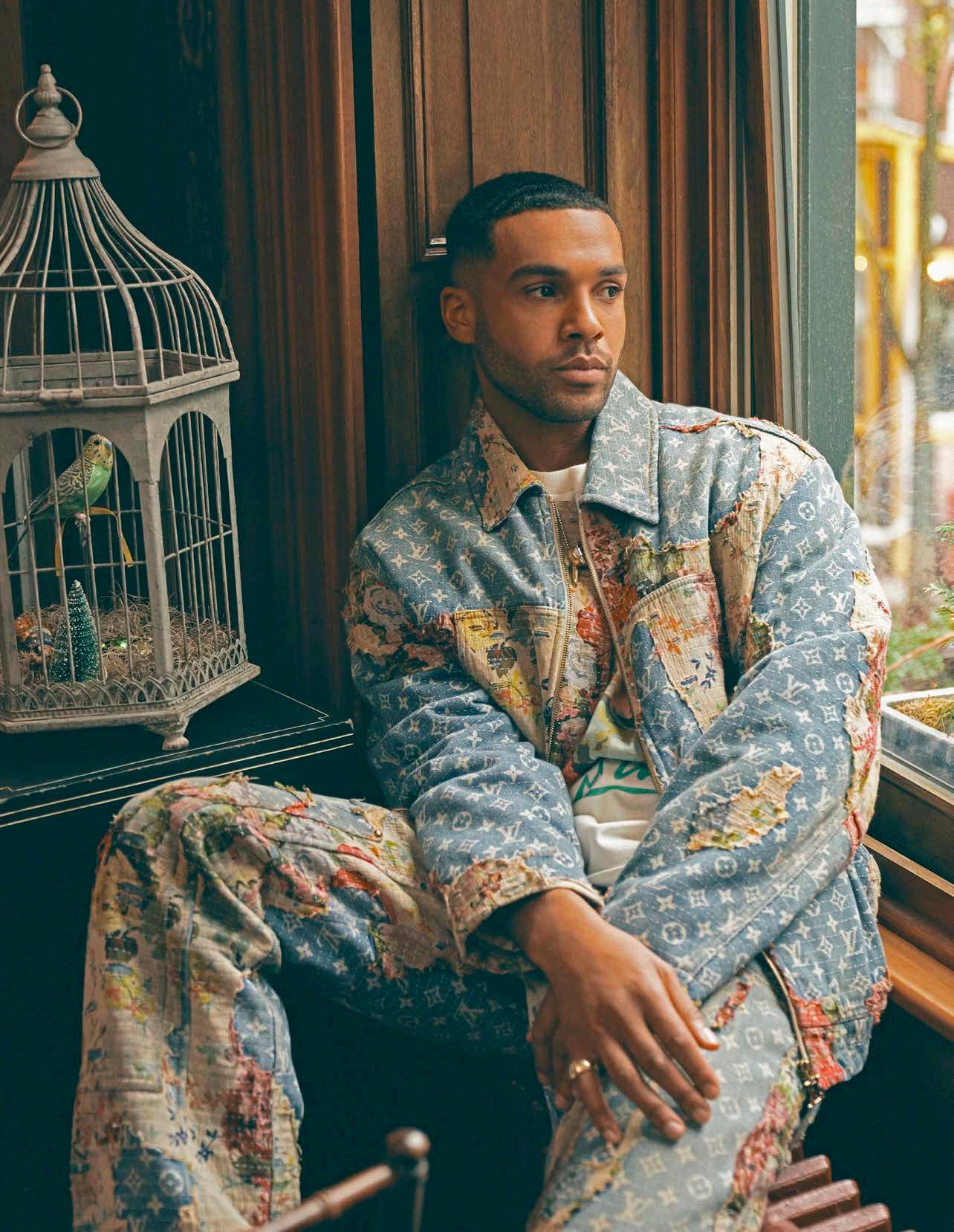


though. Being on a show like Emily gives you a platform to be able to make more decisions about your career. To be able to be on a show that so many people watch, and receive so well… I’m just counting my blessings.”
Next up is a big-budget rom-com called This Time Next Year – directed by the principal of the genre, Mr Nick Moore (Love Actually, Notting Hill). And then there’s the rumour that just won’t go away. The name’s Laviscount, Lucien Laviscount. It’d make sense; he is British, after all. And the right age – producer Barbara Broccoli has said the next guy will carry the mantle for 15 years. It must get grating, but, come on, I have to ask, what would it mean to be the next 007?
For the only time in our interview, Laviscount defers to his manager, who’s mutely waiting in the Zoom wings. “We can’t say anything, but we’re big fans and we would be very honoured if he was given the role.” Take from that what you will.
As we continue to talk, it becomes clear that Laviscount the Lothario, the red top muse, the red carpet exhibitionist, and the Netflix man-about-town are all, well, personas. The man in front of me is grounded and down-to-earth. He loves Antigua for its “nice family vibes”. He’s a fan of documentaries, but when he’s stuck for something to watch, he’ll stick on Emily (“I get a kick out of recognising all the little quirks that happened on set”).
The best thing about his new-found notoriety, he says, is the ability to “[make] people happy”. “Like, having a picture with people walking down the street – that’s really lovely. It’s almost like a superpower, to make someone’s day like that.”
He’s more of a “homebody” than a party boy, not even swayed by the allure of a nice hotel: “I hate hotels. There are only a few that I like [The London Edition and Bulgari London, FYI]. Every time I’m in a hotel I have to move things around a little bit, just to make it mine.” Laviscount wakes up at 6am every morning to go to the gym, and is back home early on a Friday night “to be up and out on Saturday morning”.
When conversation turns to more personal topics, the actor begins to relax, revealing that irrepressible charisma that galvanised Emily director Star to buy Laviscount a Eurostar ticket the day after auditioning him. He smirks, heavy with insinuation, when I ask him about the time he’s felt most nervous: “I’m not gonna say that! Ahem. Let’s say going through customs at the airport. Getting my GCSE results. I’m generally a nervous wreck, to be honest.”
Along with a dry sense of humour, Laviscount emits an enthusiasm for life: he is passionate about “feeling good”, “being happy” and “finding things that excite and challenge” him. Oh, and music, art,
“If you have a problem with me, text me. And if you don’t have my number, then you don’t know me well enough to have a problem with me”
literature, and “a little bit of poetry”. He is unfazed by detractors: “If you have a problem with me, text me. And if you don’t have my number, then you don’t know me well enough to have a problem with me.”
Clearly the would-be Bond is a confident man; assured rather than arrogant. Yet despite the Antiguan cool, I detect a vulnerability – the uncertainty, perhaps, of a young actor who, until a couple of years ago, was “hunting from job to job”.
“There are always going to be times when you’re in your feelings, but at the end of the day it’s up to me to get myself out of bed, to put on a brave face when I’m not feeling too brave and then come out the other side thinking, ‘I can accomplish this, I am good enough, and I am meant to be here’.” Laviscount’s ultimate fear is “not fulfilling [his] potential within life, within work, within love, within anything… I’m absolutely sh*t scared to get to a point in my life and to look back thinking, why didn’t I just do that? I should have done that.”
There are, of course, those who think Big Brother and Bond simply can’t coexist – the same voices, perhaps, that have always impressed a heavy sense of expectation on Laviscount. “I just want to do the best for everyone – the people that believe in me to take on a role, the crew that’s working 14 hours a day, the writers who have spent hours and hours [on a project]. I get nervous because I want to do my best for them.” It’s all getting a bit serious, and then Laviscount remembers himself, and cracks a joke: “And my mum. Love you mum!”
Behind the megawatt exterior is a plainspoken, humble, and sometimes-out-of-his-depth individual but, the seasoned performer that Laviscount is, one flash of that dazzling smile is enough to convince you that he’s never entertained a shred of selfdoubt in his life.
Where would he be, and what would he be doing, if he could be anywhere in the world right now? Laviscount doesn’t miss a beat: “Talking with you.”
Smoothie.
53 LUXURY LONDON INTERVIEWS LUXURYLONDON.CO.UK
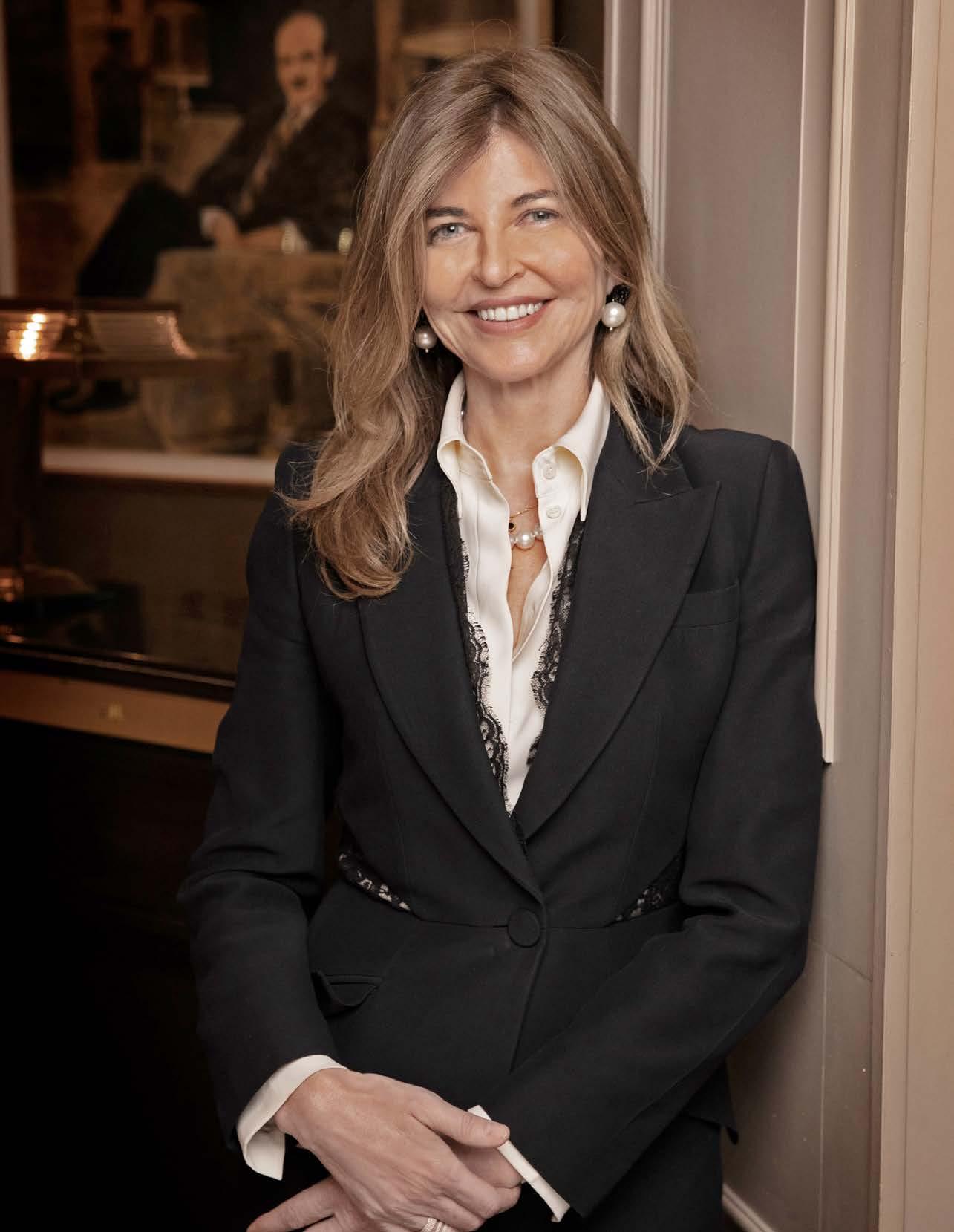
Home is where the heart is
partnership
BERNIE GALLAGHER , THE CHAIRWOMAN OF THE DOYLE COLLECTION, ON UNBEATABLE IRISH HOSPITALITY AND PRESERVING HER FATHER’S LEGACY
In
with The Doyle
Collection
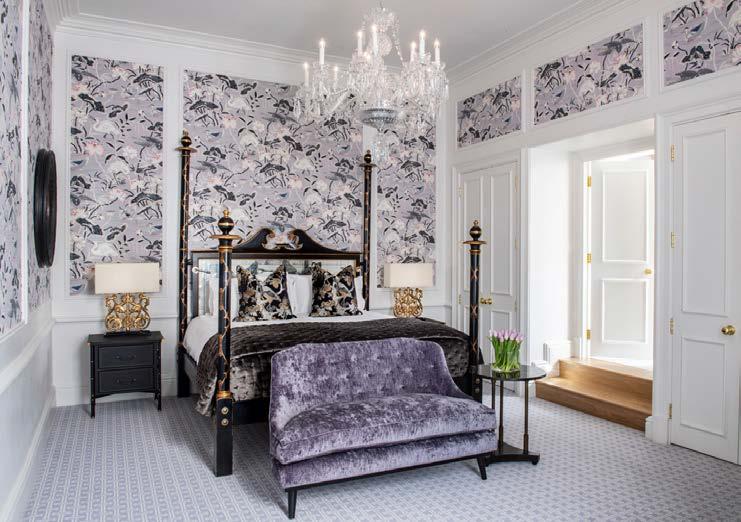
Founded in Ireland by hotelier P.V. Doyle, The Doyle Collection opened its first hotel in Dublin in 1959, before launching six other properties in the same city shortly thereafter. An outpost in Washington, D.C. followed, alongside the group’s first London hotel, The Marylebone, in 1984.
Today, The Doyle Collection operates three hotels in the capital, the group having bolstered its portfolio with The Bloomsbury, which opened in 2000, and The Kensington, which was extensively renovated in 2021.
As The Doyle Collection celebrates its 65th anniversary, Luxury London sits down with chairwoman Bernie Gallagher, the daughter of the group’s founder.
Q
A What inspired you to join the family business?
I grew up in the industry, so hospitality has been a constant part of my life. I have always been passionate about architecture and design, particularly the way general aesthetics, lighting and environment can profoundly influence wellbeing. I also have a keen interest in economics – I studied economics and politics for my degree at university – and have managed to put my education to good use in my day-to-day work.
Q A What influence did your father have on you from a business perspective?
He was a pioneer and a visionary – a true hotelier. He was wonderful at identifying new trends in the luxury travel and leisure industries and was passionate about promoting Ireland on the international stage. Working alongside him was a joy and privilege.
Q A What have been your major accomplishments since becoming chairwoman of The Doyle Collection?
Since taking on the role, we have repositioned and redesigned the assets and the business into an international hotel group that currently includes eight hotels across Dublin, London, Cork, Bristol and Washington, D.C. I had a vision of developing the group into a modern and exciting brand in the luxury boutique hotel space, creating an identity through a unique blend of great design, warm service and unique spaces.
Q A What is the central ethos of The Doyle Collection?
We are constantly trying to remain ahead of the curve – whether that be in designing a new outdoor terrace, developing new suites, or supporting the arts in our communities. We also have a strong idea of our position in each of our neighbourhoods, all of which are located in the centre of the cities in which we are based, in close proximity to key landmarks.
Q A What unites each of your three London hotels?
Our focus is always centred on the guest. These are independent, Irish family-owned, boutique hotels, and we possess a warmth of welcome and a relaxed luxury. This is something that is shared within each space. There is a real focus on design, creativity and quality.
Q
A Could we draw you on your favourite of your London hotels?
I could never pick a favourite! Each one is special to me for a number of reasons. They are all very individual based on their location, spirit of the neighbourhood, and the architecture of their buildings.
Q A With so many hotels opening in London, how do you ensure The Doyle Collection can compete?
Consistency of service, and rigorously maintaining a level of quality and luxury. We always want to inject a sense of playfulness, excitement and fun into our spaces.
Q A Why do you think so many of your customers are return visitors?
Our hotels are imbued with a sense of warmth that welcomes guests as soon as they enter our doors. This is what I strive for, in every element of our business – that the guest immediately experiences a sense of belonging, of homecoming and a sense of place.
doylecollection.com
55 LUXURY LONDON PROMOTION LUXURYLONDON.CO.UK
THE BROMPTON SUITE WITHIN THE KENSINGTON HOTEL
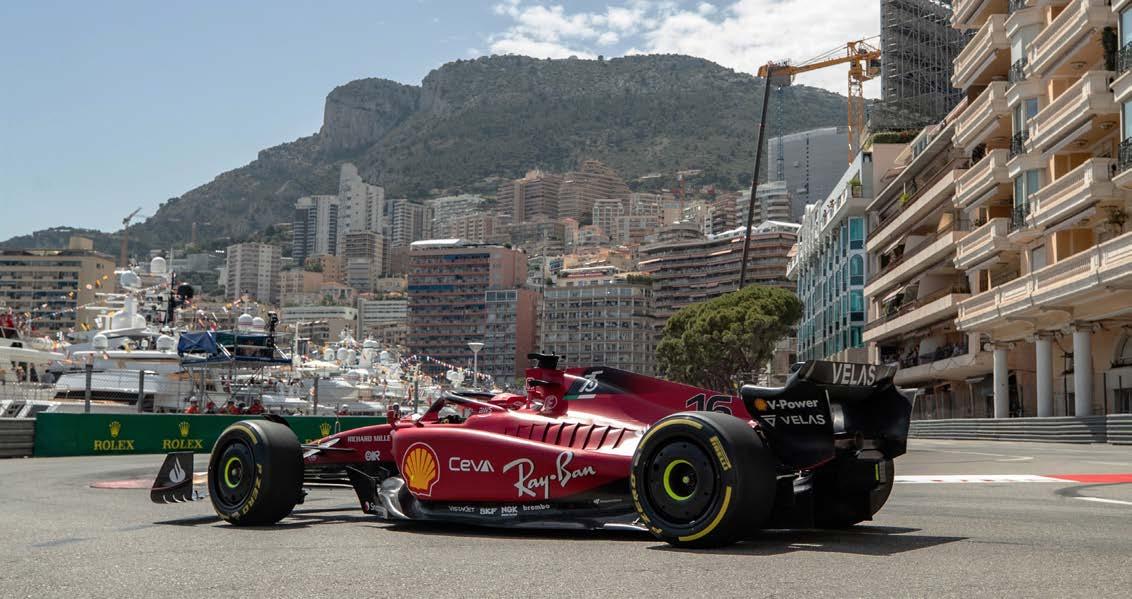

MyYachtGroup.com | Info@MyYachtGroup.com THE TRACKSIDE SUPERYACHT F1® EXPERIENCE 81st Monaco Grand Prix May 24-26, 2024 Luxury hospitality The annual royal party Speedboat transfers Like-minded company CONNECTING THE WORLD’S MOST INTERESTING PEOPLE®

The Agenda Your curated guide to contemporary culture in the capital
AI-Generated Art Gimmicky fad or the real deal?
Marley in the Mountains How the search for an alternative cancer cure lead to the Bavarian Alps
MUSEUMS AND MASTERPIECES
CUTE, A NEW EXHIBITION AT SOMERSET HOUSE, EXPLORES THE EMOTIVE POWER OF THINGS THAT MAKES US MELT, P.63
58
66
72 Bob
MUSIC,
Culture
The Agenda
Edited by: Anna Solomon

58 LUXURY LONDON CULTURE LUXURYLONDON.CO.UK YOUR CURATED GUIDE TO CONTEMPORARY CULTURE IN THE CAPITAL
INSTALLATION VIEW OF EVA FÀBREGAS’ WHEN FORMS COME ALIVE PHOTO: JO UNDERHILL COURTESY THE HAYWARD GALLERY
THE TIME IS ALWAYS NOW:
ARTISTS REFRAME THE BLACK FIGURE
NATIONAL PORTRAIT GALLERY
UNTIL 19 MAY 2024
This exhibition highlights the work of artists from the African diaspora, and weaves an alternative narrative to that of the Western art canon: one where black artists and subjects are platformed. The pieces are striking, sometimes alarming, and always powerful.
£16 (free for members), npg.org.uk

THE PICTURE OF DORIAN GRAY
THEATRE ROYAL HAYMARKET
UNTIL 11 MAY 2024
Sarah Snook (Succession) stars in a one-woman West End production of Oscar Wilde’s novel, where she takes on all 26 roles. Kip Williams’ retelling of a classic is campy, witty, and visually arresting.
From £40, doriangrayplay.com
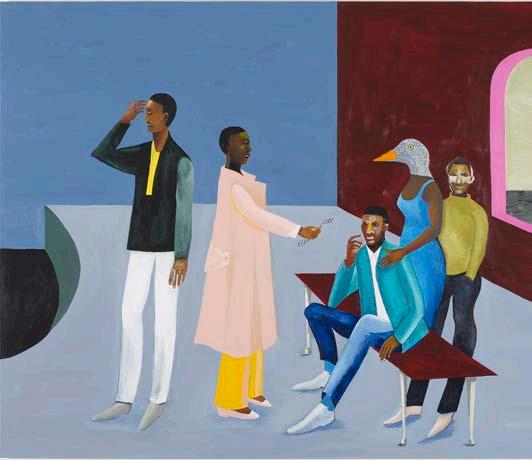
WHEN FORMS COME ALIVE
HAYWARD GALLERY
UNTIL 6 MAY 2024
When Forms Come Alive showcases contemporary sculptures inspired by movement – a dancer, perhaps, or a breaking wave. Undulating, cascading and proliferating, they trigger a visceral response that feels welcome in an increasingly digitised and disembodied era.
From £18 (free for members), southbankcentre.co.uk

59 LUXURY LONDON CULTURE LUXURYLONDON.CO.UK
INSTALLATION VIEW OF FRANZ WEST AND NAIRY BAGHRAMIAN, WHEN FORMS COME ALIVE PHOTO: JO UNDERHILL. COURTESY THE HAYWARD GALLERY
LE RODEUR: THE EXCHANGE BY LUBAINA HIMID (2016) ©LUBAINA HIMID. COURTESY OF THE ARTIST AND HOLLYBUSH GARDENS, LONDON. PHOTO: ANDY KEATE
PHOTO: MARC BRENNER

JUDY CHICAGO: REVELATIONS
SERPENTINE NORTH GALLERY
22 MAY – 1 SEPTEMBER 2024
This is London’s first solo presentation of trailblazing artist and feminist icon, Judy Chicago. In the 1960s, Chicago was one of the first to make art which prioritised the personal and collective experiences of women.
Free, serpentinegalleries.org
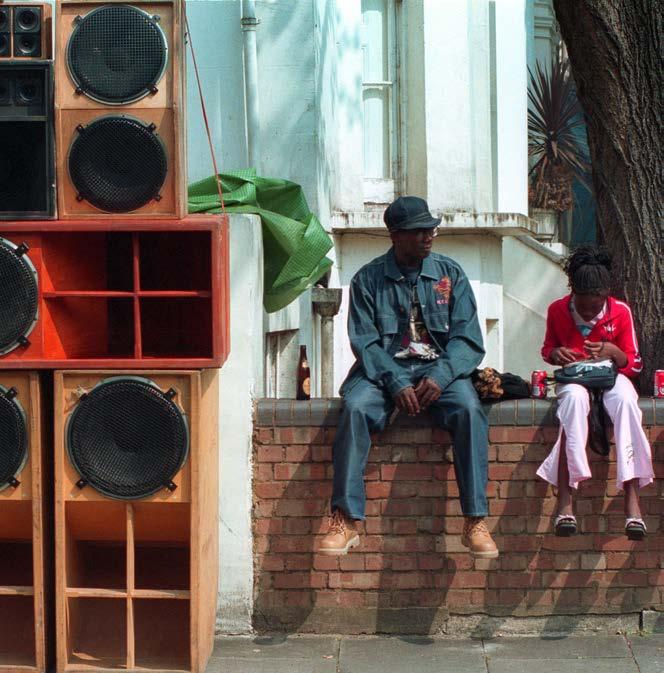
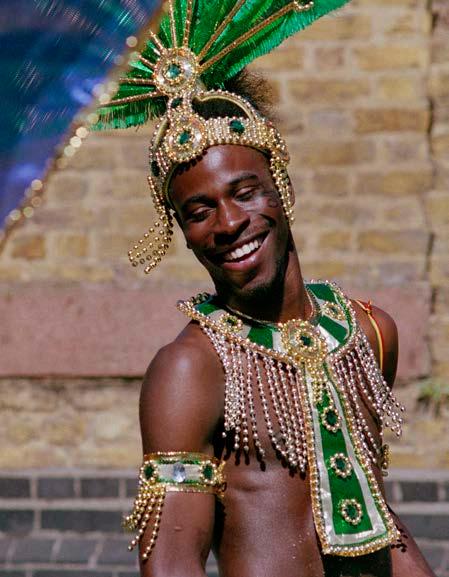
BEYOND THE BASSLINE
THE BRITISH LIBRARY
26 APRIL – 26 AUGUST 2024
From Tudor musician John Blanke to DJ Nia Archives, Beyond the Bassline will delve into 500 years of black music. Through a series of objects and mediums, the exhibition will highlight the artists, events, carnivals and clubs that brought jazz, reggae, jungle, and so much more, to Britain.
Price to be confirmed, bl.uk
60 LUXURY LONDON CULTURE LUXURYLONDON.CO.UK
ABOVE AND LEFT NOTTING HILL CARNIVAL ©MARK PAINTER & URBANIMAGE TV

BURTYNSKY: EXTRACTION / ABSTRACTION
SAATCHI GALLERY
UNTIL 6 MAY 2024
Edward Burtynsky photographs the impact of human activity on the planet, capturing wasted landscapes, toxic ponds, and tunneling mines. This exhibition will raise awareness of issues that, he says, “have never been more urgent”.
From £10, saatchigallery.com
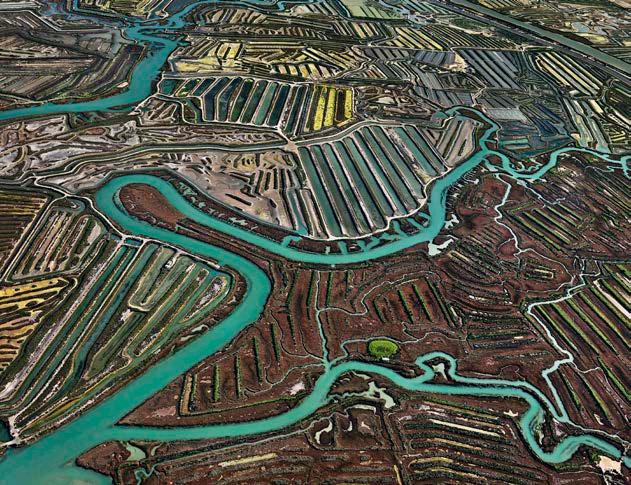

OPENING NIGHT
GIELGUD THEATRE
UNTIL 27 JULY 2024
Sheridan Smith takes the lead in this new Ivo van Hove musical. Based on John Cassavetes’ 1977 film, Opening Night follows a theatre company’s preparations to stage a new play on Broadway, until the leading lady is rocked by tragedy...
Tickets from £20, delfontmackintosh.co.uk
61 LUXURY LONDON CULTURE LUXURYLONDON.CO.UK
ABOVE JUDY CHICAGO, IN THE BEGINNING FROM BIRTH PROJECT, 1982 PRISMACOLOR ON PAPER 65 X 389 IN. (165.1 X 988.06 CM)
©JUDY CHICAGO/ARTISTS RIGHTS SOCIETY (ARS), NEW YORK
PHOTO ©DONALD WOODMAN/ARS, NY
RIGHT SALINAS #2, CÁDIZ, SPAIN, 2013 PHOTO ©EDWARD BURTYNSKY COURTESY FLOWERS GALLERY, LONDON
PHOTO MATT CROCKETT ARTWORK DESIGN BY OLIVER ROSSER FOR FEAST
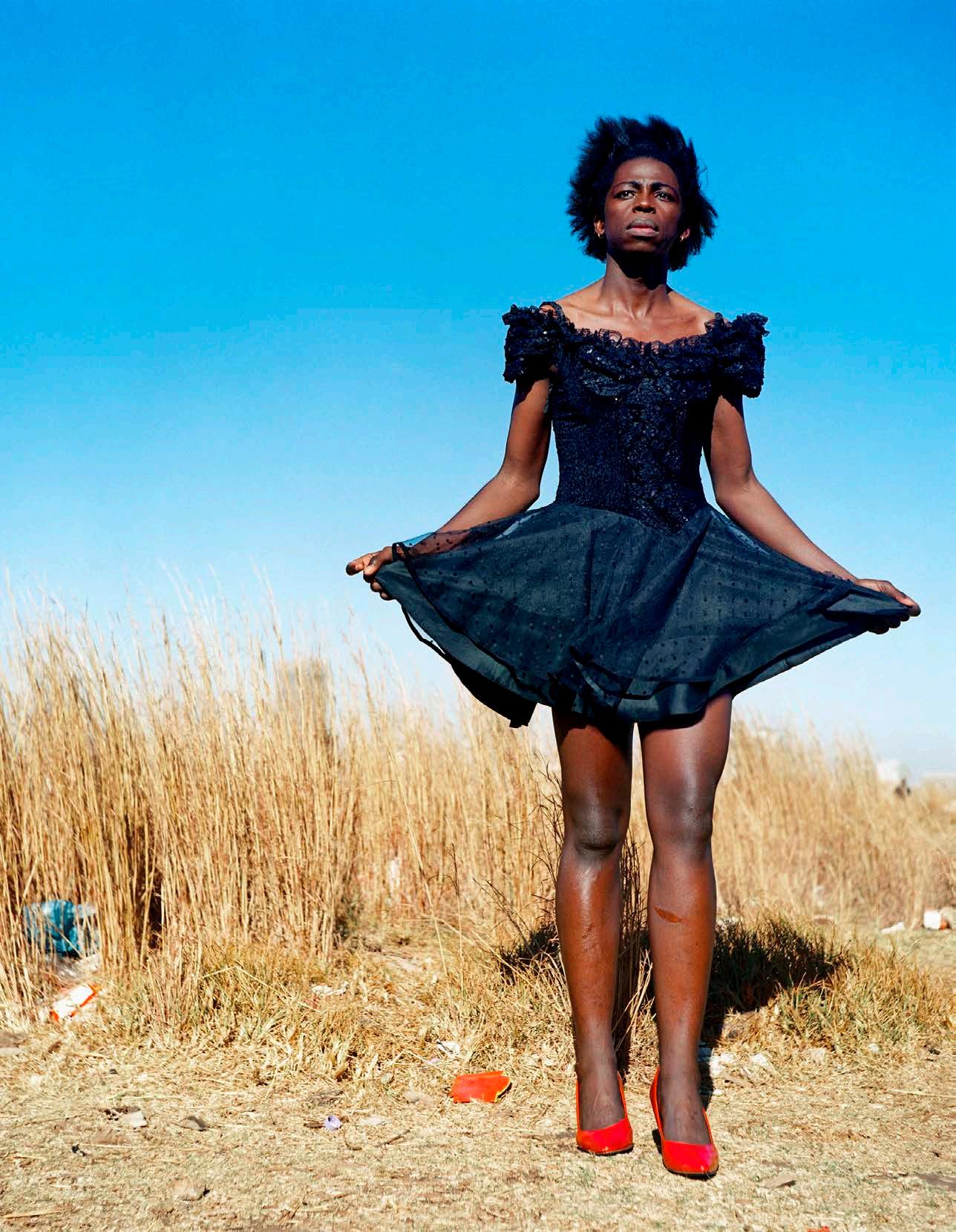
ZANELE MUHOLI
TATE MODERN
6 JUNE 2024 – 26 JANUARY 2025
Zanele Muholi is arguably one of the most acclaimed photographers working today. The ‘visual activist’ has been documenting and celebrating the lives of South Africa’s black LGBTQ community since the early 2000s – each image tells a marginalised story, and pulses with defiance. With more than 260 photographs on display, this exhibition will capture the full breadth of Muholi’s career.
Pricing to be confirmed (free for members), tate.org.uk
ZANELE MUHOLI BESTER I, MAYOTTE, 2015 COURTESY OF THE ARTIST AND STEVENSON, CAPE TOWN/JOHANNESBURG AND YANCEY RICHARDSON, NEW YORK
ZINEB SEDIRA: DREAMS HAVE NO TITLES
WHITECHAPEL GALLERY
UNTIL 12 MAY 2024
Walking into this exhibition, you find yourself in a re-creation of a scene from the 1983 film, Le Bal. The significance of this, and of the other installations that you encounter, only becomes clear when you reach the end.
Tickets from £12.50. whitechapelgallery.org
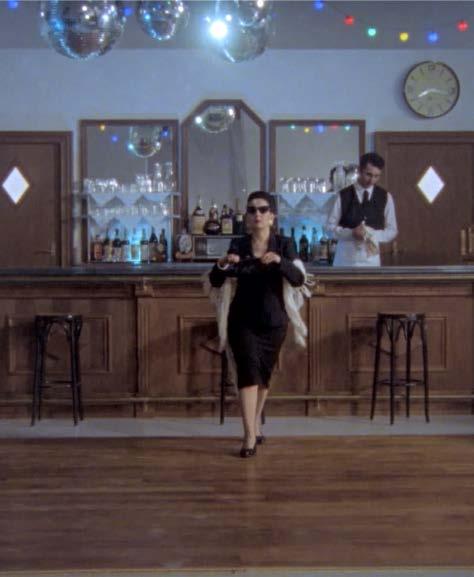
FRAGILE BEAUTY: PHOTOGRAPHS FROM THE SIR ELTON JOHN AND DAVID FURNISH COLLECTION
VICTORIA AND ALBERT MUSEUM
FROM 18 MAY 2024
The personal collection of Elton John and David Furnish is superb, containing work from leading photographers such as Ai Weiwei, Robert Mapplethorpe and Cindy Sherman. Audiences will get the chance to see it at Fragile Beauty, which will feature more than 300 rare prints.
Prices to be confirmed, vam.ac.uk

CUTE SOMERSET HOUSE
UNTIL 14 APRIL
Why are we drawn to doe eyes, chubby cheeks and fluffiness? What is it about babies and cats that make us melt? These are the questions asked in the Somerset House exhibition, Cute. By bringing together artworks with cultural phenomena such as music, fashion, toys and games, this exhibition dives into the world of cute culture and interrogates its emotive charge.
£18.50, somersethouse.org.uk

63 LUXURY LONDON CULTURE LUXURYLONDON.CO.UK
ZINEB SEDIRA STILL FROM DREAMS HAVE NO TITLES AT THE VENICE BIENNALE 2022
DAKOTA HAIR, 2004, BY RYAN MCGINLEY ©RYAN MCGINLEY STUDIOS
ABOVE LOUIS WAIN, GINGER CAT, 1931 COURTESY OF BETHLEM MUSEUM OF THE MIND

Royal Ascot 2024
AS SPORT AND SOCIALISING GOES, IT DOESN’T GET MUCH BIGGER THAN THIS. HERE’S WHAT TO EXPECT FROM THE EVENT OF THE SUMMER
In partnership with Royal Ascot


What is the best thing about Royal Ascot? Well, of course, it depends on what floats your boat. If you’re a thrill-seeker, there’s nothing like the rush you get from cheering your favourite horse – separated from its competitors by a hair’s breadth as it thunders down the track – over the finish line.
Royal Ascot, which this year runs from 1822 June, is also the social event of the season. The races may provide the focal point, but they are only the tip of the iceberg when it comes to high-octane entertainment. Alongside seven flat races a day, attendees enjoy a whole week of festivities, including fantastic musical performances.
Plus, great food. In fact, we wouldn’t blame you if you went to Royal Ascot solely for the fine dining alone. The event is home to numerous restaurants with Michelin starred chefs in residence – you can get delicious three-course meals and hospitality in the Queen Anne, Village, and Royal enclosures. If you’re not after a sit-down affair, there is an abundance of street-food stalls, on-the-go eateries and pop-up bars – and proceedings wouldn’t be complete without a glass of champagne with afternoon tea in the sun.
And who could forget the fashion? Royal Ascot is an exuberant celebration of style – guests come to see and be seen; photographers clamour to snap the sartorial spectacles which will set summer trends. Bold patterns, bright colours and extravagant headwear abound, giving the phrase ‘dress to impress’ a whole new meaning.
Of course, if you’re a lover of horse-racing, this is the pinnacle of the sport. For more than 250 years, Royal Ascot has been the crown jewel of British racing; this is where esteemed trainers and champion jockeys come together to race world-class thoroughbreds. It’s racing at its most exquisite, where horses and riders are competing to claim their place in history.
By which we mean to say, there is something for everyone at Royal Ascot. Whether your ideal day consists of a sunny picnic in the Windsor Enclosure, spurring your horse on in the Village Enclosure, having a sing-along around the Bandstand in the Queen Anne Enclosure, or enjoying Fine Dining in the Royal Enclosure, this is the event for your summer calendar.
Early booking ends midnight 29 March, with prices starting from as little as £35 per person. Standard tickets from £49 per person. Join the merriment at ascot.com
65 LUXURY LONDON PROMOTION LUXURYLONDON.CO.UK
Who framed AI?
ART GENERATED BY ARTIFICIAL INTELLIGENCE:
FAIRGROUND NOVELTY OR SERIOUS CREATIVE MOVEMENT?
Words: Rob Crossan

66 LUXURY LONDON CULTURE LUXURYLONDON.CO.UK
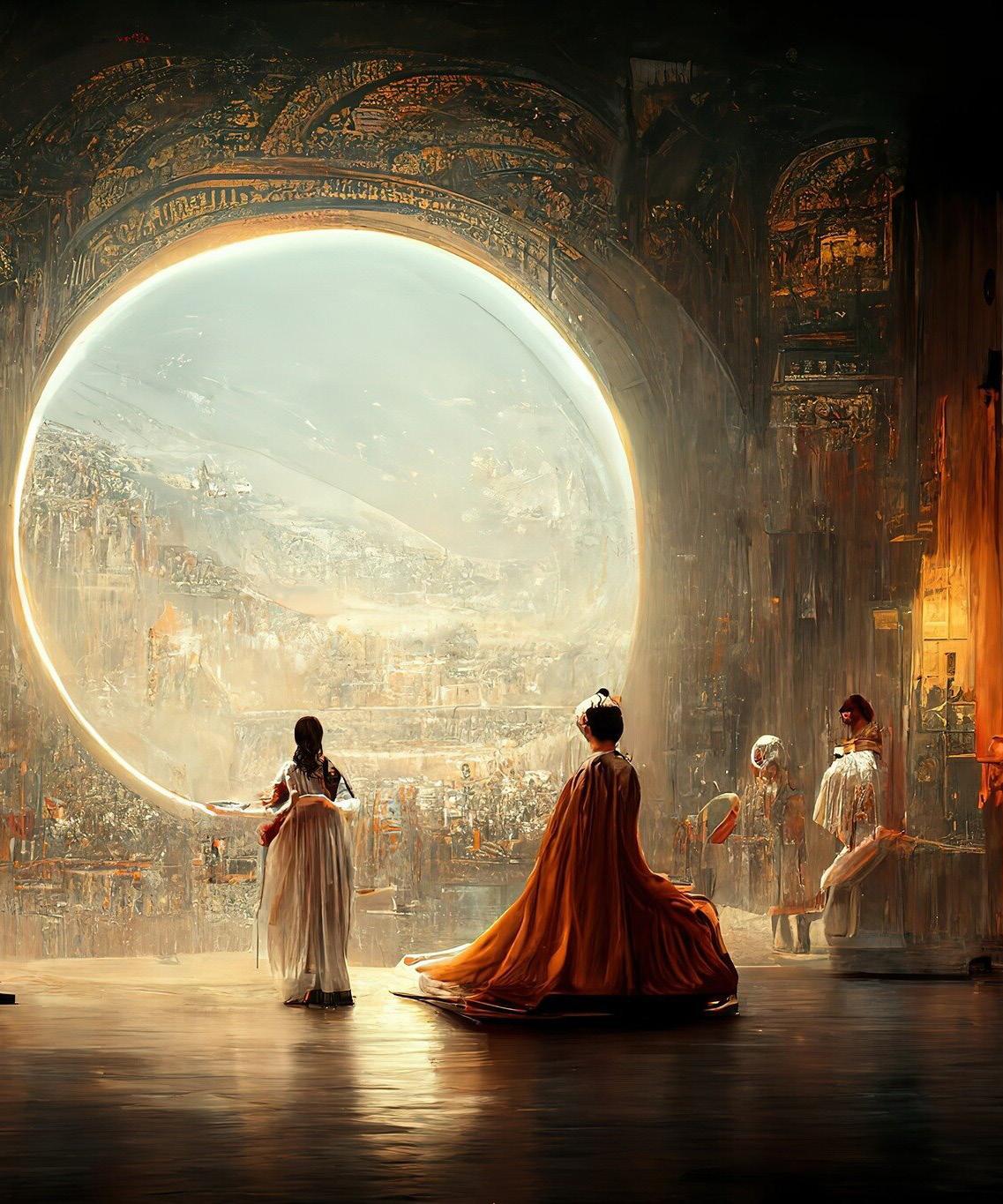
67 LUXURY LONDON CULTURE LUXURYLONDON.CO.UK
“Once or twice in every century, it seems, there is something that arrives which changes things.”
So said Daniel Birnbaum, who leads the Royal College of Art’s Present Futures: Virtual and Augmented Reality in Art course, in The Telegraph last year. “Photography changed not just the distribution possibilities of art, but actually the ontology of what an art piece can be,” Birnbaum continued. “Right now, it’s similar to when the video camera arrived – or even moving film. It’s a transformation of that scale.”
Birnbaum could hardly be called a harbinger of doom when it comes to the use of AI in art; he runs a programme that is looking to charge students more than £2,000 for a three-day course. But he
has a valid point that transcends any fealty to his employers. To dismiss art generated by artificial intelligence as mere copycat frippery is to negate the long history of how machines and creativity have interwoven.
There is, however, a problem with using history to sooth our anxiety about the current acceleration of Artificial Intelligence. In the past, technological leaps were inaccessible, at their outset at least, to everyday creative pierrots. The difference is that, right at this very moment, anyone with a laptop or smartphone can produce AI-generated art in less time than it took me to type this sentence.
When Ada Lovelace, the matriarch of computer science worked as the amanuensis to Charles Babbage on his analytical engine in the early

68 LUXURY LONDON CULTURE LUXURYLONDON.CO.UK
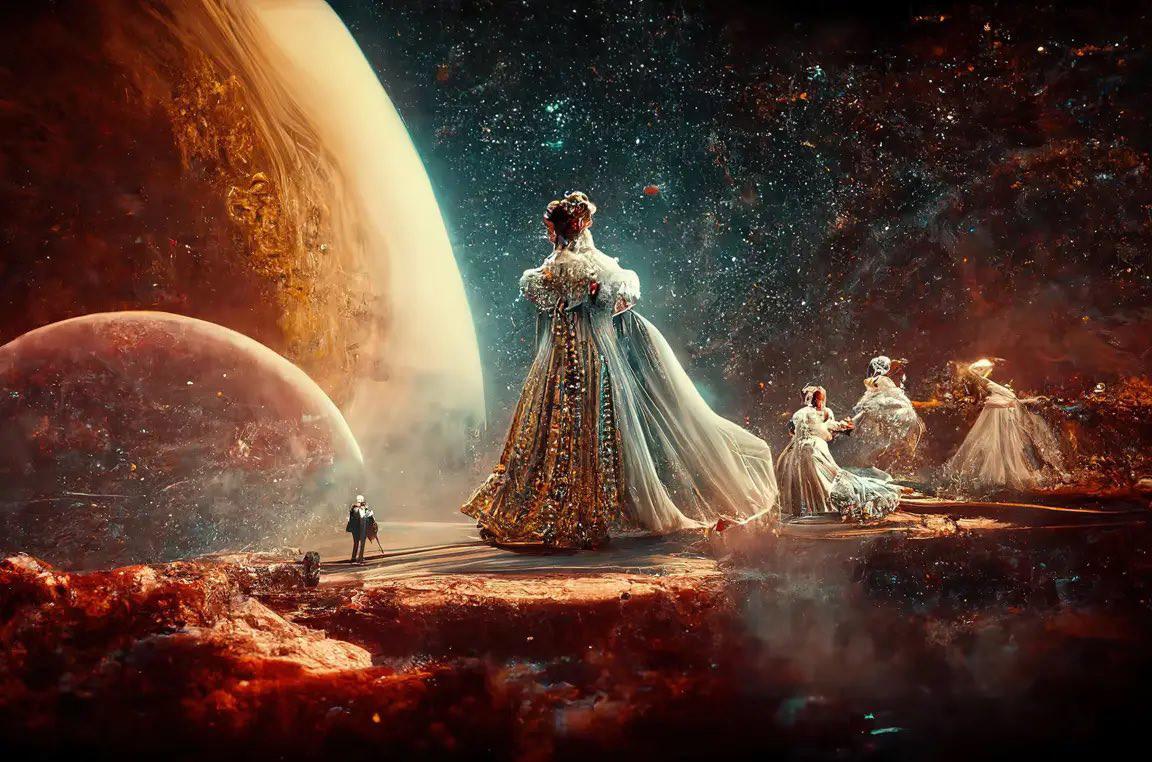
1840s, she imagined a machine that could have artistic, not just mathematical, applications. The analytical engine was based on the Jacquard loom, which revolutionised the textiles industry at the start of the 19th century by feeding in punch cards which instructed the loom whether or not to stitch. By this method, a portrait of the loom’s inventor Joseph Jacquard, was woven into a tapestry on the loom with 24,000 punched cards. You might call this the first digitised image. Yet this technology was about as accessible to the average jobbing artist as a face-to-face meeting with Cézanne.
Compare the quantity of punch cards, plus the manpower and time involved in creating the portrait of Jacquard to the workload of Jason Allen, who submitted an AI picture to a US state-sponsored art competition last year and took home first prize.
Allen entered an artwork titled Théâtre D’opéra Spatial to the Digital Arts/Digitally-Manipulated Photography category of the Colorado State Fair fine arts competition using a text-to-image generator called Midjourney.
Many fellow entrants claimed that Allen had been deceptive in submitting the piece but the winner was robust in his defence. “I wanted to make a statement using artificial intelligence artwork,” he told reporters. “I feel like I accomplished that, and I’m not going to apologise for it.”
“I wanted to make a statement using artificial intelligence artwork... and I’m not going to apologise for it”
Allen had, undoubtedly, participated personally in the creation of the piece. Producing an award-winning painting depicting a production of the 1875 opera Carmen required more dexterity and articulacy than simply typing in, ‘stage/opera/light/Italy’ into an AI generator and waiting for his cash prize. Hundreds of attempts at text ‘prompting’ have to be made in order to create exactly what an artist is looking for.
This is a typical example of a prompt created by New York-based AI artist and designer, Nick St. Pierre: ‘35mm, 1990’s action film still, close-up of a bearded man browsing for bottles inside a liquor store. WATCH OUT BEHIND YOU!!!
69 LUXURY LONDON CULTURE LUXURYLONDON.CO.UK
LEFT A TEXT-TO-IMAGE-GENERATED SCENE CREATED BY NEW YORK-BASED AI ARTIST NICK ST. PIERRE THIS IMAGE SPACE OPERA TWO, CREATED BY JASON ALLEN
(background action occurs):: 1.2 a white Benz truck crashes through a store window, exploding into the background scene :: broken glass flies everywhere, flaming debris sparkles light the neon night, 90s CGI, gritty realism -- ar 16:9 -style raw’.
Perhaps it’s this kind of staccato didacticism, fused with chaos and randomness, that appeals to Damien Hirst who, last year, embraced artificial intelligence with his The Beautiful Paintings. These swirly, abstract pieces were entirely AI generated; available in both hand-signed physical wood versions and in digital-only NFT format.
Inevitably, the screams of ‘it’s not proper art’ aimed at Hirst and Allen et al are as bilious and fulsome as they were over a century ago when Marcel Duchamp put a urinal into an art gallery.
But what is ‘prompted’ AI art without the ‘prompter’? Surely, as long as the resulting work makes us feel something, then it has fulfilled its primary purpose. And whether the artist completed the job in 15 minutes or 15 years is hardly relevant if it has no emotional impact on anyone who looks upon it.

If AI art is devious, then so was trompe l’oeil –the optical illusion of creating three-dimensional space on a two-dimensional surface – when it was used by artists in Ancient Greece and Rome. And if the definition of ‘art’ is something that is crafted by an uncommonly gifted hand, then we may as well also remove photography from the canon of legitimate art forms. If we’re happy to diminish Diane Arbus as a woman with a machine who pointed it at things then, by that logic space travel is just a tin can flying to the moon and The Beatles were just four Scousers with a drum kit.
as if illuminated from within”, he said, while many also displayed “high dynamic range”, meaning differences in light levels within the image. And just as every pre-Raphaelite needed to know something (however hazy) about art history, and what they liked and disliked, before they can truly create, so the AI-generated artist, Meyer argued, also needs to know something of his analogue predecessors.

Try typing this prompt into an AI art generator such as Midjourney, Jasper, NightCafe or dall-e-2: ‘Jackson Pollock Vienna street scene’. At best you’ll get a smudged picture of paint on a road supplied by Google Street Maps. This is not how state fair art prizes are won. AI art neophytes need to understand Jackson Pollock as much as Duchamp needed to understand Fauvism and Roussel before they can create something of true worth.


Despite the argument that AI is nothing more than a blitz of art history concertinaed, repackaged and repurposed, it would appear that something approaching a distinctive style is emerging.
Looking at a series of AI art pieces generated by Midjourney (yes, the same tool used by that controversial prize-winner Allen) Roland Meyer, a researcher at Ruhr University Bochum, Germany, noticed some recurring features.
Many AI pieces would “shine and sparkle,
If there is a drawback to creating art using artificial intelligence then it is literature, and in the poverty of language’s ability to harness our deepest emotional reactions. This may explain why AI journalism and poetry is fathoms behind visual art when it comes to what we perceive as quality. Asking ChatGPT to write me a song about the 18thcentury Spanish painter and etcher Francisco Goya, for example, yielded the following lyrics:
His legacy lives in each canvas, each frame, A testament to genius, forever the same, In Goya’s art, we find a reflection of self, A painter whose truth transcends death’s stealth.
Shameful stuff. Perhaps this is because, by their very nature, words exist to describe things. The intention of art, by comparison, is to move us. To make us feel. Great art is ineffable, in a way that literature simply cannot replicate.
Which perhaps explains why AI continues to be so weak at creating prose, and increasingly successful at making worthy visual art. In visual art, artificial intelligence has already begun the shift from cerebrally fooling us, to moving us emotionally.
70 LUXURY LONDON CULTURE LUXURYLONDON.CO.UK

THIS PAGE AND LEFT IN 2023, DAMIEN HIRST CREATED THE BEAUTIFUL PAINTINGS, SWIRLY, ABSTRACT PIECES THAT WERE ENTIRELY GENERATED BY ARTIFICIAL INTELLIGENCE. THEY WERE MADE AVAILABLE IN HAND-SIGNED PHYSICAL WOOD VERSIONS AND IN DIGITAL-ONLY NFT FORMAT

BOB MARLEY ON A CANAL CRUISE IN AMSTERDAM, 1980, A YEAR BEFORE HE DIED ©LAURENS VAN HOUTEN
Waiting Vain in
AS A NEW BIOPIC DOCUMENTS THE LIFE OF REGGAE STAR BOB MARLEY, LUXURY LONDON EXPLORES THE LESSER-TOLD STORY OF HOW THE FRANTIC SEARCH FOR AN ALTERNATIVE CANCER CURE SAW THE JAMAICAN SINGER PUT UNDER THE CARE OF A DISCREDITED, NAZI-AFFILIATED DOCTOR IN THE BAVARIAN ALPS
Words: Rob Crossan
Rottach-Egern, Bavaria, Germany. February 1981. A clearing has been made in the snow on a morning rendered frigid by a septum-grazing cold. Cleared by spade, shovel and sweat, a small group of 30-something men are kicking a football around the makeshift, off-white pitch. To one side, the frozen, bruise-and-bone-coloured surface of Lake Tegernsee can be glimpsed. Above the group juts the flake and ice-smothered heights of the Bavarian Alps.
One of the men looks thinner than the others; the multiple layers of clothing draped over him can’t disguise his attenuated figure. The profuse, twisted cactus of dreadlocks that once defined him to the world no longer trails out from the bottom of his woollen hat. Clutching his hands to his painfully narrow hips, Bob Marley traps the football at his feet and tries to catch his breath.
By the time of the impromptu, snowbound football game, Robert Nesta Marley, on the cusp of his 36th birthday, had been in the Bavarian Alps for four months. Weakened from cancer, he had travelled to this ice-blasted region of Europe in a last attempt to rid his ailing body from the clutches of what had already been diagnosed as a terminal illness.
‘In the first months of treatment Bob Marley improved considerably and was again able to play football for fun. This helped, of course, to be optimistic and he also saw other seriously ill patients getting better.’
So wrote Ilse Marie Issels, widow of German physician and alternative cancer treatment advocate Josef Issels, two decades after the visit of one of the defining musical artists of the 20th century to Southern Germany.
The origins of the cancer, which by the beginning of 1981 had reduced Marley to a shadow of his former self, have never been entirely understood. What’s certain is that, while touring the Exodus album in Paris in the summer of 1977, the world’s most venerated and popular reggae artist was injured by a French journalist who stepped on his foot during a game of football, piercing Marley’s big toe with the studs of his boots.
According to accounts from those in Marley’s inner circle, this aggravated an existing toe injury dating from a match played in Boys’ Town, Kingston, Jamaica. A biopsy at the Royal College of Surgeons in London, organised by Island Records founder Chris Blackwell, showed that Marley had grade three melanomas, which had already invaded his tissue and dermis.
73 LUXURY LONDON CULTURE LUXURYLONDON.CO.UK

74 LUXURY LONDON CULTURE LUXURYLONDON.CO.UK
BOB MARLEY PRACTICING HIS FOOTBALL SKILLS IN PARIS, 1977. IT WAS DURING
A LATER GAME OF FOOTBALL IN THE SAME CITY THAT MARLEY WOULD SUSTAIN HIS FOOT INJURY ©AP


The only option, doctors explained, was amputation of the toe.
“Of course, once you amputate your toe, you lose your balance”, reflected Marley’s personal physician, Dr Pee Wee Fraser, some years later. “Marley wasn’t very happy about it, because it would have been damaging to his career at that time.”
Against the advice of the London surgeons, Marley elected to have a skin graft instead, taken from his upper thigh. The surgery, which Marley underwent at the Cedars of Lebanon hospital in Miami in early 1978, seemed to be a complete success.
“He never talked about it over the next twoand-a-half years,” said Marley’s chef Gilly Gilbert. “He thought he was cured at that point, ’cause it healed…. To this day I just can’t understand. Marley played soccer in Australia, Zimbabwe, everywhere we go and he was playing like a champion.”
The reprieve, however, was temporary. On 21 September 1980, while on the American leg of the world tour to promote the ecstatically-received Uprising album, Marley suffered a seizure while jogging in Manhattan’s Central Park.
Having just played Madison Square Garden and with concerts with Stevie Wonder on the horizon, nobody was expecting Marley’s health to collapse so suddenly. As Danny Sims, Marley’s producer, later recalled to the biographer Roger Steffens:
“We saw the most renowned cancer doctor on the planet…. He said, ‘Bob Marley is probably the strongest man I’ve ever seen…. But Bob has more cancer in him than I’ve seen with a live human being.’ He said Marley was full of cancer, melanoma… He said that if Marley had followed the instruction after he found out he had the cancer and cut off half his toe, he’d live longer than all of us.”
It was too late. Incredibly, after telling his band and inner circle the news, Marley rallied to play his final show in Pittsburgh, just two days after his collapse in Central Park. Now, the search was on to try, somehow, to save Marley from the cancer spreading to his brain.
Chemotherapy in Miami meant his famous dreadlocks had to be shorn off. Doctors at New York’s Sloan Kettering Cancer Centre advised Marley that he had six months to live. However, there was another medical voice in central Europe who believed otherwise.
Born in 1907, Josef Issels received his medical degree in Wurzburg in 1932, the year before Hitler came to power. Whether through choice or coercion (there is evidence to suggest that the heads of the Catholic hospital in which Issels practised demanded that all doctors be affiliated with the Third Reich) Issels was a Nazi SS member until 1938 when, under orders to stop treating Jewish patients, he requested his resignation
75 LUXURY LONDON CULTURE LUXURYLONDON.CO.UK
from the party be accepted, insisting that he was ‘politically uninterested’.
Dr Issels had his wish granted, and was promptly sent to fight on the Russian front, where he became a prisoner of war. There is no evidence to suggest that Marley, or any of his coterie, knew anything about Dr Issels’ political past. Yet research would have revealed that along with his affiliation, however reluctant, with Nazism, Issels also spent three months in prison in 1960 after the German medical establishment sought to shut down the clinic he’d opened in Rottach-Egern nine years previously.
Before it was closed, Issels’ clinic was growing increasingly popular. Promoting methods that Issels had devised while researching immunology and microbial aspects of cancer aetiology, by 1956 the Ringberg Klinik had treated 1,473 patients. Still, the treatments it advocated were largely considered quackery by the majority of medical professionals. After his short prison stint, Issels was acquitted on all charges – on the grounds that the physician had genuinely believed his therapy could cure cancer. By the time of Marley’s stay, the medical consensus remained that Issel’s methods were unproven and ineffective.
“All we’d a deal wid was him track record [sic],” said Marley’s friend and road manager Allan ‘Skill’ Cole, in an interview in 2010. “When yuh got to know him, he had great humour. To me, he [Issels] was a great humanitarian.”
Cole recalls Marley making remarkable progress shortly after his arrival in Europe. “When him leave New York mi haffi a lift him up. Dem give him one week to live ‘cause him weak, weak, weak,” Cole said. “After treatment him start walk strong, all start play ball again. By Christmas the man start get healthy.”
But the games of football were a brief respite from a rapidly downward trajectory. By the time of Marley’s birthday on 6 February 1981, he was in an advanced state of terminal illness, according to the reggae singer Zema, whose mother was receiving treatment at the clinic at the same time.
“They had a cake that said ‘Happy Birthday Reggae King,’ but I remember they spelled ‘reggae’ wrong,” recalled Zema. “Unfortunately a lot of the time he was in bed in the next room. It wasn’t long after that when Jah [Rastafarian for ‘God’] took Marley home. He had a presence even then, when the illness had reduced him to a fraction of what he had been. He seemed so vulnerable and out of his element.”
After an entire winter in Bavaria undergoing alternative ultraviolet light treatments, Issels had to admit to Marley in early spring that there was nothing more he could do for the singer. Marley had hoped to return to Jamaica, but died in a Miami hospital on 11 May. That very same

Whether Issels contributed anything at all to lessening the pain of Marley’s already terminal cancer is disputed
year, Issels was appointed to the German Federal Government’s Cancer Commission. In 1996, he moved to California, dying two years later, aged 90. Whether Issels contributed anything at all to lessening the pain of Marley’s already terminal cancer is disputed. But, despite the suspicions of the medical community, under Issels’ care Marley lived almost six months longer than his New York doctors believed was possible.
76 LUXURYLONDON.CO.UK


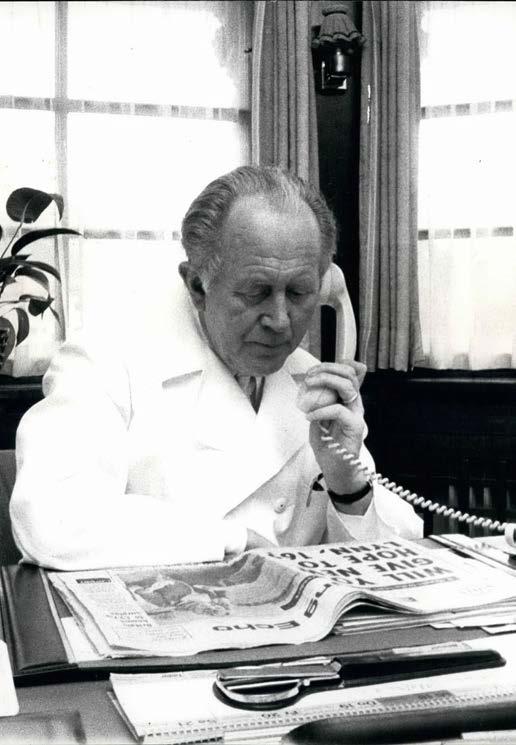
“His voice was an omnipresent cry in our electronic world,” said Jamaican President Edward Seaga at Marley’s funeral, conducted by Abuna Yesehaq, Archbishop of the Ethiopian Orthodox Church in the Western Hemisphere, and which saw a 6,000-strong audience squeeze into the country’s National Arena. “His sharp features, majestic locks and prancing style a vivid etching on the landscape of our minds.”
The owner of Mighty Cloud Records, Devon Douglas, put it more succinctly. When asked by a reporter on the same day about Marley’s premature demise, Douglas said simply: “There is no other person take his place.”
One Love was released in cinemas in February 2024; So Much Things to Say: The Oral History of Bob Marley by Roger Steffens is published by WW Norton & Co, £13.99, amazon.co.uk
77 LUXURYLONDON.CO.UK
LEFT PRIESTS AND CLERGY FROM THE ETHIOPIAN ORTHODOX CHURCH LEAD
A PROCESSION DURING MARLEY’S STATE FUNERAL, 21 MAY 1981 ©RAY FAIRALL
ABOVE DR. JOSEF ISSELS TAKE A CALL IN HIS OFFICE AT THE RINGBERG
CLINIC, 1982 ©KEYSTONE PICTURES
BELOW MARLEY WITH BRAZILIAN FOOTBALLER PAULO CESAR CAJU AND BRAZILIAN SINGER CHICO BUARQUE, RIO DE JANEIRO, 1980 ©ALAMY

Unlock the Luxury Life
WITHIN REACH
In
partnership with Prestige Pawnbrokers

With stores in the City and Chelsea, as well as its own Channel 4 television show, Posh Pawn has established itself as the country’s leading destination for individuals seeking to pawn, sell, exchange or purchase pre-loved luxury items. The company, which is part of the esteemed Prestige Pawnbrokers family, serves anyone with discerning taste for luxury goods and a penchant for savvy financial solutions in central London, the Square Mile and across the home counties.
LOANING AGAINST LUXURY ASSETS
Posh Pawn exists to offer a lifeline when financial emergencies strike. The company’s flexible pawnbroking service allows its customers to leverage their luxury assets to secure shortterm loans, providing clients with immediate funds while allowing them to retain ownership of their prized possessions. Posh Pawn can arrange loans against luxuries from handbags, watches and jewellery to cars, art and wine.
SELLING YOUR LUXURY ASSETS
Posh Pawn offers a seamless and confidential selling experience to those who are looking to part with their

cherished luxury possessions. The company’s team of experts possesses an in-depth understanding of the luxury market, enabling it to assess and appraise items with precision. Whether you have a designer handbag, a luxury watch, fine jewellery, or any other high-end item, Posh Pawn’s offices in the City and Chelsea can provide offers that are hard to match elsewhere.
SHOPPING PRE-LOVED LUXURY
You’ll be delighted by an exceptional selection of pre-loved luxury goods across each Posh Pawn store and online, from coveted Chanel bags to iconic Rolex watches. At Posh Pawn you’ll find luxury items at a fraction of their original retail price. Each item undergoes rigorous authentication and quality checks, ensuring that you get genuine luxury without compromise.
Whether you’re looking for a statement accessory to elevate your style, or a collector’s item to cherish for generations, Posh Pawn provides a plethora of pre-loved products for your perusal.
2
0DP, 020 7096 7330 106 Draycott
Chelsea, SW3 3AE, 020 3984 4206 prestigepawnbrokers.co.uk, shopprestige.com
79 LUXURY LONDON PROMOTION LUXURYLONDON.CO.UK
Street,
Gracechurch
City, EC3V
Avenue,
POSH PAWN BRINGS OPULENCE
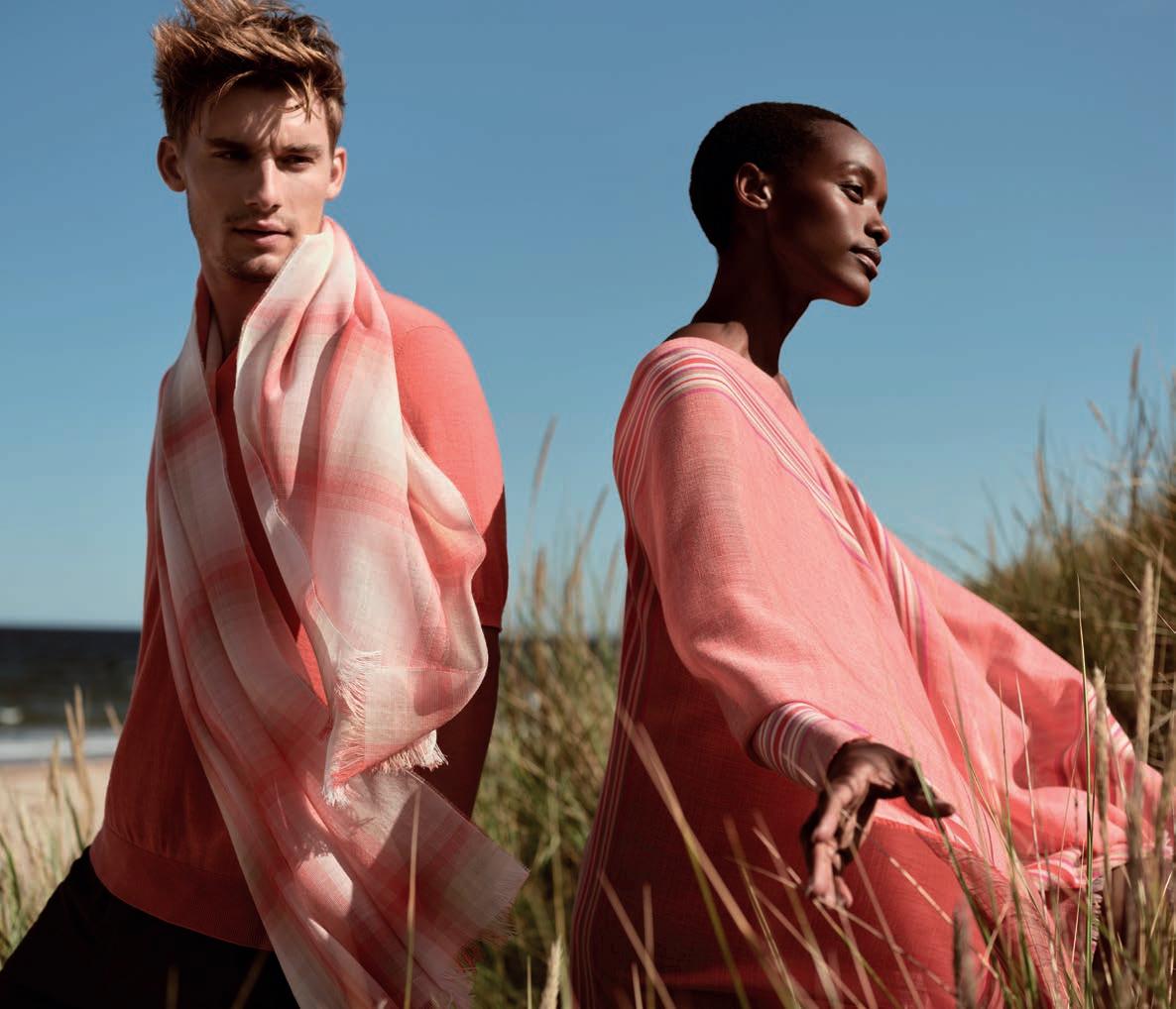
80 LUXURY LONDON FEATURE LUXURYLONDON.CO.UK

82 Designers of Tomorrow The fashion stars changing the way we dress 90 Killing Time The watch brands looking towards the future 94 Cut from a Different Cloth The space-age fabrics reducing fashion’s dependence on fossil fuels THE FUTURE OF FASHION Couture THEBE MAGUGU, THE FIRST AFRICAN TO WIN THE LVMH PRIZE FOR YOUNG FASHION DESIGNERS, P.89 ©TRAVYS-OWEN
New Blood
BIANCA SAUNDERS
Bianca Saunders wants to revolutionise men’s fashion. Since graduating from her MA in Fashion Menswear at the Royal College of Art in 2017, and launching her label the same year, Saunders has stamped her mark on the genre, adopting a gender-bending approach with her designs. At Bianca Saunders’ shows, it’s common to see male models stomping the runway in sheer and ruched materials and figure-hugging cuts – they don cropped tops and side-split trousers. And yet, the garments are eminently wearable. It’s a balance that has earned the Catford-born designer accolades ranging from the British Fashion Council’s ‘One to Watch’ designation, to becoming the first black woman to win the Andam prize (an award established between the French Ministry of Culture and the Defi Mode fashion organisation).
Saunders’ Jamaican heritage is also key in shaping her designs: prints and silhouettes are inspired, she has said, by the black men in her life, like her father and grandfather. The draped styles recall dancehall parties in London. In short, her work is about juxtaposition: of the masculine and feminine, of Caribbean cool and British edge. biancasaunders.com
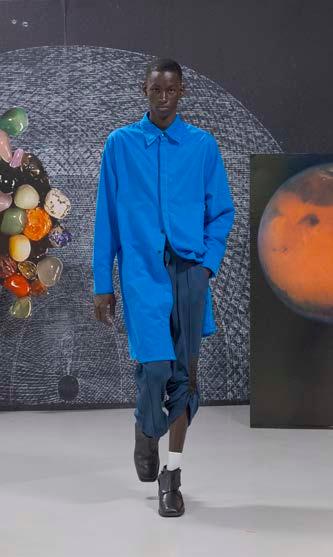
MEET THE TASTEMAKERS OF FASHION’S FUTURE: LUXURY LONDON SPOTLIGHTS
EIGHT RISING STAR DESIGNERS WHO ARE CHANGING THE WAY WE DRESS
Words: Anna Solomon


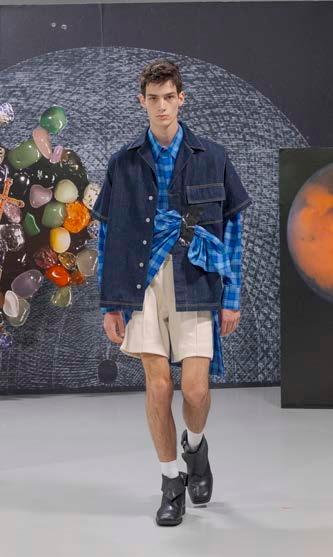
82 LUXURYLONDON.CO.UK
BIANCA SAUNDERS’ SS24 RUNWAY PRESENTATION

MOLLY GODDARD
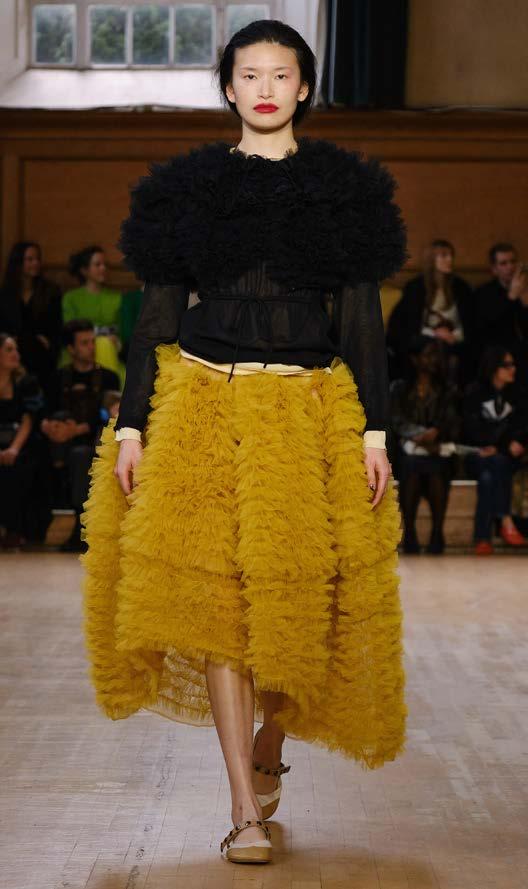
Molly Goddard believes that wearers of her clothes should feel “comfortably overdressed”, which perfectly encapsulates the nature of her always OTT, but never severe, garments. The poofy, diaphanous pieces – which range from frothy tulle frocks to ruffled silk smocks – are reminiscent of the 1950s sheath styles that were repurposed in the punk era, and have proved a hit with high-profile clientele.
Goddard’s orange-and-yellow striped cardigan was immortalised when David Hockney painted Harry Styles wearing one. Ditto a Calpol-pink babydoll dress worn by Jodie Comer’s Villanelle in Killing Eve. Rihanna has been a fan since she posted a picture of herself wearing an enormous tiered Goddard gown in cobalt blue; others include Adwoa Aboah, Zendaya and Agyness Deyn, whose wedding dress the designer created in 2015. Goddard’s distinctive manipulation of fabric, cast in a crayonbox colour palette, has firmly established the London-born designer on the international fashion map. mollygoddard.com

83 LUXURY LONDON COUTURE LUXURYLONDON.CO.UK
MOLLY GODDARD’S AW24 RUNWAY PRESENTATION
 FENG CHEN WANG
FENG CHEN WANG
Chinese-born, London-based designer, Feng Chen Wang, creates unisex garments that are simultaneously conceptual, technical and functional. Her designs are forward-thinking, cast in futuristic silhouettes and featuring deconstructed details.
It’s a point of view that feels fresh, which explains Wang’s rapid ascent: a year after graduating from the Royal College of Art in 2015, she was debuting at New York Fashion Week, and has since been a permanent, celebrated fixture on the roster. Wang has collaborated with brands such as UGG, earned a nomination for the LVMH Prize, and been a finalist in the International Woolmark Prize.
The designer’s heritage informs her designs: she has created sustainable tie-dye techniques based on Chinese ingredients, and even integrated principles of the bodily meridians (the belief in traditional Eastern medicine that there are ‘passageways’ of energy in the body, and the guiding principle behind acupuncture) into her clothes. fengchenwang.com
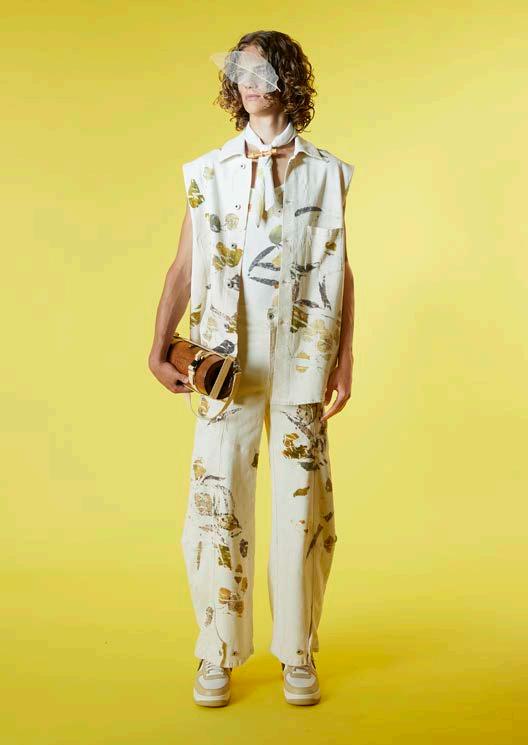

FENG CHEN WANG’S SS24 COLLECTION


SAUL NASH
Unlike many of his peers, Saul Nash didn’t follow the Central-Saint-Martins-to-ownlabel pipeline. Instead, when the north east Londoner graduated from his BA in Performance Design at CSM, he moved into dance. Eventually, in 2018, Nash received a scholarship to the eminent RCA Menswear MA, and established his eponymous brand the same year. But it is his background in dance – and a deep-rooted understanding not just of movement and the body, but also the codes of masculinity – that informs his designs.
Nash makes technical garments created for movement. This means he takes cues from sportswear, but to describe the pieces as ‘athleisure’ would be reductive. Nash’s styles are fluid and relaxed; mesh fabrics meet asymmetric hems and bold colourways. They’re often showcased via dance performances; indeed, Nash’s fashion regularly co-exists with music, and he has worked on choreography and videos for the likes of Neneh Cherry and Bianca Saunders. saulnash.co.uk
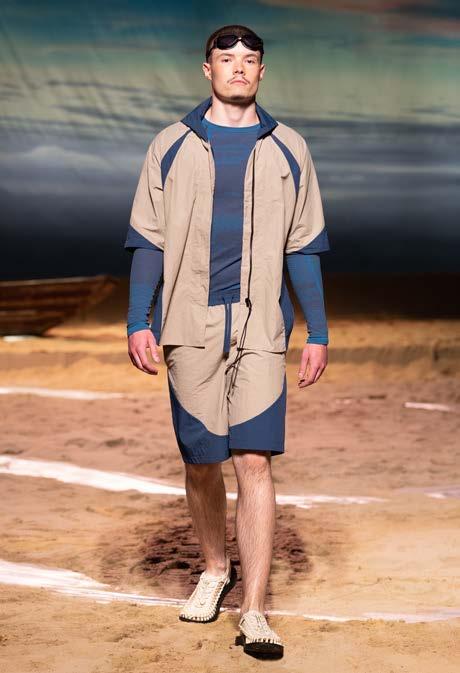
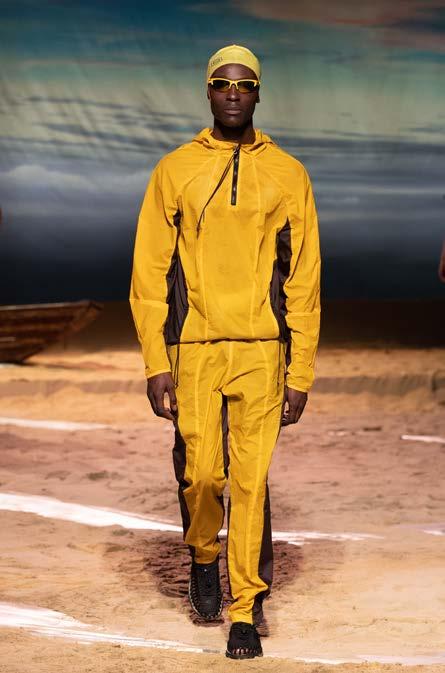
LUXURY LONDON COUTURE
SAUL NASH’S SS24 RUNWAY PRESENTATION

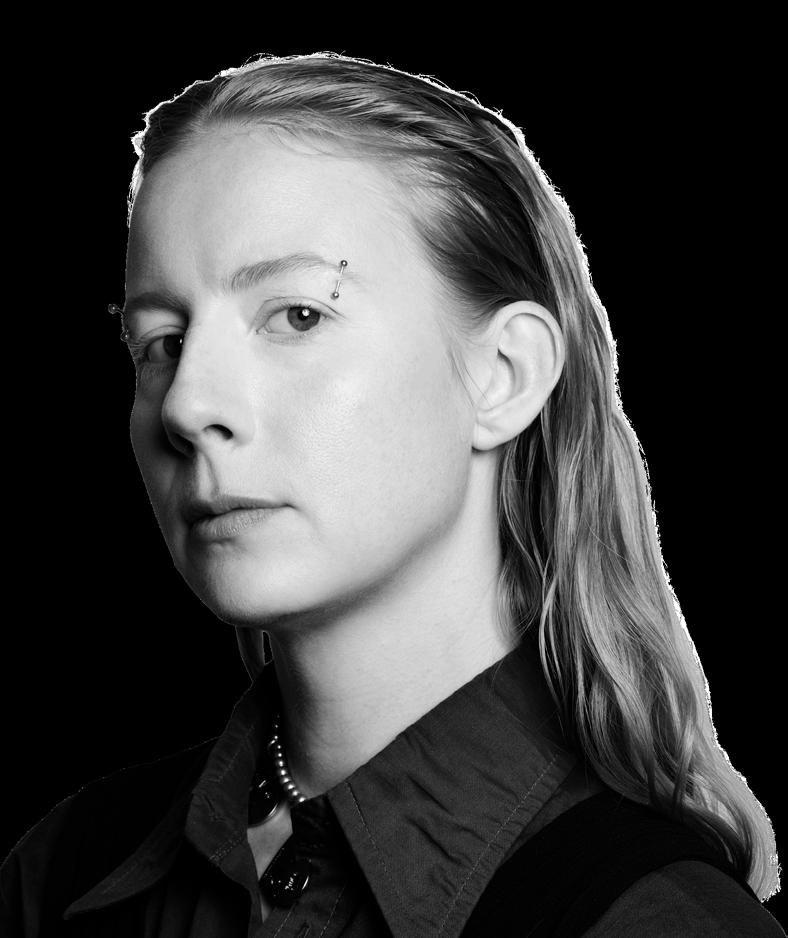

AD O’DWYER
Sinéad O’Dwyer is one of the most pioneering designers on the scene, routinely sending plus-sized, wheelchair-using and pregnant models down the runway. They’re often clad in her trademark silicone-moulded clothing; vibrantly-hued ‘wearable sculptures’ that refuse to hide or minimise parts of the body considered ‘less than’: stomach rolls, ‘love handles’, cellulite. O’Dwyer creates pieces that accommodate all bodies – no-one is precluded from wearing crystal-embellished bras, nipple pasties or thigh-high leather boots in her universe.
O’Dwyer’s work rails against normative beauty standards, and explores the often tense relationship that women have with their bodies. “I’m angry at the industry for its body elitism,” the Irish-born designer once told Dazed magazine. “I’ve seen it cause practically every woman I have ever known to view their bodies in a negative way due to poorly fitting garments, or comparison to... airbrushed imagery.” O’Dwyer is the change; disrupting the status quo from the inside.
@sjodwyer
SINEAD O’DWYER’S SS24 COLLECTION
CHET LO
If you thought that knitwear was about cosy jumpers or tweedy cardigans, Asian American Chet Lo will prove you spectacularly wrong. He catapulted to fashion fame after listing ‘spiked’ garments from his Central Saint Martins BA Knitwear course “to make rent”, and was inundated with orders. The textural pieces captured the zeitgeist: fun, sexy, nostalgic. They also showcase talent. Creating 3D prongs with a pair of knitting needles? Wow.
No surprise, then, that Lo’s graduate show received rave reviews. Or that he went on to join the roster of young talent at Fashion East, as well as the British Fashion Council’s NEWGEN scheme. The designer has created bespoke pieces for Kylie Jenner, and American singers Doja Cat and SZA donned the pink spikes in the music video for smash hit Kiss Me More
Lo’s work is a composite of raw skill (you don’t intern at Maison Margiela and Proenza Schouler by chance), a love of Noughties fashion, and a distinct Eastern influence – he’s obsessed, he has told with “old Japanese comics and the Godzilla visuals”. chetlo.com
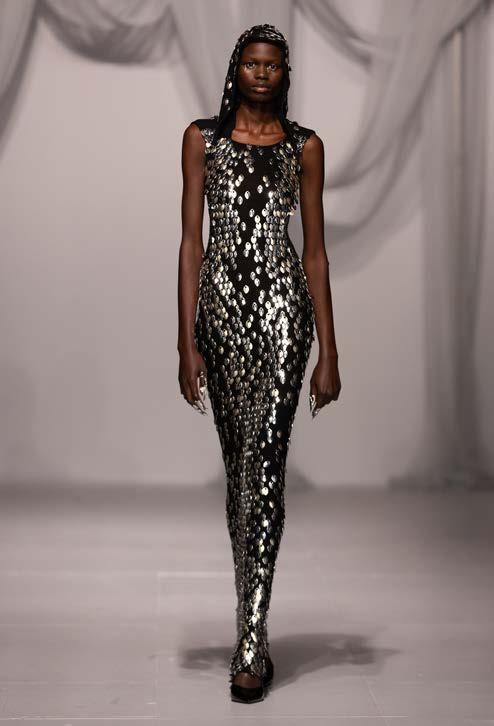
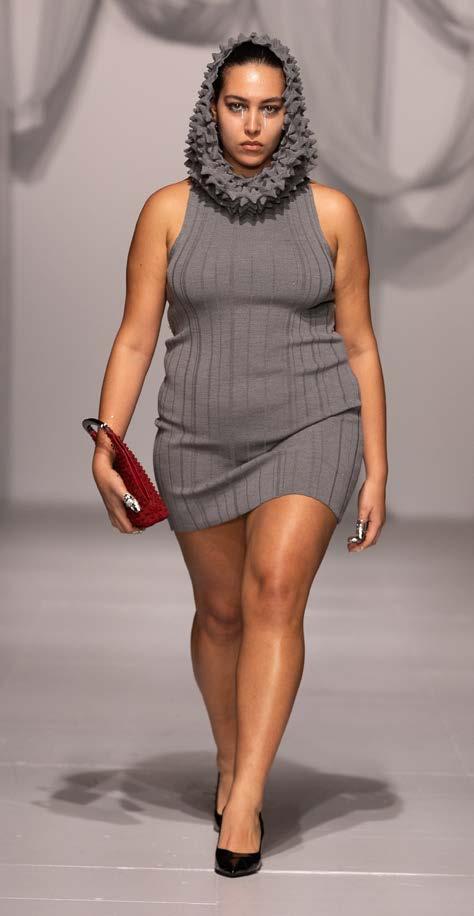

LO’S AW24 RUNWAY PRESENTATION
CHET

SUSAN FANG
Susan Fang’s ethereal creations have been gaining popularity since the launch of her eponymous womenswear brand in 2017, following her graduation from Central Saint Martins and stints at Céline and Stella McCartney.
Fang’s garments and accessories play with traditional ideas of beauty – the textures are sumptuous, the colours candy-like, and the silhouettes classic. But there’s more than prettiness at play here; consider a Susan Fang gown up close and you’ll notice just how mind-bendingly complex the construction is.
This is because Fang’s designs take inspiration from the natural world, and, more specifically, the mathematical processes that underpin it. The Chinese-Canadian designer claims not to be led by trends, but by a desire to ‘express a mirage of artistic illusions’; she is fascinated by patterns and fractals – mathematical formulas that allow nature to create more beauty than we, as humans, could hope to conceive. susanfangofficial.com

88 LUXURY LONDON COUTURE LUXURYLONDON.CO.UK
SUSAN FANG’S AW24 COLLECTION
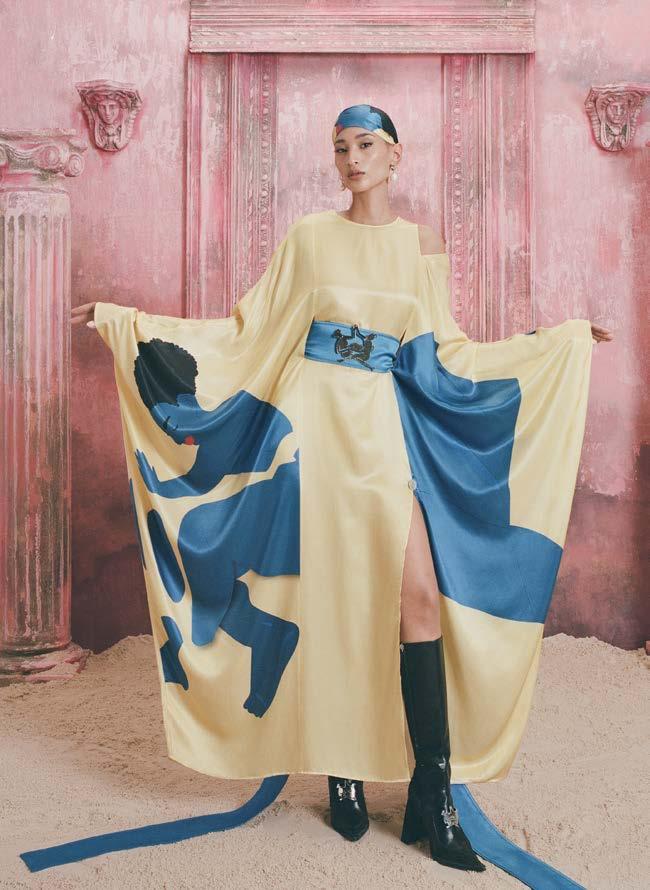
THEBE MAGUGU
Thebe Magugu had to fight for his place on the fashion stage: the South African was rejected from Central Saint Martins, enrolling instead at fashion school in Johannesburg. The launch of his label was beset with difficulties but, in 2016, Thebe Magugu the brand was born. The designer’s breakout moment came when he created a capsule collection for Woolworths, which was showcased at South African Fashion Week. In 2019, Magugu became the first African to win the LVMH Prize. Today, his bold prints, silky textures and retro-inflected silhouettes are known the fashion world over.
What sets Magugu apart, however, are the political narratives that he weaves (literally) into his designs. He might print family photos onto his garments or create a collection from the plastic travel bags commonly used by Ghanaians deported from Nigeria, as he did in 2022. So committed is Magugu to creating dialogues around his home continent that he is willing to make financial sacrifices to keep the business there, saying, “I want to give back to my country and keep the brand local for as long as possible.” thebemagugu.com


LUXURYLONDON.CO.UK
THEBE
COLLECTION
MAGUGU’S SS24
Killing Time

THE FORWARD-LOOKING HOROLOGISTS
CALLING TIME ON CONVENTIONAL WATCHMAKING
Words: Richard Brown
THE HOUSE THAT MAX BUILT
Maximilian Büsser is to horology, what Heston Blumenthal is to food. Whereas the pioneering multi-sensory chef strips back food in order to experiment with flavour, Büsser, formerly of Harry Winston, deconstructs traditional elements of watchmaking to create far-out time-telling ‘machines’ that challenge our notions of what a watch should, and can, look like.
Büsser’s latest creation, the Horological Machine Nº11 Architect, is inspired by the ‘bubble’ houses of the mid- to late-20th century, buildings by the likes of Wallace Neff and Oscar Niemeyer, which eschewed straight-line convention in favour of softer, rounder, more humanistic shapes. “Une maison est une machine à habiter,” as the Swiss architect Le Corbusier once said. “A house is a machine to live in.”
What, pondered Büsser, in a question you can’t imagine troubling too many other watchmakers, would a watch look like if it were a house? His answer, crafted in collaboration with watch and product designer Eric Giroud, is the eleventh ‘machine’ that MB&F – that’s Max Büsser and Friends – has created since the ‘horological concept laboratory’ was formed in 2005.
Four faces, or ‘rooms’, radiate from a central flying tourbillon housed under a double-domed sapphire roof. The time ‘room’ displays hours and minutes; the next acts as a power reserve indicator; the third houses a thermometer; the final contains a tiny MB&F battle-axe motif, which serves as the crown.
Choose which room you look at by rotating the entire ‘house’; each 45° clockwise turn delivers 72 minutes of power directly to the barrel. After 10 complete rotations, the HM11 is at its maximum autonomy of 96 hours (watches with a power reserve of 48 hours, by comparison, typically require between 20 and 30 full turns of the crown before they are fully wound).
Powered by a 364-component movement designed and developed by MB&F, the Nº11 Architect provides a new definition of that obsessed-over industry buzz-phrase, ‘in-house’.
POA, mbandf.com
LUXURY LONDON FEATURE
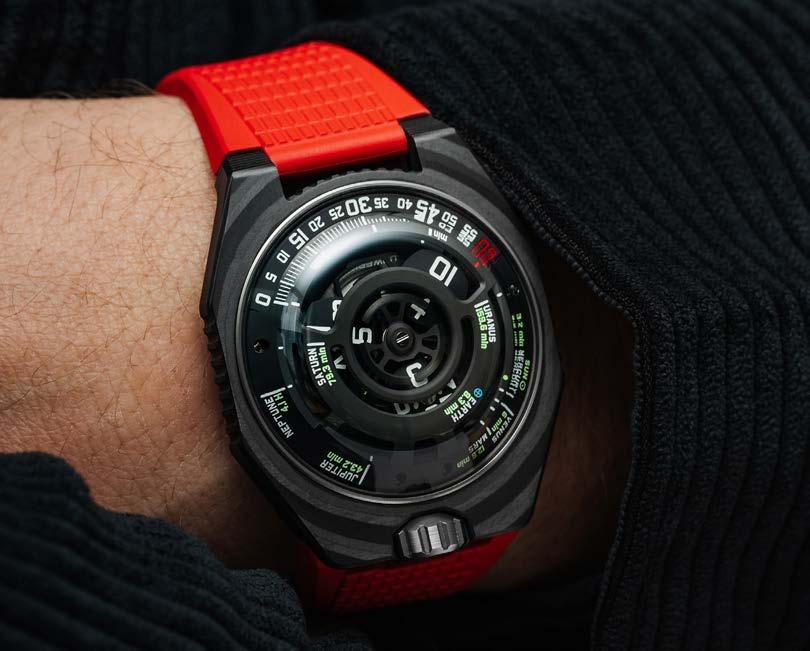
LIGHT YEARS AHEAD
Urwerk’s UR-100V LightSpeed is a watch from the future, or shou that be past? Providing a visual representation of the time it for sunlight to reach the planets of our solar system, the Ligh addresses our out-of-step relationship with the present; by the sunlight reaches us, the sun is already eight minutes and thirt into the future. Other stars are already dead. Looking at the n is to perceive a time, a past, that no longer exists. Handily, also tells the time down here on Earth, using three satellite d so – hands, presumably, being to Urwerk things of the past.
Approx. £57,900 (exc. taxes), urwerk.com

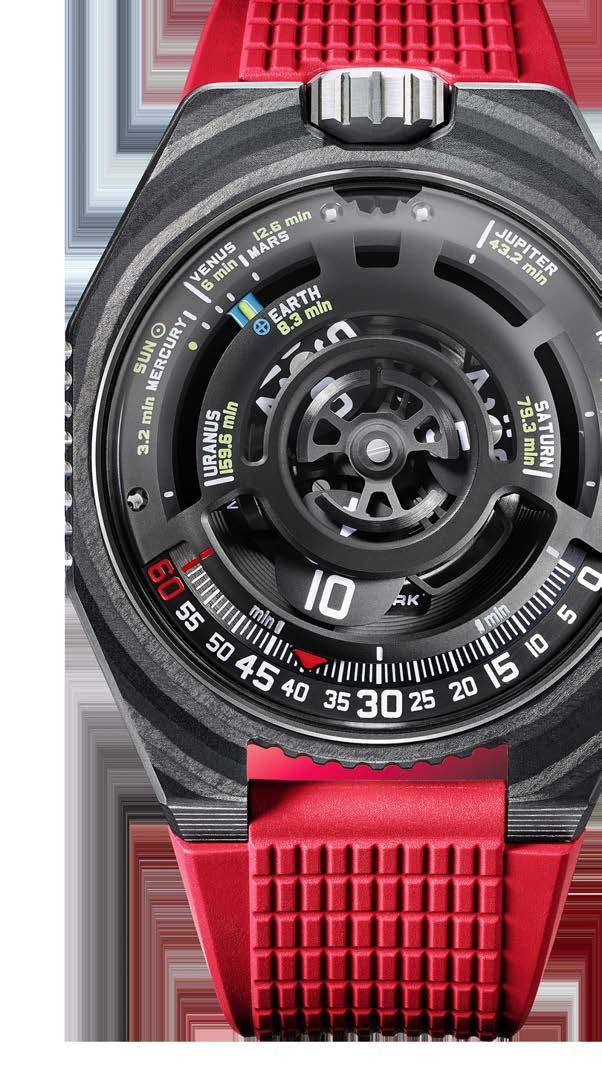
FROZEN IN TIME
Niche, for sure, but Roger Dubuis’ Knights of the Round Table collection has achieved something of a mythical standing since its inception in 2013 – appropriate, given the Arthurian legend that inspired the watch. The latest version, Ice and Fire, sees our 12 miniature, 18k rose-gold knights poised to do battle with whichever evil is about to break through the frozen lake below, where ice sheets are rendered from porcelain and freezing waters created from Murano glass.
Approx. £267,000 (exc. taxes), rogerdubuis.com
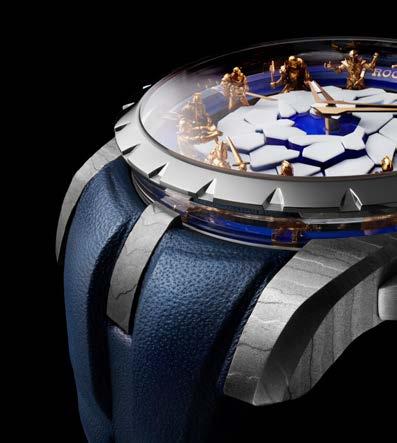
91 LUXURYLONDON.CO.UK

GOING WITH THE FLOW
Rescued from administration by a Swiss investment firm, and briefly under the stewardship of industry titan Davide Cerrato (previously of Tudor and Montblanc, currently of Bremont), HYT is back and firing on all of its fluorescentliquid-filled cylinders. The brand, established in 2012, has built a name for itself by using mechanical movements to push liquids through tubes in order to display the time. HYT’s latest Conical Tourbillon Titanium Blue features an inclined tourbillon at its centre, around which three spheres filled with blue liquid rotate around the dial at different speeds.
Approx. £298,000 (exc. taxes), hytwatches.com
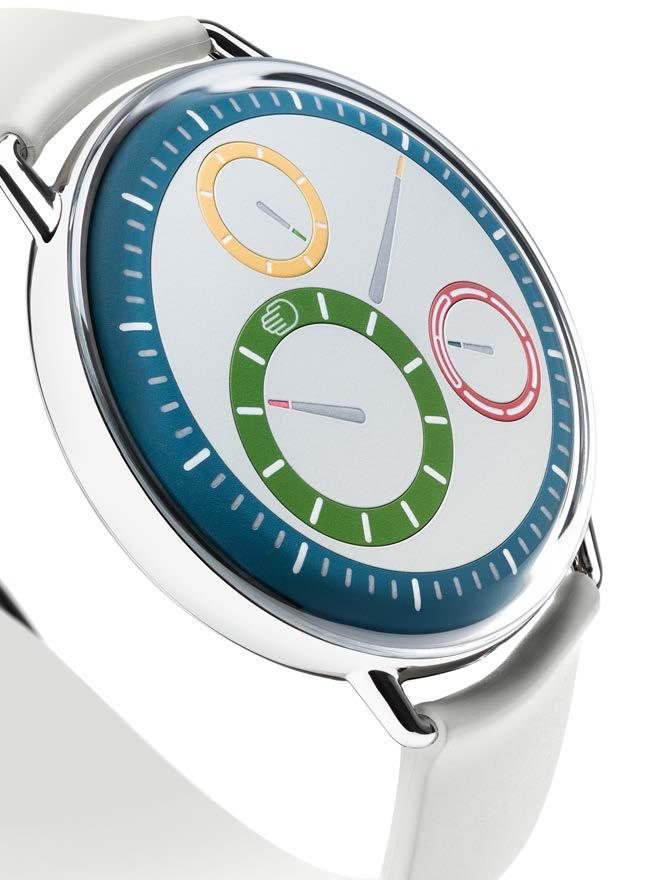


DIALLING UP THE COLOUR
Another forward-facing watch brand shunning traditionally centre-mounted hands is Ressence, which, since launching in 2010, has employed gracefully rotating disks to display hours, minutes and seconds as they orbit around their dials. Typically, however, Ressence watches have arrived in conservative, monochromatic colourways, in stark contrast to their otherwise decidedly contemporary styling. No longer. The recently revealed Ressence TYPE 1° M is now available with hour, minute, second and weekday discs in red, blue, yellow and green. Ensuring that each colour pops is an uncluttered German silver dial. A (brush)stroke of genius.
Approx. £14,950 (exc. taxes), ressencewatches.com
LUXURYLONDON.CO.UK
YOU ARE CORDIALLY INVITED TO
Luxury London Club
Luxury London Media organises and co-hosts exclusive events in collaboration with premium lifestyle brands in and around London.
From high-end property showcases to bespoke VIP personal shopping opportunities, experience our esteemed events for yourself.
To register for the opportunity to be invited to Luxury London Media’s upcoming events, please scan the QR code below.
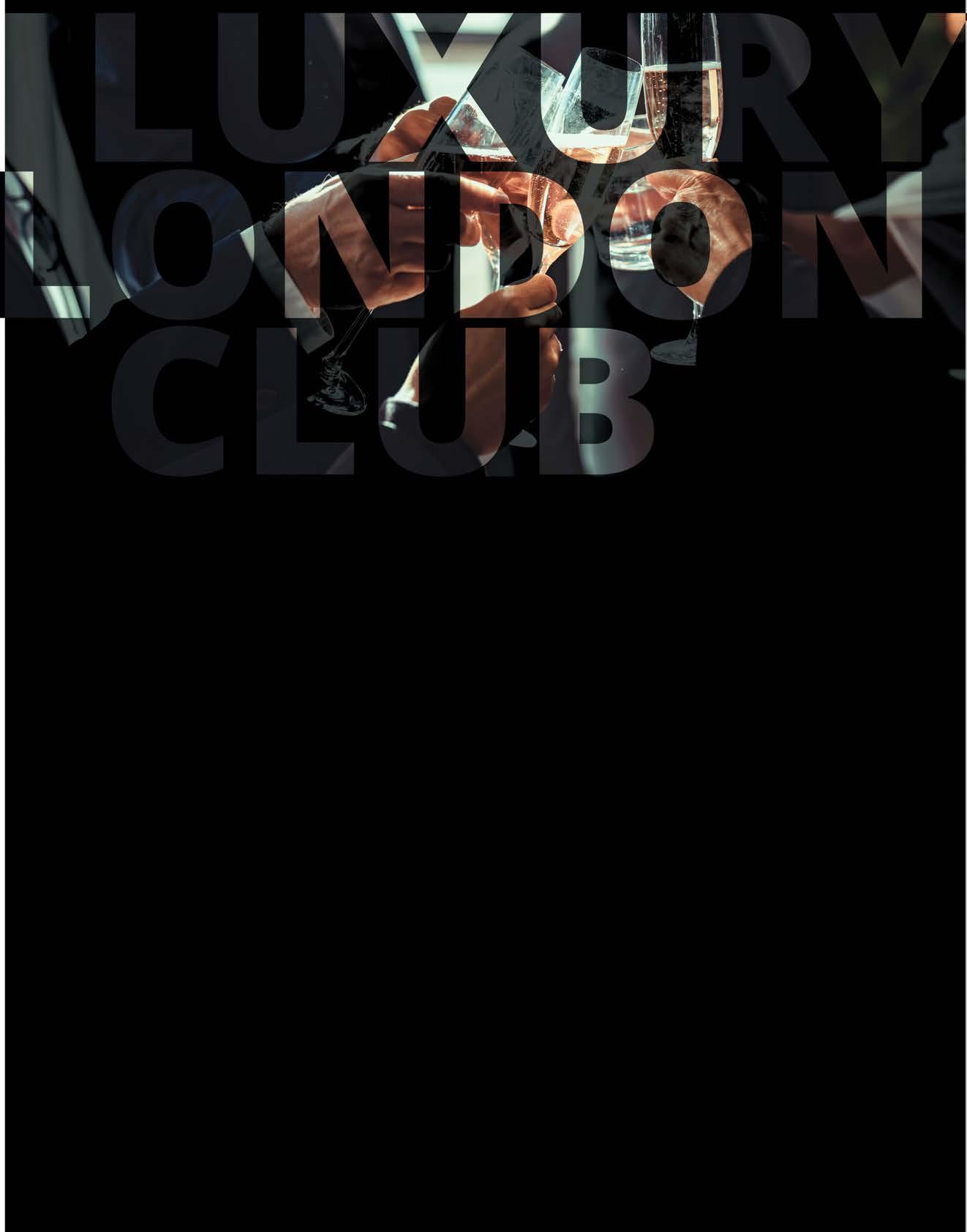
LUXURYLONDON.CO.UK/
LUXURYLONDONMEDIA LUXURYLONDONOFFICIAL LUXURYLONDONOFFICIAL THEOFFICIALLL
LIFESTYLE/EVENTS/LUXURY-
LONDON-CLUB-REGISTRATION
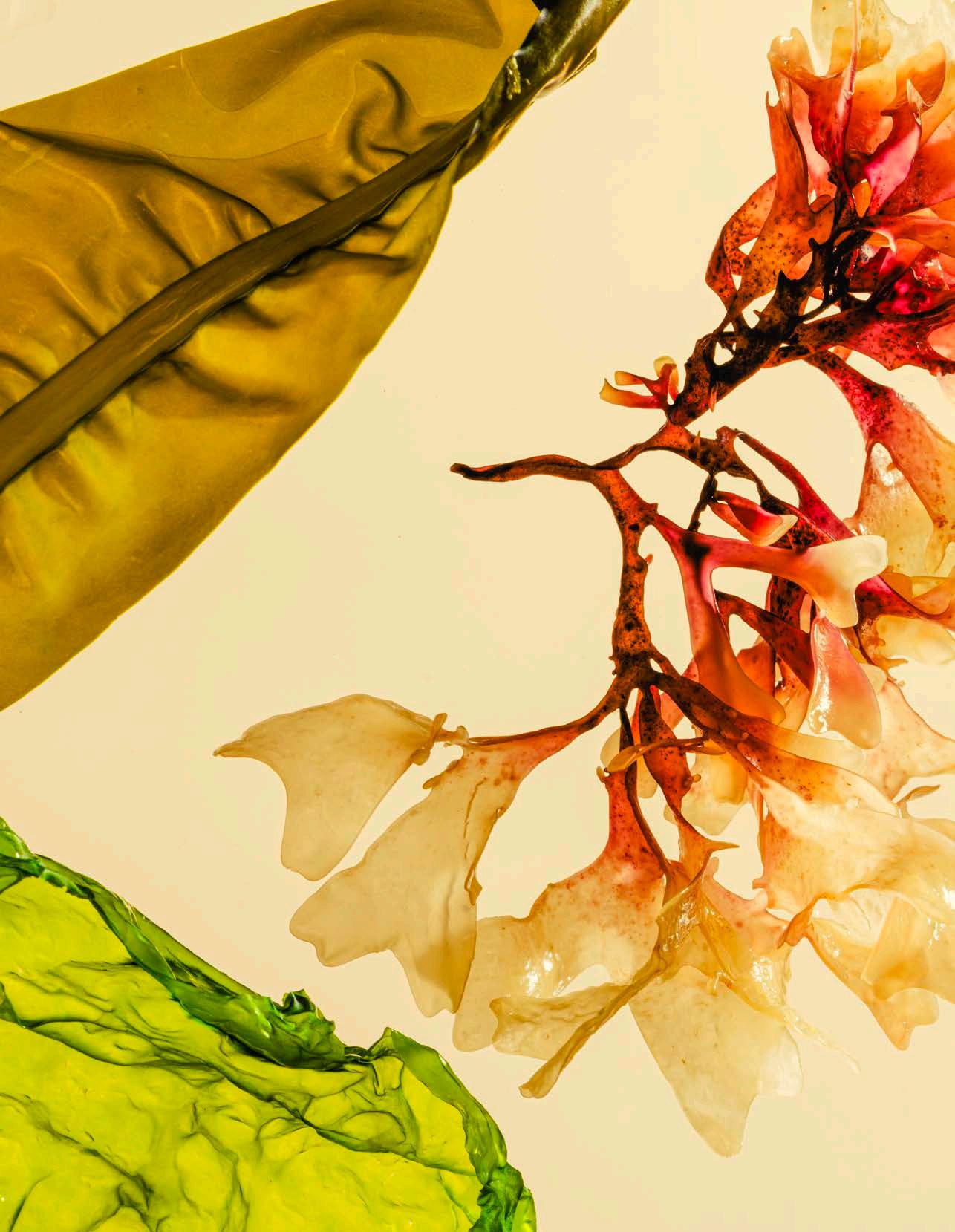
KEEL LABS

Cut from a Different Cloth
WOULD YOU WEAR A JACKET MADE OF MILK PROTEIN, OR A PAIR OF TROUSERS CONSTRUCTED FROM ALGAE? AS THE FASHION INDUSTRY FAILS TO WEAN ITSELF OFF FOSSIL FUELS, PREPARE TO ACCLIMATISE TO SOME UNLIKELY BIO-TEXTILES
Words: Josh Sims
95 LUXURY LONDON COUTURE LUXURYLONDON.CO.UK
When Charlotte McCurdy was confronted with the sobering fact that more than 60 per cent of textiles are made from fossil fuels, she decided that there must be – there had to be – an alternative. The California-based industrial designer, who now works at Stanford University’s Design School, set about developing a water-resistant raincoat made not from plastic, but from algae.
“The idea of sustainability in fashion is still trapped within an industrialisation framework – it’s about using fewer fossil fuels, or in a different way, and that’s not going to work,” says McCurdy, who, since the raincoat, has worked with fashion designer Phillip Lim to develop a dress made of the same plastic-like material, right down to creating the first algae-based, biodegradable sequins. “We need to be considering materials that at least have the potential to be carbon negative.”
McCurdy is not alone in exploring the potential of bio-textiles, as they’re called. New York-based biomaterials research company AlgiKnit, for example, is developing compostable yarns from biopolymers that can be turned into textiles. It uses kelp – a brown seaweed that’s already used as an emulsifying agent in foods and cosmetics, but which also happens to be one of the fastestgrowing organisms on Earth – to create a yarn that is strong and elastic enough to be knitted by hand or machine.
Keel Labs is another start-up producing bio-textiles; in this case, a soft, smooth fibre it calls Kelsun, made from the abundant natural biopolymer found in seaweed. Roya Aghighi, a Toronto-based ‘design investigator’, has developed Biogarmentry, a proof-of-concept clothing textile made from algae that actually turns carbon dioxide into oxygen via photosynthesis. To make the textile, a single-cell green algae is spun together with nano polymers, the resulting cloth being bonded to form a garment.
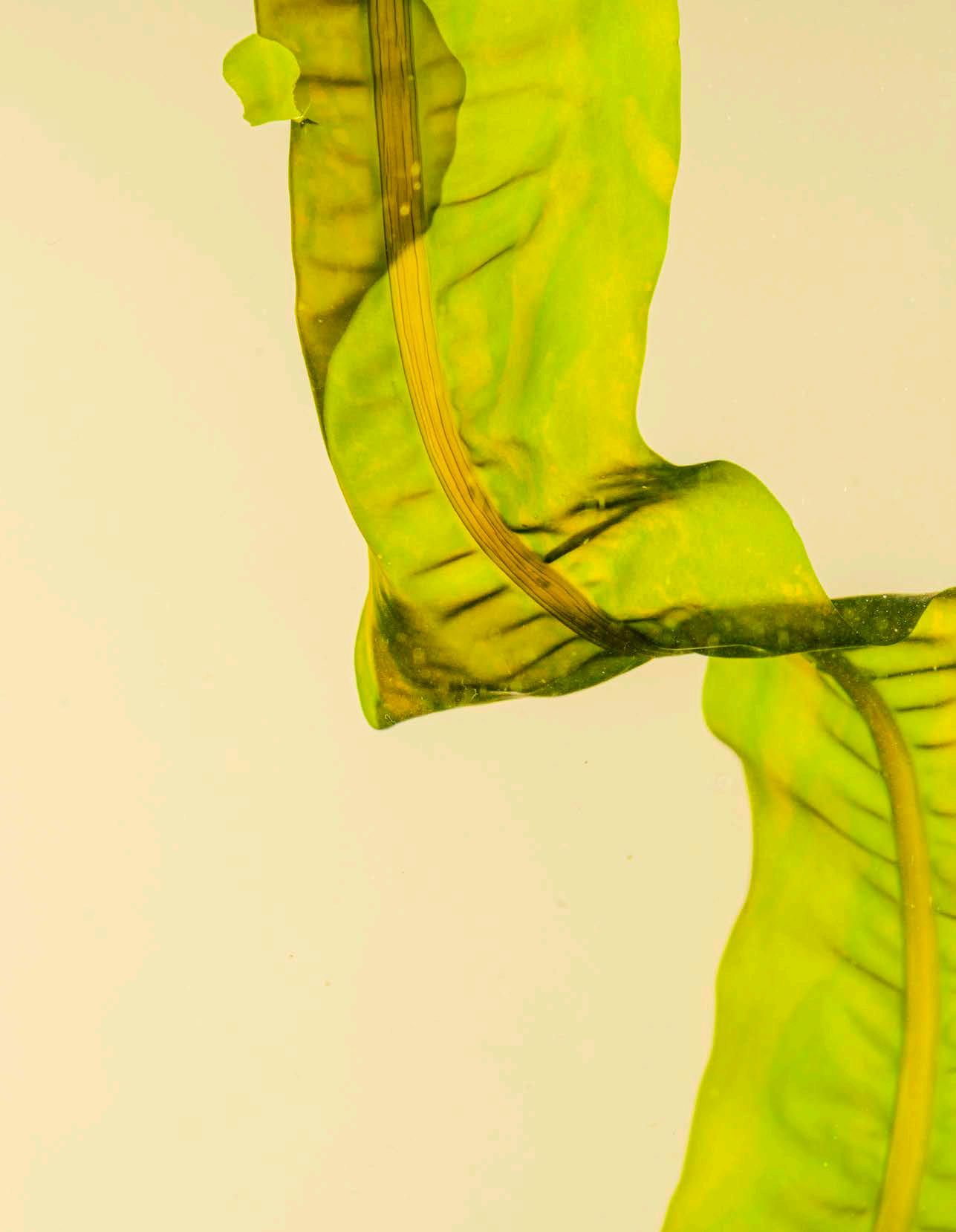
The approach to clothing that Biogarmentary proposes is radical: each of its garments, which are in some sense ‘alive’, has a life cycle of a few months, before being composted. “We don’t typically think deeply about our clothing,” Aghighi says. “I think we’d be less likely to toss a shirt that was ‘alive’ into the washing machine or closet. We’d have to tend to it. It would be a dependent being, like your house plants or pets. And, just as people don’t tend to have 10 pets, you may be inclined to cherish the one or two living garments that you have, rather than over-consume.”
It’s not just algae and seaweed paving the path to bio-textiles. Bio-design technology company Modern Meadow has found a way of fermenting yeast cells to make a product that closely imitates leather. Anke Domaske, a microbiologist based in Hanover, has developed a fibre called QMilk by processing the casein protein in the cow’s milk deemed unfit for human production – some 1.9 million tonnes of it is produced each year in Germany alone.
In fact, says Domaske, her technology is an update of a method first developed
KEEL LABS
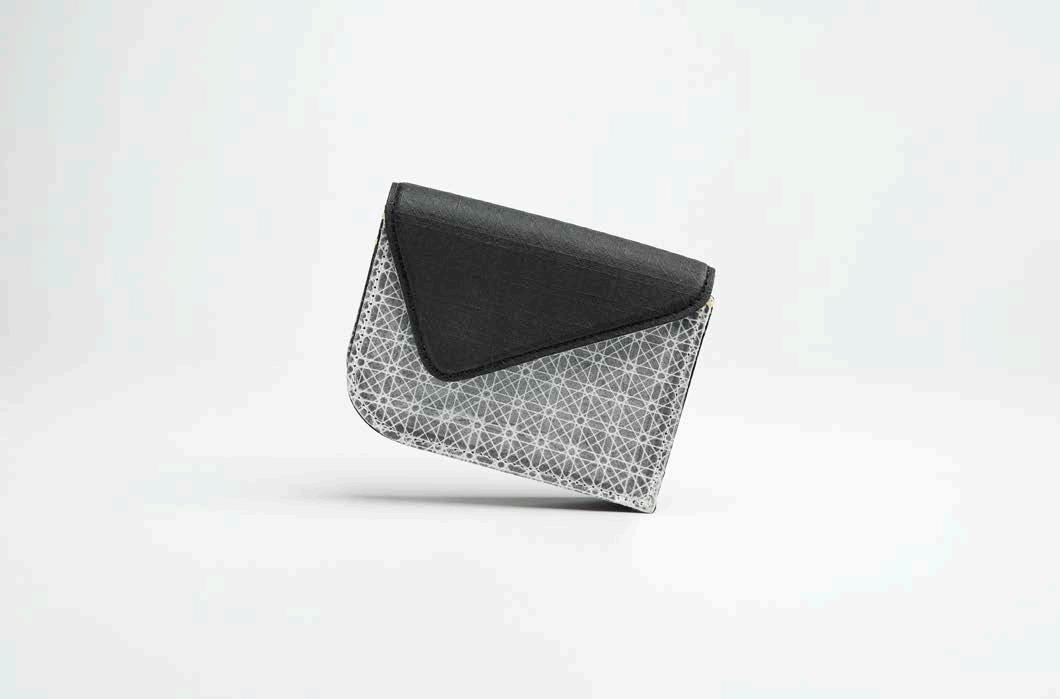
A PROTOTYPE WALLET CRAFTED WITH MODERN SYNTHESIS’ BACTERIA CELLULOSE-BASED TEXTILE, DEMONSTRATING THE BIOMATERIAL’S VIABILITY FOR ACCESSORIES AND PRODUCT APPLICATIONS
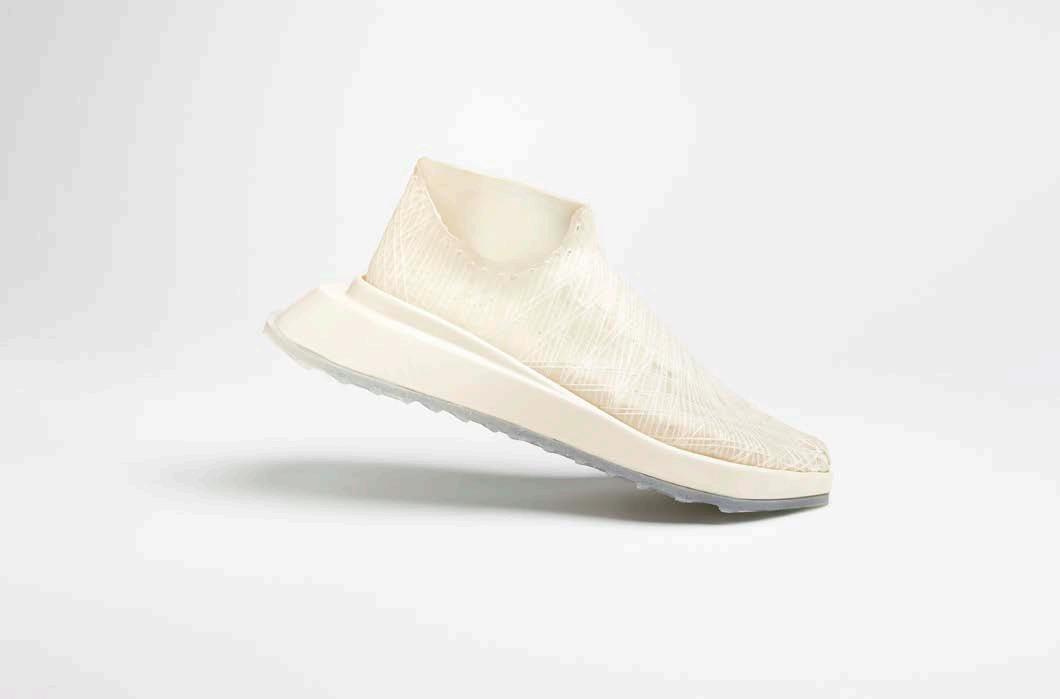
JEN KEANE, FOUNDER OF MODERN SYNTHESIS, CREATED AN UPPER FOR AN ATHLETIC SHOE BY GROWING BACTERIAL NANOCELLULOSE THROUGH ONE CONTINUOUS YARN
97 LUXURY LONDON COUTURE LUXURYLONDON.CO.UK

in the 1930s, which was discontinued in favour of the ease and low cost of polyester. Like many potential bio-textiles, QMilk has various promising properties: while it can be turned into 100 per cent milk-based cloth, it also blends invisibly with wool or silk; it wicks moisture and is temperature regulating; it has the tensile strength of wool; and it’s both inflammable – and could thus be used in upholstery – and anti-bacterial.
“There are plenty of old, forgotten notions like this out there that need to be revisited,” says Domaske. “As a society, we use a lot of chemicals, but don’t look into the benefits of natural products already there. Or, we don’t think enough about the potential of waste products as a resource of value – it just needs to be explored.”
So far, so tempting, and the list of possibilities goes on: Jen Keane – ex-materials designer for Adidas and co-founder of textiles company Modern Synthesis – has developed a form of
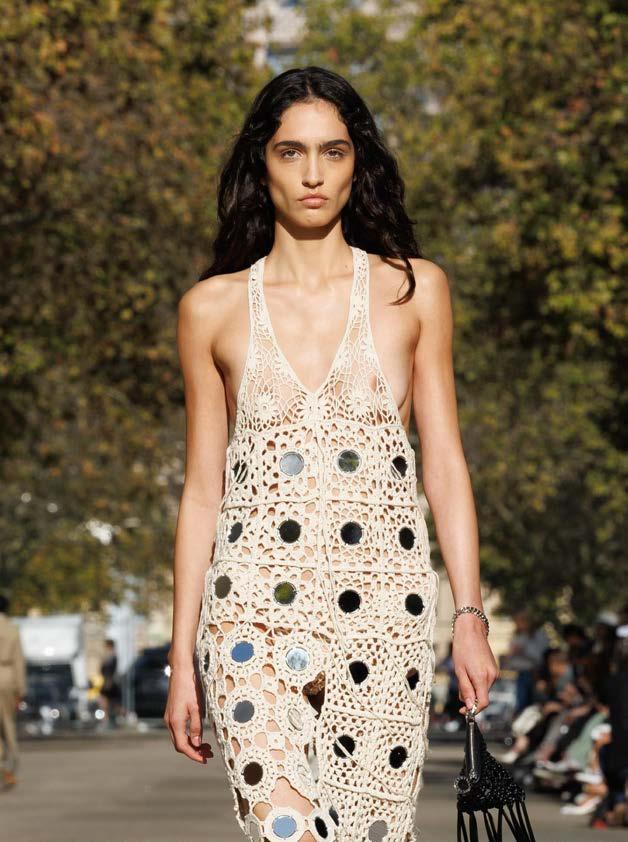
‘microbial weaving’ using a specific strain of bacterial cellulose to create a strong, lightweight and fully recyclable hybrid material that is grown, rather than spun or woven. One of her test samples, a single-piece shoe upper, demonstrates this new approach – one which, she argues, also circumvents the problem of plant-based textiles (that growing the necessary plants may not be the best use of land or energy).
“We need to work with biology to develop textiles, to think about new ways in which textiles can be made – that approach has seen a huge growth in bio-textiles over the last three years,” explains Keane. “Now, every major brand is making a public statement about reducing their environmental impact through better raw material choices, where a lot of that impact happens. There’s now a wide variety of different bio-textiles, but we need to be able to scale up so we can make these new materials at prices that make sense.”
As Keane observes, there’s a bottleneck approaching: if every bio-textile start-up scaled up, the production still wouldn’t come close to meeting the demand of the fashion industry. And that’s not the only hurdle. McCurdy adds that, while the industry has a long history of being at the forefront of technology, from weaving during the Industrial Revolution to modern computing, bio-textiles have struggled to get backing from venture capitalists or major fashion companies. Although it bodes well that AlgiKnit secured $13 million in funding last year, she still laments that “it’s still just so much easier to [get funding] for some kind of software project”.
Then there’s the question of acceptance – that, undoubtedly, the prospect of wearing bacteria might be a turn-off for some. Keane points out that many of the fibres we wear today have been around for centuries, and a shift in public consciousness will be required to appreciate biotextiles. “It has certainly been a concern among brands that people wouldn’t be comfortable with the idea of, for example, wearing a microbialbased cloth, even though yoghurt is a live culture, and we eat that!” she laughs. “We will need to not think about bio-textiles as alternatives, but as completely new kinds of textile.”
We may not have the luxury of squeamishness. The fashion industry is responsible for the production of up to 10 per cent of global carbon dioxide emissions, and one fifth of the 300 million tons of plastic that we produce each year, according to the United Nations Environment Programme. We’re going to have to start thinking about what we consume, and how, sooner rather than later.
It looks like yeast jumpers and seaweed T-shirts might soon be in vogue.
98 LUXURY LONDON COUTURE LUXURYLONDON.CO.UK
STELLA MCCARTNEY X KEEL LABS PARIS FASHION WEEK SHOW CREDIT: ISODORE MONTAG

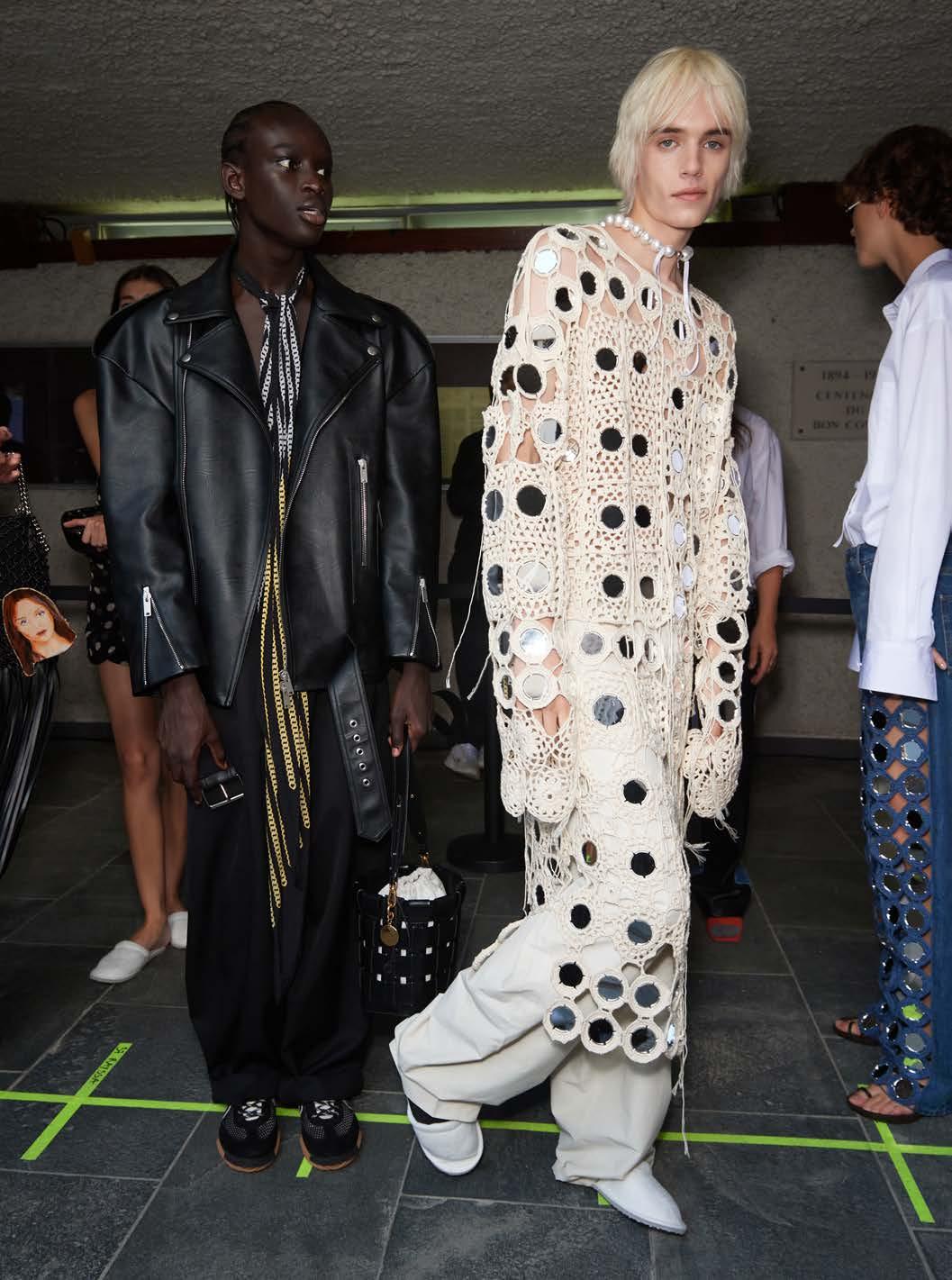

99 LUXURYLONDON.CO.UK
X
PARIS FASHION WEEK SHOW
BACKSTAGE
AT THE STELLA MCCARTNEY
KEEL LABS
CREDIT: JAMES COCHRANE
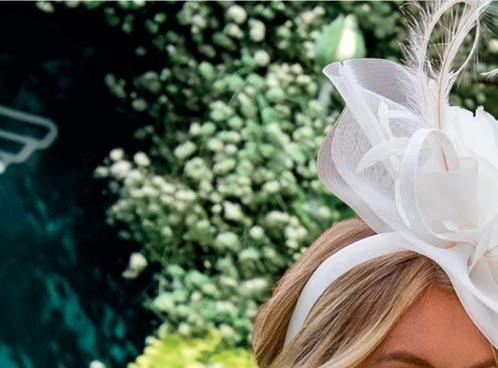
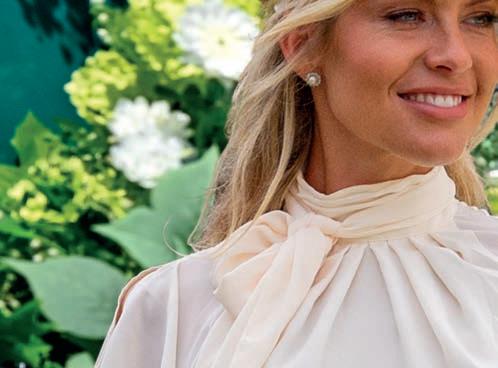
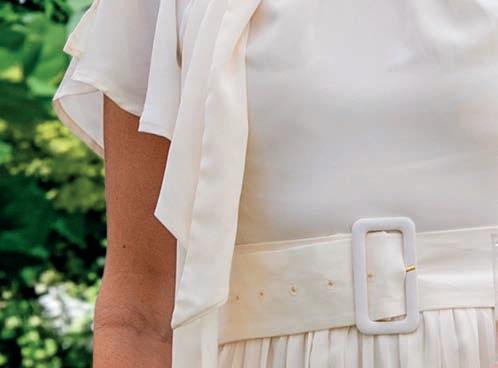


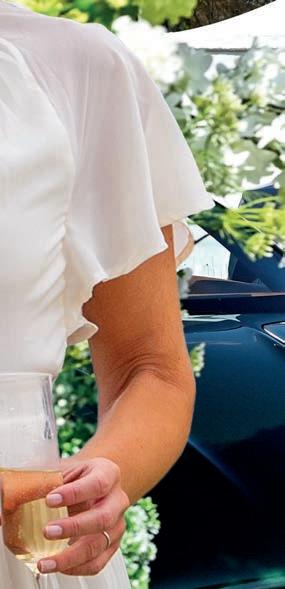






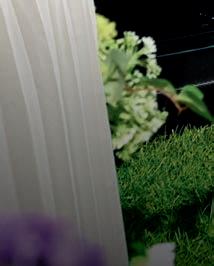




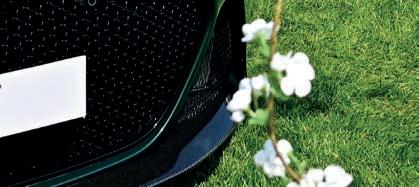
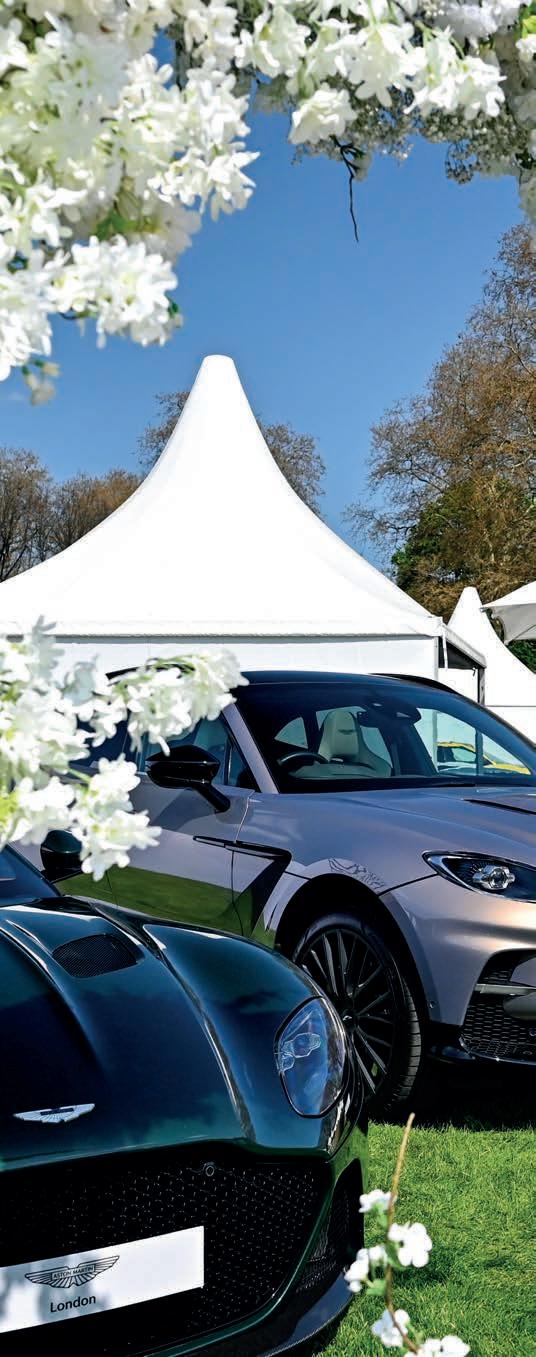



Sponsored by


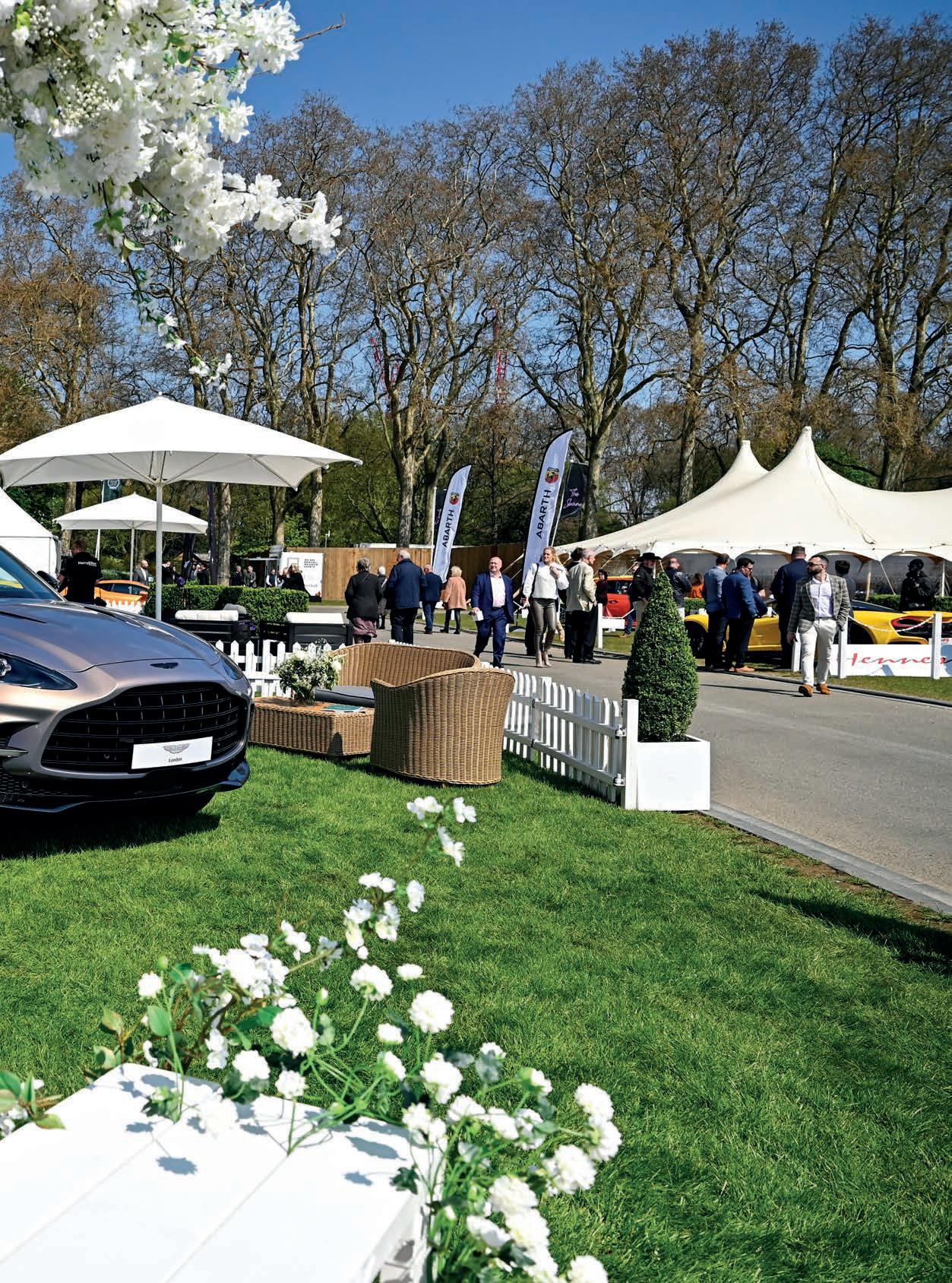





18–20 APRIL 2024 ROYAL HOSPITAL CHELSEA
AN AUTOMOTIVE GARDEN PARTY IN THE HEART OF CHELSEA
Returning for its third year, Salon Privé London is a luxurious automotive garden party hosted in the stunning grounds of one of London’s most iconic landmarks, Royal Hospital Chelsea.
Kick-starting the UK Season in spectacular style, the event runs for three days with the lawns packed full of the latest super, luxury and classic cars (all of which are for sale), specially curated celebration displays and a collection of luxury brands that includes everything from boats, bikes, helicopters to fashion, jewellery, art and antiques.
Daily parades and awards presentations, the finest hospitality, Pommery Champagne and London Essence cocktails alongside a delicious selection of street foods and bars all add up to an unforgettable day out.
SCAN FOR TICKETS SALONPRIVELONDON.COM
Image: Noel Skeates



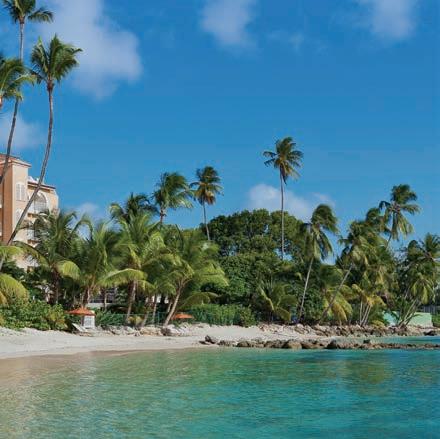



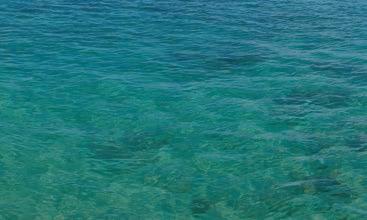
Paradise,Within Reach Disco v er the ceru l ean w av esandwhi te san d beaches ofBarb a do s’Pl atinu m Coas t at Saint Pe ter’s Bay, the p remiergene r ational de s tina t ionfor resortli v ing inthe Caribbean A nons top flight f romL ondon, Sa int Pe t er’s B ay affo rds unobstruc t ed oceanf ront view s, enviable amenitiespac kag e, andtu rnkey furnishin gs. Three-bed room, th ree-bath roo mv il la s f rom£1.35 M SPBLiving.com | +1 246.836.116 6 S AI NTPETER’ S BAY L UXU RY RESO RT & RES I DE NC ES B AR BADOS This does not constitute an offer to sell or a solicitation to buy a unit. Nor is it an offering of solicitation of sale in any jurisdiction where development is not registered in accordance with applicable law or where sug offering or solicitation would otherwise be prohibited by law. Obtain all disclosure documents required by applicable laws and read them before signing anything. No governmental agency has judged the merits or value, if any, of the development.
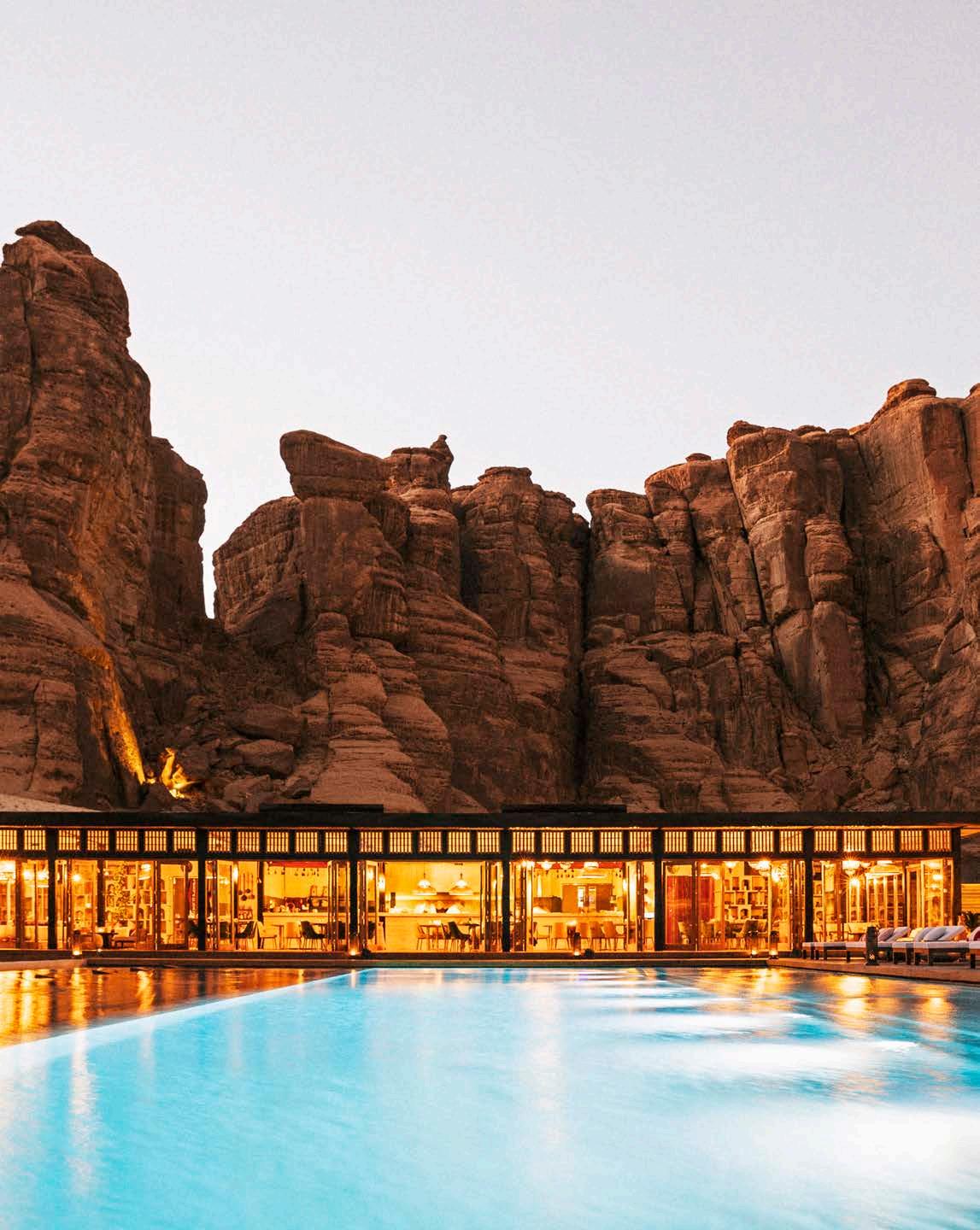
TO STRIVE, TO SEEK, TO FIND...
104 Where to Stay in 2024 This year’s hottest new hotels 114 AlUla Opens Up The ancient appeal of Saudi Arabia’s sacred oasis 122 Swinging Sydney Australia’s celebrated surf city is reinventing itself as a thoroughly modern metropolis
Escape HABITAS ALULA, A LUXURY ECO RESORT OF 96 ROOMS SET IN THE ASHAR VALLEY CANYONS NEAR HEGRA, SAUDI ARABIA’S FIRST UNESCO WORLD HERITAGE SITE, P.114
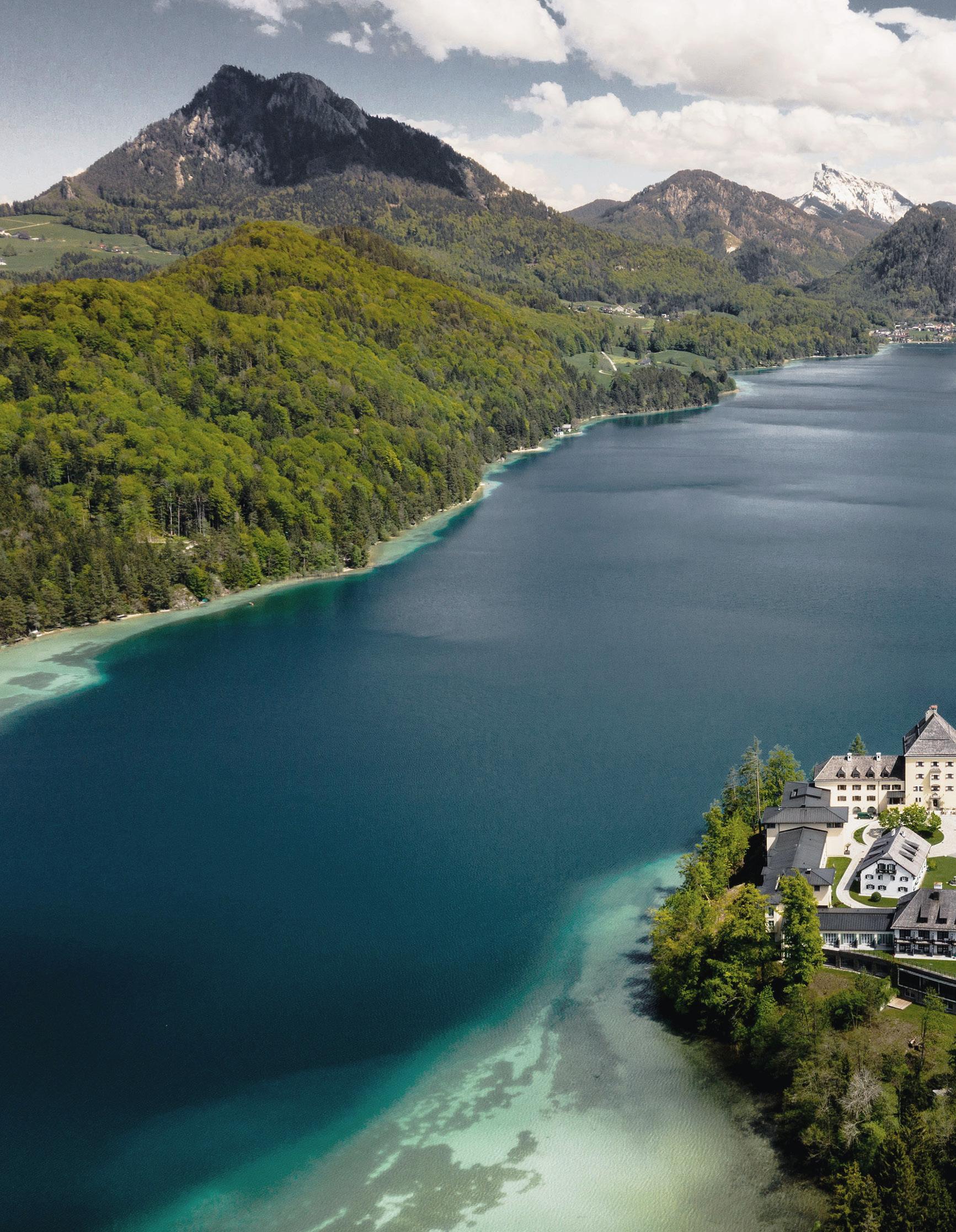
The Hot List
THE HOTEL OPENINGS TO KNOW ABOUT IN 2024
Words: Zoe Gunn
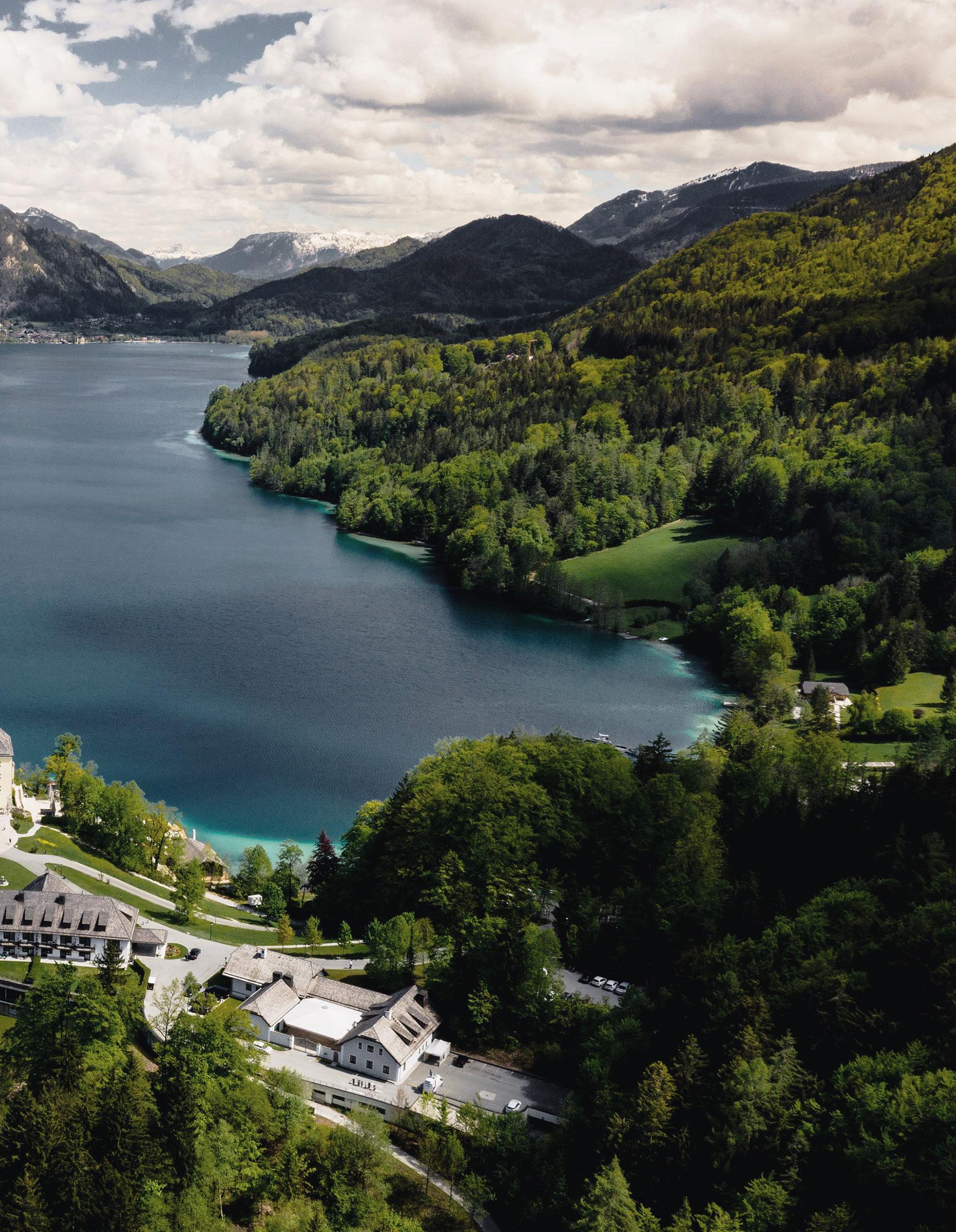
ROSEWOOD SCHLOSS FUSCHL, SALZBURG, AUSTRIA
OPENING: Summer 2024
ROOM RATE: To be confirmed
Hotel Schloss Fuschl, the historic, lakeside estate in western Austria, will reopen as the Rosewood Schloss Fuschl in 2024. While details are currently scant, the reimagined hotel will make use of the property’s 15th-century castle, built in 1450 for the Prince-Archbishopric of Salzburg to be used as as a hunting lodge, before being turned into a hospitality venture in the 1950s. Accommodation will include 98 rooms, 46 suites and six standalone chalets, while the hotel will also be home to Rosewood’s signature wellbeing concept, Asaya, with indoor and outdoor swimming pools, as well as a spa and gym.
rosewoodhotels.com


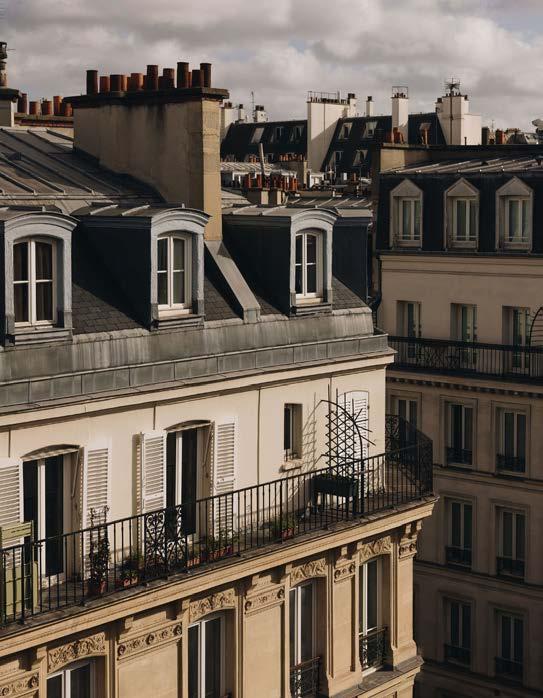
HÔTEL DES GRANDS VOYAGEURS, PARIS, FRANCE
OPENING: Now open
ROOM RATE: From £258 per night
This new Parisian hotel, situated in the vibrant Left Bank Quartier of Saint-Placide, in the French capital’s sixth arrondissement, has opened its doors to reveal 138 rooms inspired by the golden age of travel and designed by the internationally-renowned Fabrizio Casiraghi (Bagatelle Beach Club, Mykonos; Hotel La Ponche, Saint Tropez; Luigi Restaurant, Cannes). The property, a former Holiday Inn, is now filled with a curated selection of art and antiques, which pay homage to the antique dealers of St-Germain-des-Prés and include lithographs from Gustav Klimt and Marc Chagall, bespoke mirrors by artist Osanna Visconti di Modrone, and bas-relief sculptures by François Gilles. Casiraghi has created an intimate space that draws from a rich colour palette, with low lighting and plenty of wood panelling. Discover a chic brasserie restaurant serving French classics, a clandestine bar, an AvantGarde-style gym, and elegant bathrooms stocked with products by Diptyque.
hoteldesgrandsvoyageurs.com
106 LUXURYLONDON.CO.UK
ONE&ONLY KÉA ISLAND, GREECE
OPENING: April 2024
ROOM RATE: From approx. £1,500 per night
A hop, skip and high-powered speedboat from Athens, the new One&Only Kéa Island promises to be one of Greece’s most luxurious hotels. Boasting all-villa accommodation across 25 bungalows, 18 residences and two stand-out villas, as well as 14 One&Only Private Homes for those looking to make their holiday a more permanent affair, hole up here for a truly off-the-beaten-track experience.
Villas are designed to offer seamless indooroutdoor living in keeping with the natural landscape of Kéa Island, one of the few selfsustaining islands in the Cyclades, with organic seasonal produce, including vegetables, fruit, meat and honey, sourced on the island. Spend your days hiking, swimming, sailing or sunbathing at the onsite beach club before retiring to the hotel’s Greek Taverna restaurant, speakeasy bar, Providore restaurant or lobby lounge for general merriment in the evening.
oneandonlyresorts.com
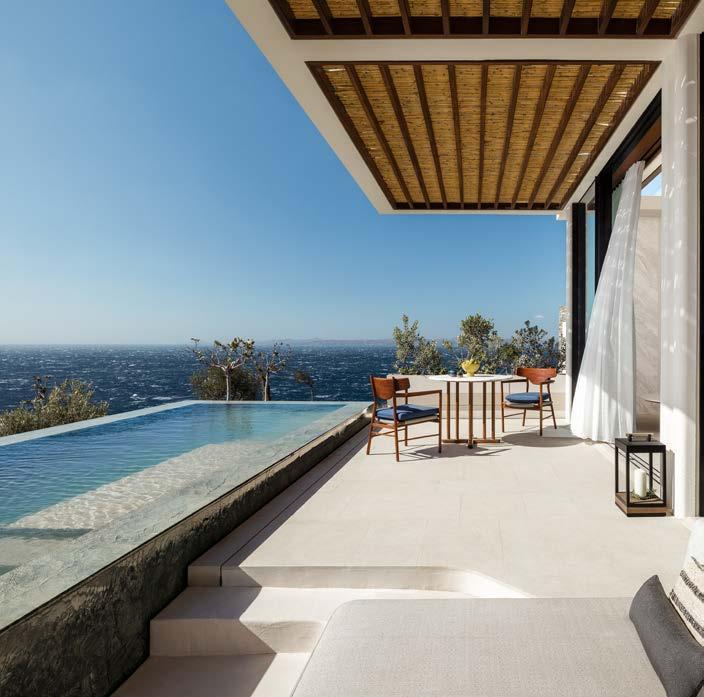
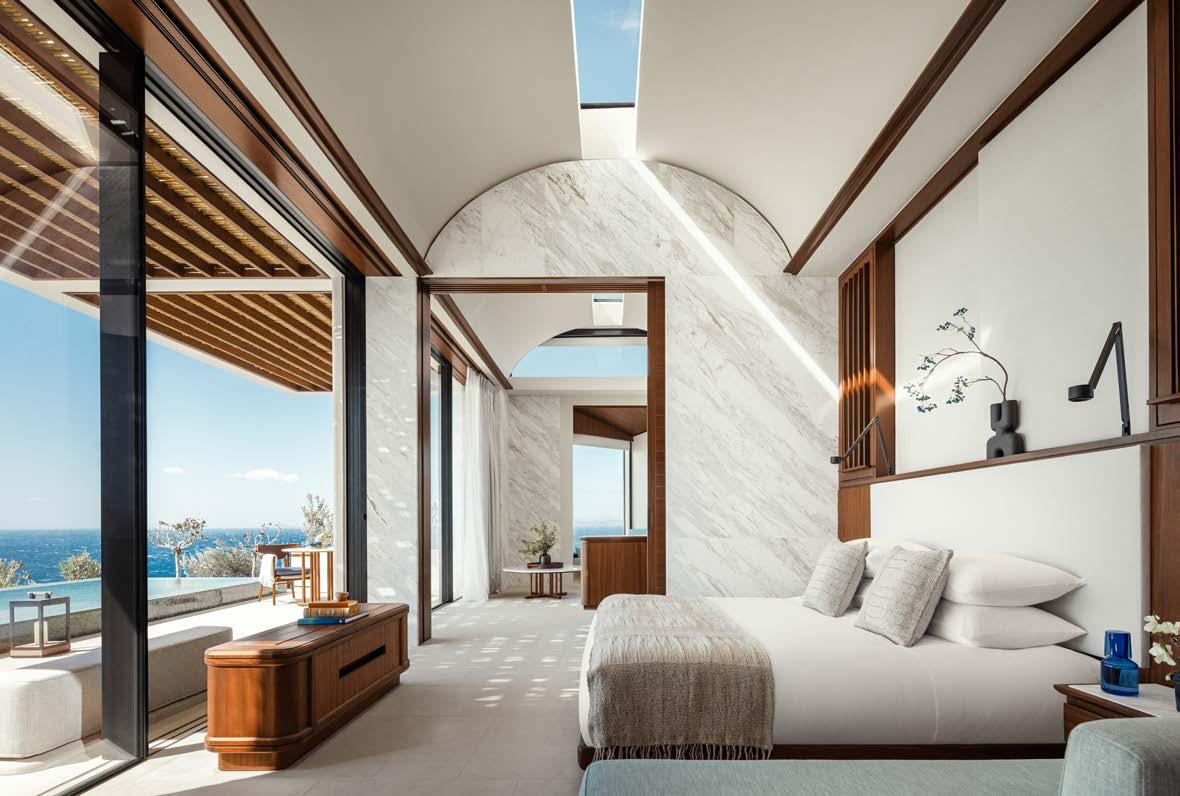
LUXURY LONDON ESCAPE
GUNDARI, FOLEGANDROS, GREECE
OPENING: May 2024
ROOM RATE: From £520 per night
Set in 100 acres of breath-taking open land on Folegandros, one of the lesser-known Cycladic islands, around 45 minutes via boat from Santorini, Gundari is a privately-owned hotel founded by Ricardo Larriera, whose family go back several centuries on the island. Promising an authentically Greek experience, and with sustainability at its heart, each of Gundari’s 25 neutrally-toned suites and two villas work with the local climate to improve energy efficiency and harness solar power to heat their private infinity pools.
Guests will find a stunning cliff-edge pool with swimup bar, gym, organic farm with wine bar, and a farmto-table restaurant designed by Michelin-starred chef Lefteris Lazarou. A subterranean spa draws on Ancient Greek healing traditions, using native herbs and remedies for a unique relaxation experience.
gundari.com
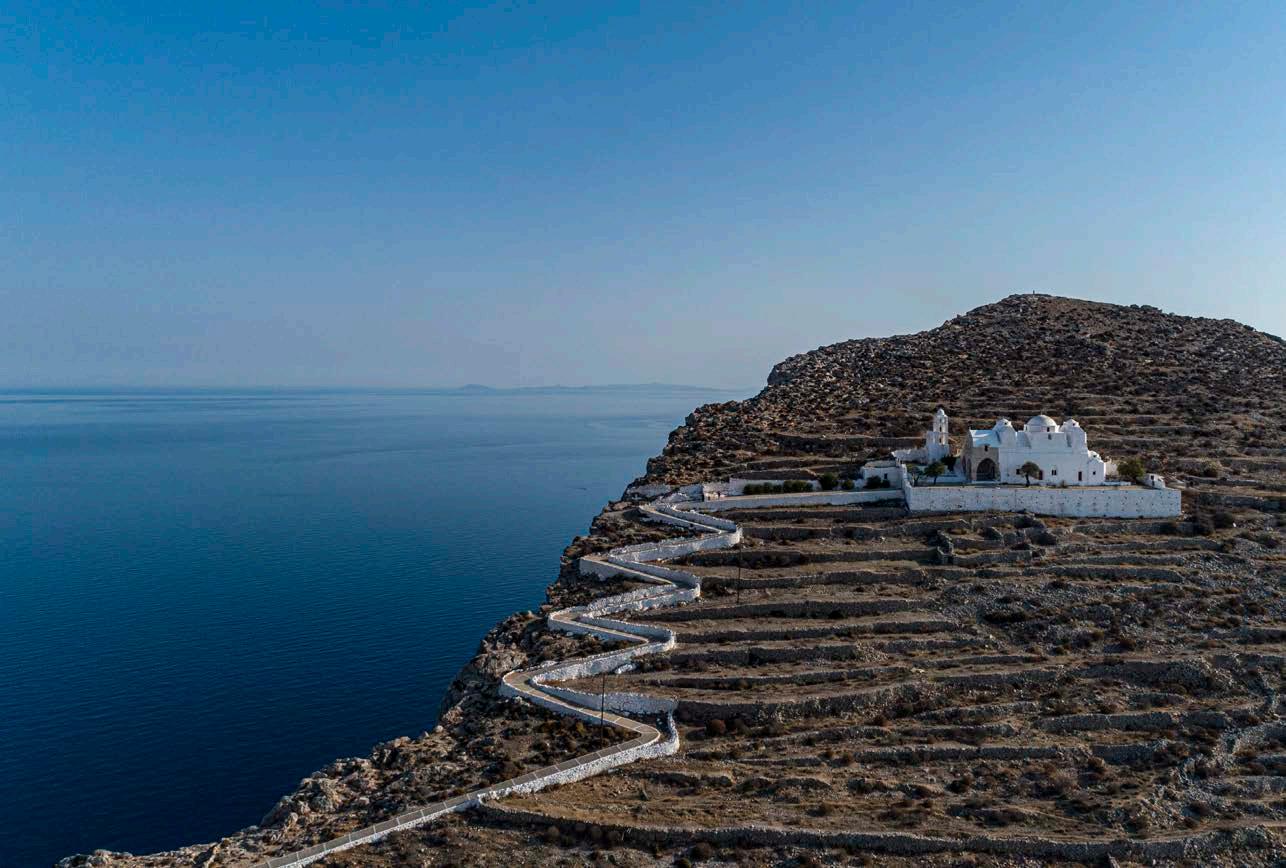
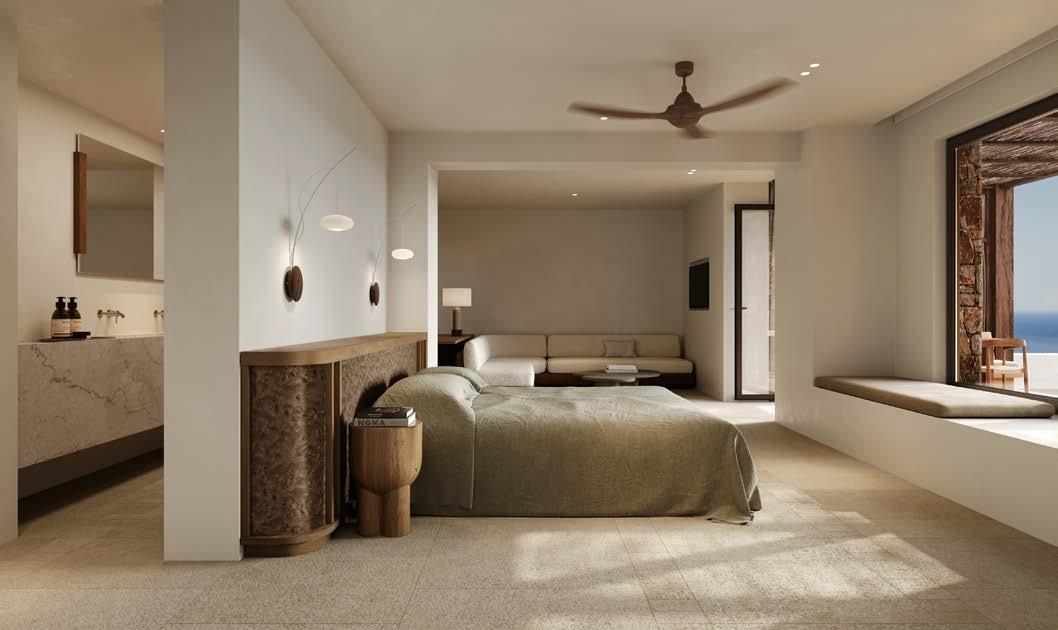
108 LUXURYLONDON.CO.UK
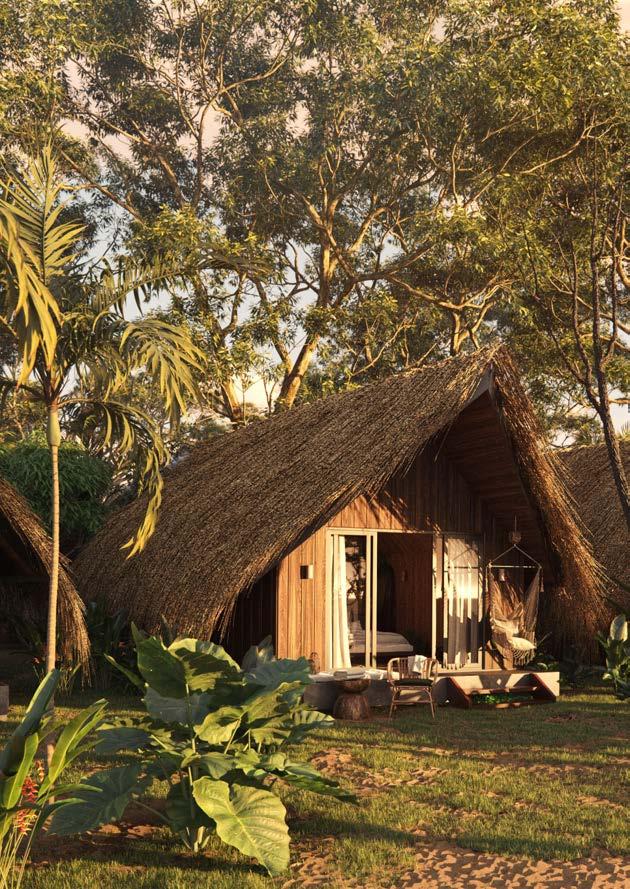
OUR HABITAS SANTA TERESA, COSTA RICA
OPENING: April 2024
ROOM RATE: From £560 per night
Costa Rica, with its rainforested topography, rugged volcanoes, and massive biodiversity (a quarter of its landmass comprises protected jungle), is synonymous with adventure holidays, and this is where the new Our Habitas hotel comes into its own. Nestled in said jungle, right in front of one of the region’s best surf breaks on Playa Santa Teresa, Our Habitas Santa Teresa offers guests bucket-list activities like exploring waterfalls while trekking through the Cabo Blanco Nature Reserve, as well as relaxation options including treatments that blend science and spirituality. The menu at the hotel restaurant, Suawe (which means ‘Exquisite’ in the indigenous Bribri language), showcases the region’s flavours and combines them with age-old Costa Rican wood-fired cooking techniques. ourhabitas.com


109 LUXURY LONDON ESCAPE LUXURYLONDON.CO.UK
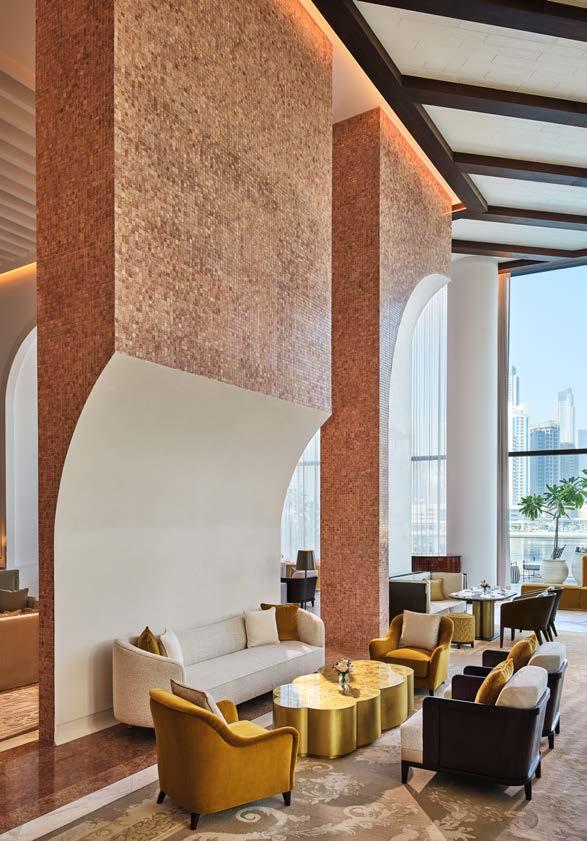
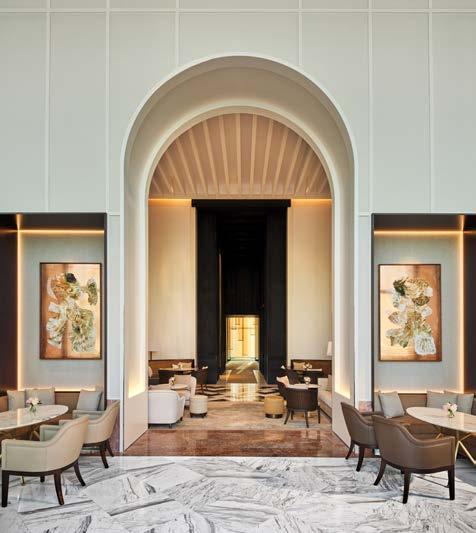
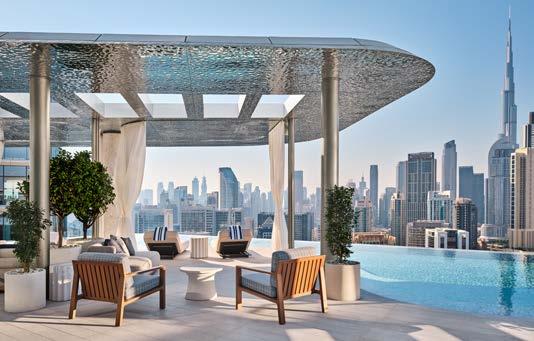
THE LANA, DUBAI
OPENING: Now open ROOM RATE: From £735 per night
The Dorchester Collection’s first address in the Middle East, The Lana, is one the most highly-anticipated Dubai openings in 2024. Located in the heart of Downtown Dubai, overlooking the Business Bay area, The Lana is home to 225 guestrooms and suites alongside opulent residences, all designed by architect Foster + Partners and with interiors by Gilles and Boissier. The Lana will also host a unique culinary collaboration between three famed chefs – Martín Berasategui, Jean Imbert and pastry chef Angelo Musa – to create four new dining concepts, alongside another four restaurants operated by the hotel itself. There’s also a rooftop swimming pool and bar, offering excellent views across the city and desert beyond.
dorchestercollection.com

110 LUXURY LONDON ESCAPE LUXURYLONDON.CO.UK
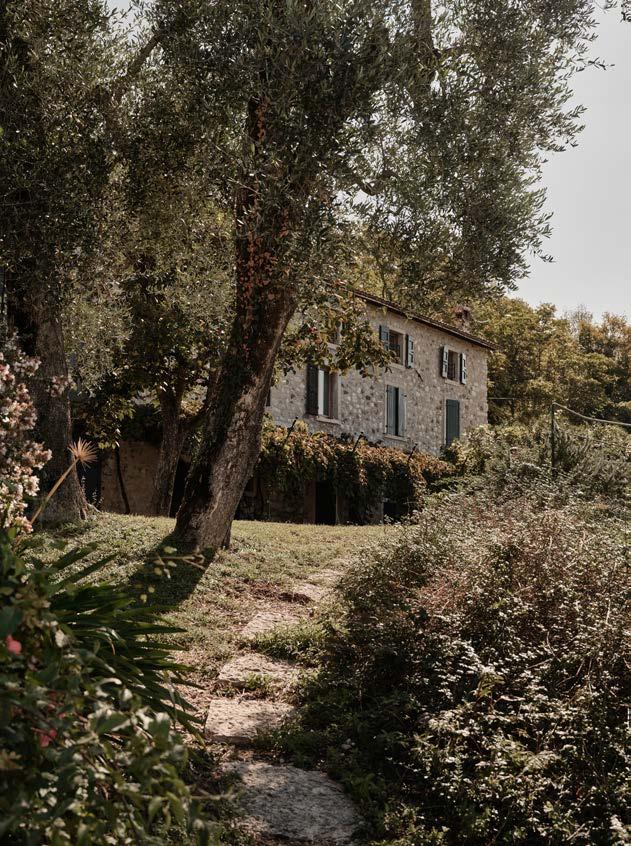
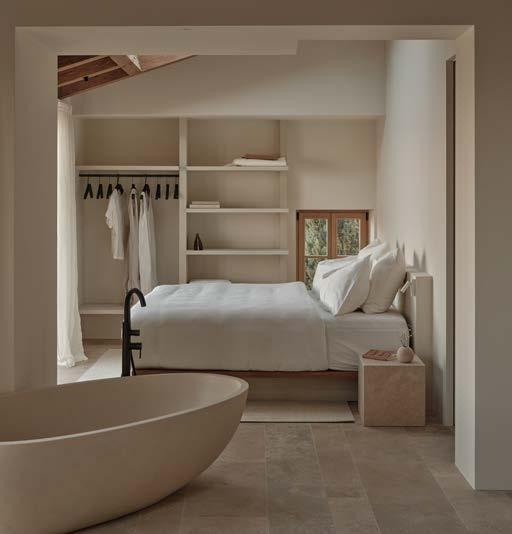
BORGO TRE, LAKE GARDA, ITALY
OPENING: March 2024
ROOM RATE: From approx. £520 per night
Set among the rolling hills of Torri del Benaco, overlooking Lake Garda, Borgo Tre is housed in a renovated 18th-century farmhouse, promising an elegant blend of modern luxury and rustic simplicity. The views are the star of the show and each of Borgo Tre’s suites, built and designed by local craftspeople, boasts panoramic vistas of the lake and the mountains beyond.
Sitting somewhere between hotel and rental accommodation, Borgo Tre offers just six elegant suites sleeping between two and five people and equipped with private amenities, including kitchens, dining rooms, open fireplaces, jacuzzis and gardens. Elsewhere, you’ll find a yoga terrace, outdoor swimming pool with cabanas, a Finnish sauna and spa. And, while there’s no restaurant on-site, close proximity to Torri del Benaco’s Old Town means you’ll never be left wanting for fine Italian cuisine.
borgotre.com
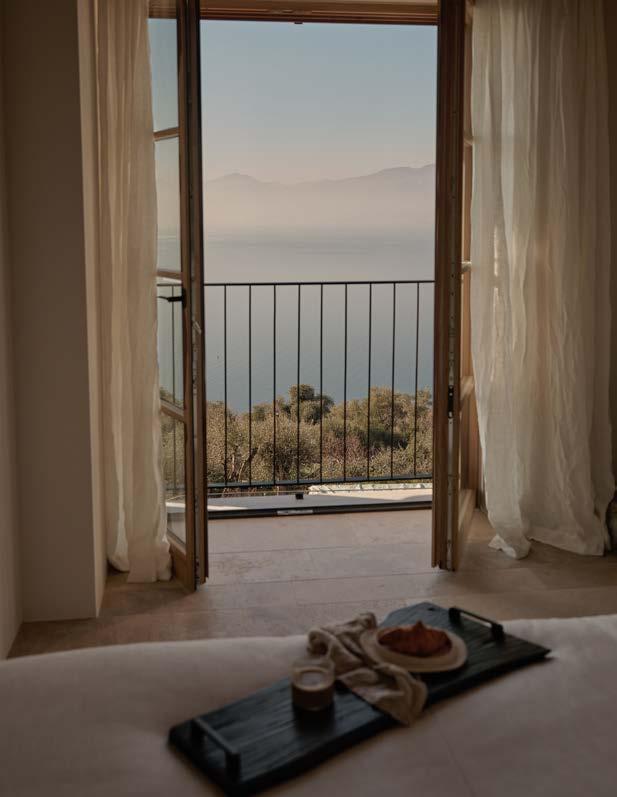
111 LUXURY LONDON ESCAPE LUXURYLONDON.CO.UK
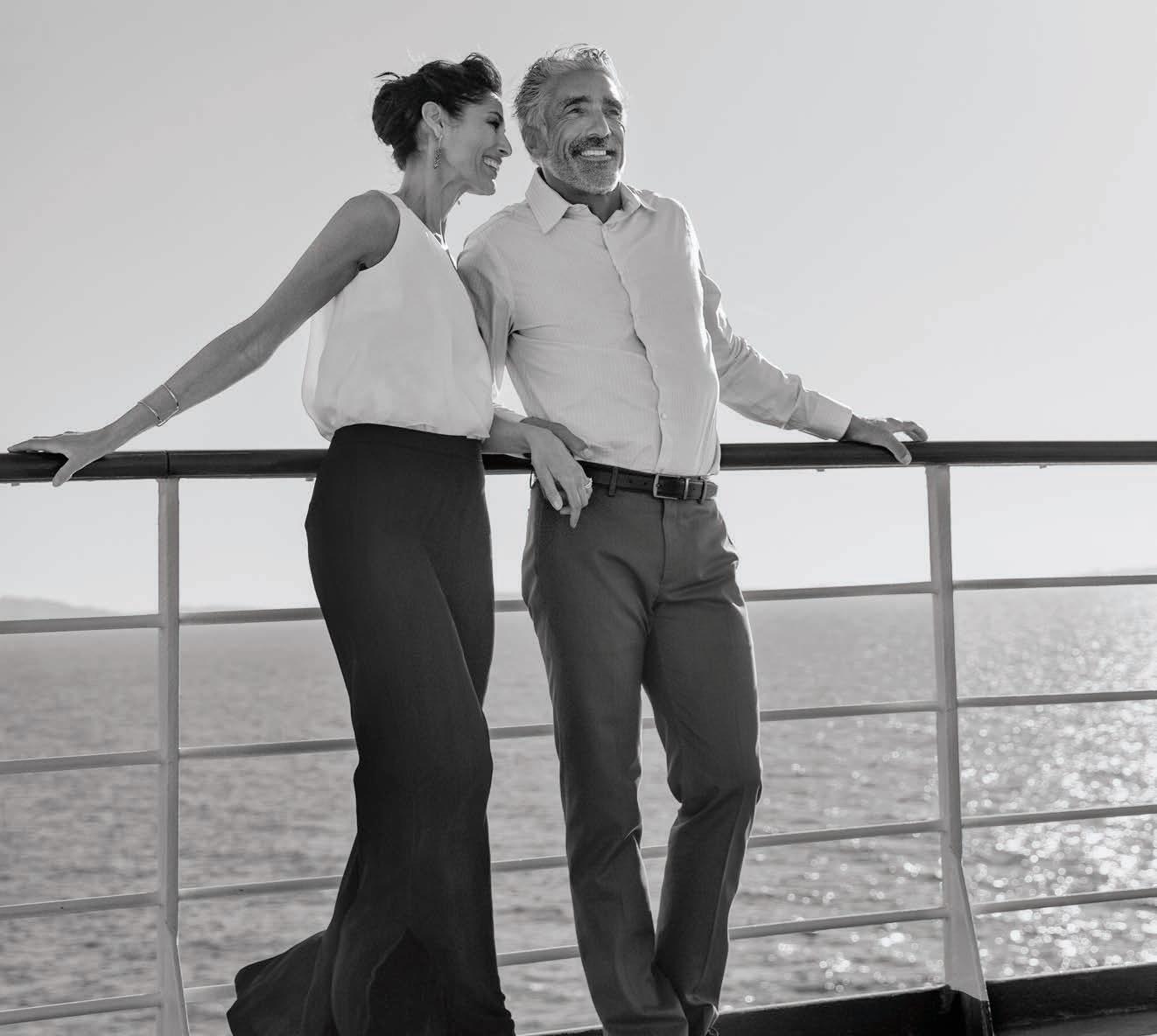
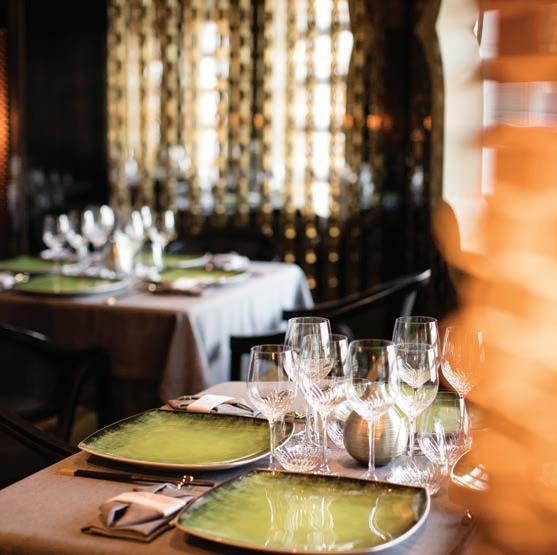
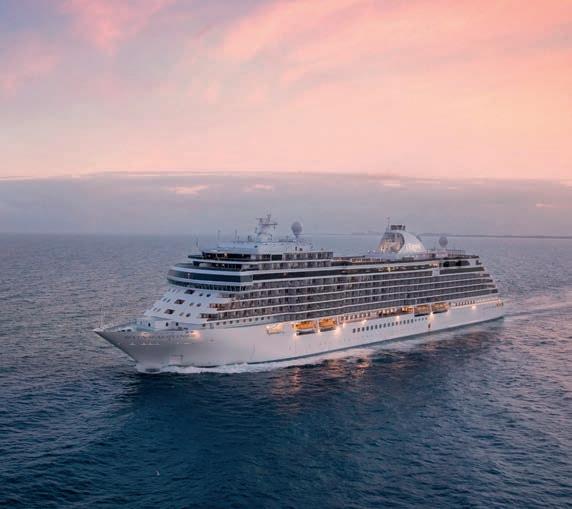


Embark on a holiday that creates memories to last a lifetime.
Whether you’re commemorating a milestone anniversary or birthday, or gathering for another precious occasion, let us enhance every moment through the warmth and personalised service of our wonderful crew and the splendour of The World’s Most Luxurious Fleet™
Set sail with Regent Seven Seas Cruises® for a voyage filled with unforgettable moments.
TO LEARN MORE
SCAN THE QR CODE
CALL 023 8082 1378
VISIT RSSC.COM/UNFORGETTABLE-MOMENTS
OR CONTACT YOUR TRAVEL ADVISOR



AD240401_UnfMoments_LuxLon_FP

UNTIL A FEW YEARS AGO, ALULA WAS ‘HARAM’, OR FORBIDDEN, DESPITE BEING HOME TO A PROFUSION OF JAW-DROPPING ANCIENT SITES. NOW, VISITORS ARE WELCOME TO THE SAUDI ARABIAN CITY, AND THE REGION’S DATE FARMERS AND CAMEL HERDERS ARE PUTTING THEIR BEST FOOT FORWARD IN A WORLD THAT’S BEEN CRACKED WIDE OPEN
Words: Charlie Thomas
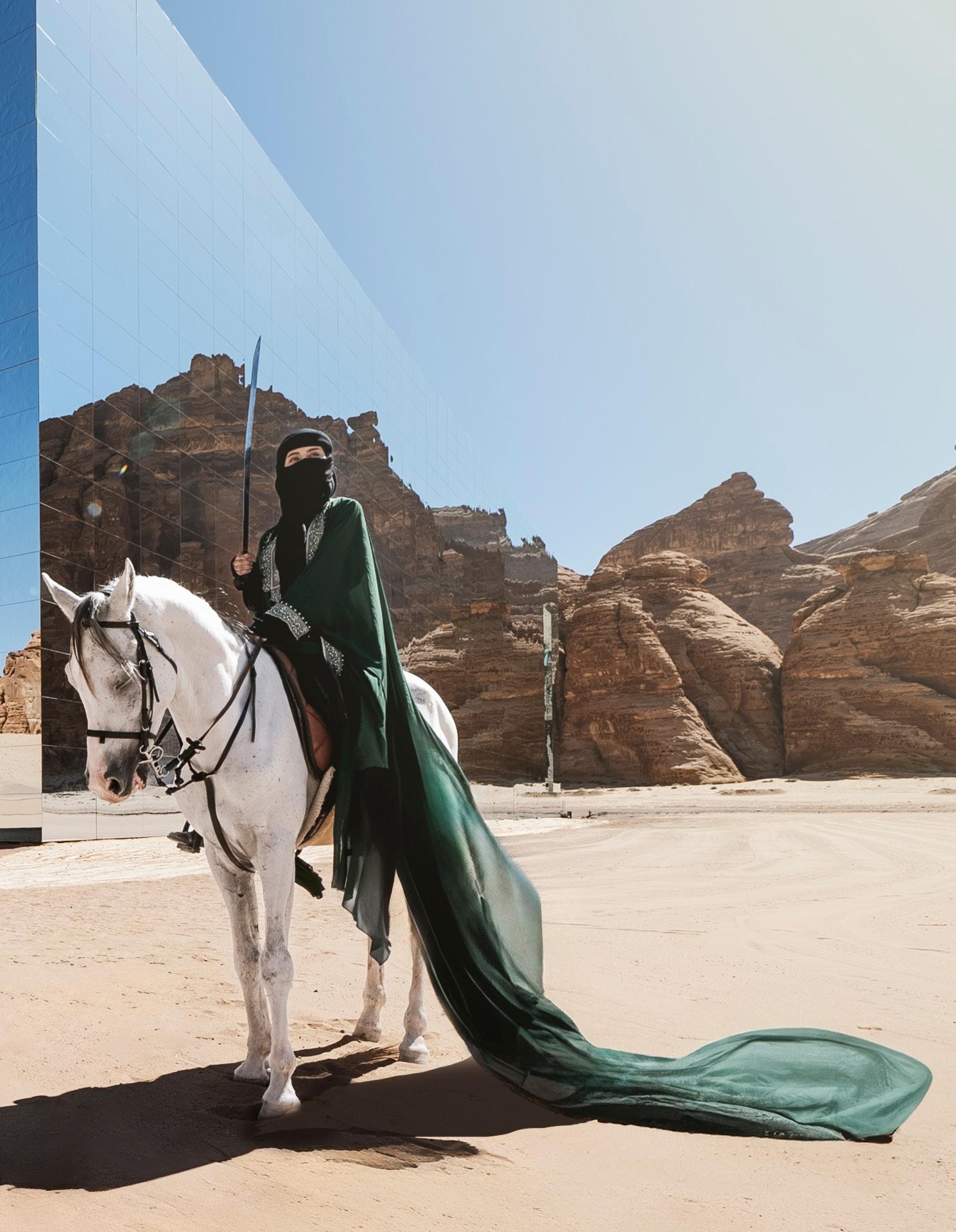
THE MARAYA CONCERT HALL IN THE MIDDLE OF THE ASHAR VALLEY DESERT, ALULA © ALMOZINISALEH
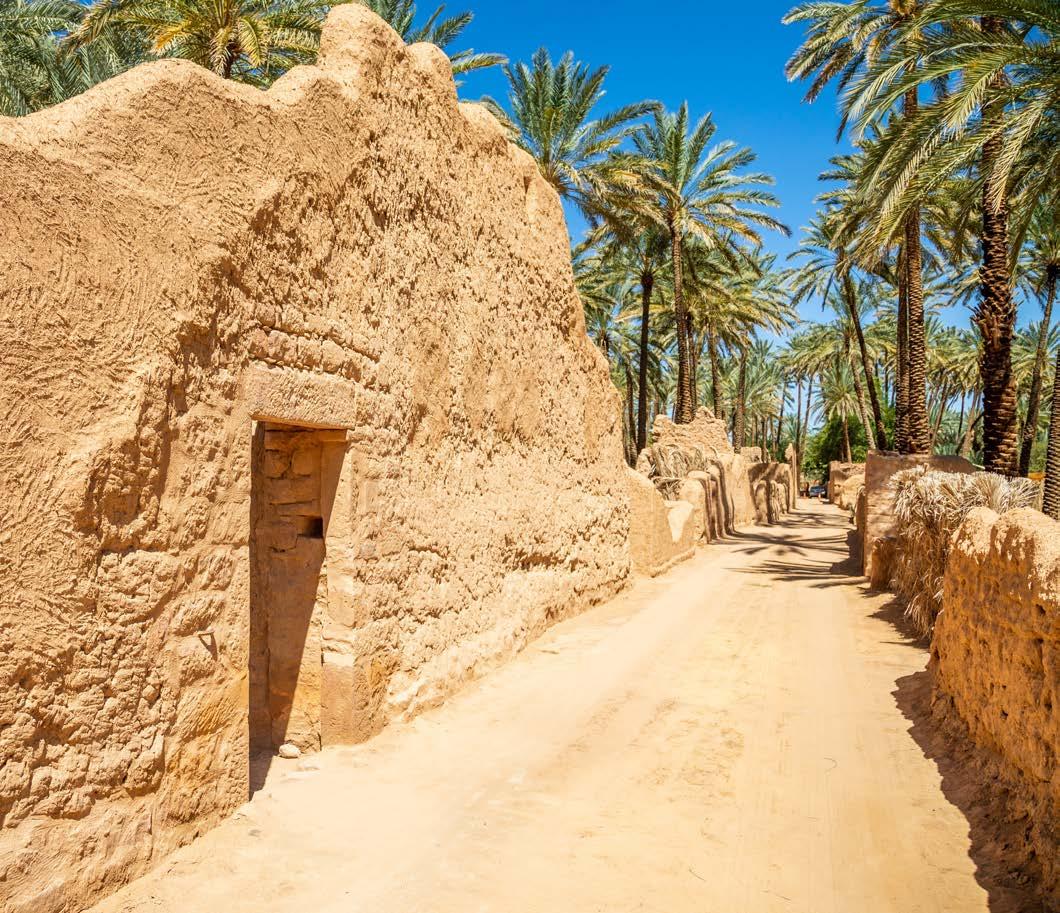
There is a certain buzz around AlUla at the moment. Despite being one of the oldest cities in the Medina Province, it seems as though something new is opening there every week. You’ve already seen the mirrored Maraya building flooding your Instagram Explore page. Dune-like resorts by the likes of Azulik and Marriott are being developed, and, when I visit, it is confirmed that Ye (formerly Kanye West) is recording his new album in the otherworldly five-star Banyan Tree resort.
But AlUla isn’t interesting for its multi-millionpound hotel openings, or because famous people are now visiting. It is a place of ancient history, where landscapes that belong on Mars are marked by centuries-old rock inscriptions. There are sweeping desert vistas, limestone tombs to rival Petra, and some of the most welcoming people you’re likely to meet. AlUla is believed by many to
be one of the world’s oldest inhabited lands, with civilisations living here as far back as 200,000 years ago. Its rocks and canyons may have been shaped over millions of years, but it is only recently that the wider world has begun to learn about the region.
As the luxury hotels are constructed, archaeologists are presented with a unique opportunity to uncover AlUla’s secrets. Scientists recorded over 37,000 potential sites for discovery during a 2018-2021 survey, one of which is Dadan, an ancient city which is currently a live archaeological dig site. The Royal Commission for AlUla (RCU), along with the French National Centre for Scientific Research (CNRS), have discovered huge stone structures, staircases and meticulously carved figures dating back to the late 9th century BC. The task of uncovering Dadan is still in its early stages, with only around five per cent of the area believed to be excavated.
116 LUXURY LONDON ESCAPE LUXURYLONDON.CO.UK

LEFT ALULA OLD TOWN COMPRISES 900 HOUSES, SOME DATING BACK TO THE 12TH CENTURY THIS PAGE THE TOMB OF LIHYAN SON OF KUZA, ALSO KNOWN AS ‘THE LONELY CASTLE’, MADA’IN SALIH, HEGRA, ALULA

THIS PAGE AND OPPOSITE SUSTAINABLE DESERT RESORT, HABITAS ALULA, COMPLETE WITH FITNESS CENTRE, TERRACE, RESTAURANT AND BAR, FROM APPROX. £800 PER NIGHT
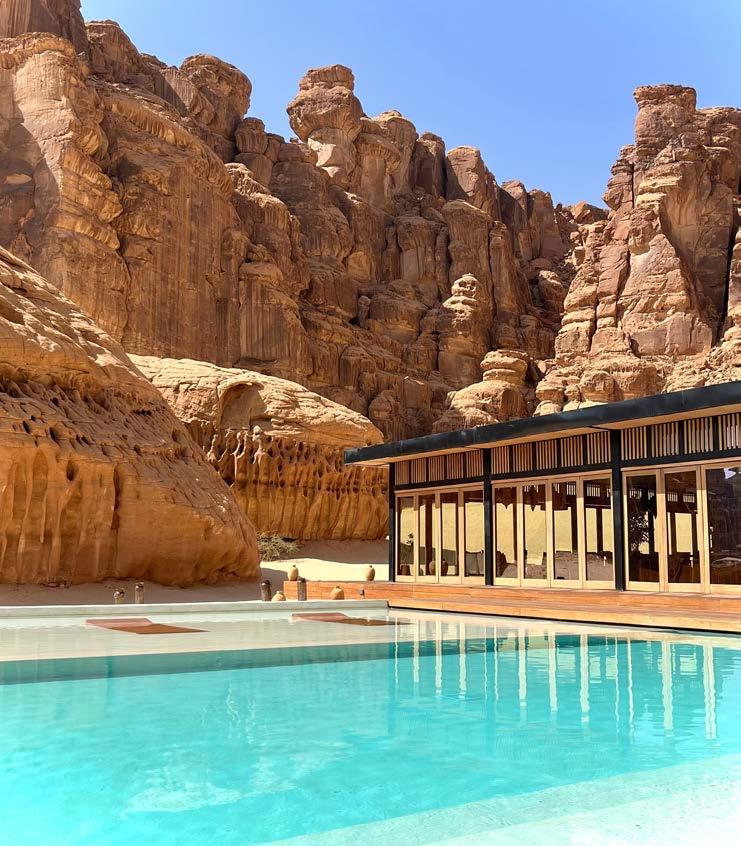
Before tourism, AlUla’s 40,000 residents mostly made money through farming – growing dates and fruit and raising camels and sheep
To discover AlUla, visitors can arrange tours with rawis, or local storytellers, hired by the RCU as tour guides. The team that I meet, which consists of both men and women, were all born in and around AlUla; one young rawi, Atif, leads the tour of Dadan. Donning the traditional white thobe and a red-andwhite shemagh, he discusses the impact of the site’s discovery: “We didn’t know anything about our history in the past – the real history that is sitting beneath
the ground. The scientists are studying it, giving us a chance to know more – that’s valuable to us. When we know our history we can apply it to visitors, and this gives us a chance to connect with the rest of the world. In the past, in AlUla, not a lot of visitors came here. Today, we have an opportunity.”
Before tourism, AlUla’s residents mostly made money through farming – growing dates and fruit and raising camels and sheep. While sites such as Hegra were globally recognised, even being listed as a UNESCO World Heritage Site in 2008, the city was considered ‘haram’, or forbidden, having been cursed by the Prophet Muhammad as a preIslamic city. This changed when Saudi Arabia opened to global tourism in September 2019 under Crown Prince Mohammed bin Salman’s ‘Vision 2030’ plans; now, AlUla, and the country’s other historical areas, are open to the world.
Atif grew up as a Bedouin nomad, living in the desert and working as a shepherd. He spent his childhood learning to hunt and ride. But he sees his new job as being just as important: “My future has become brighter. I’m also excited for the new generation – they will have a better chance to deliver for their children.”
Another rawi, Wedad, is among a number of women leading the charge. “Our role is basically to present our history to the people. In Saudi, it’s a role that we didn’t have in the past, but storytelling is one of the oldest forms [of communication] here in the Arabian Peninsula.” Like Atif, Wedad’s background is in farming. “Farming is in my family, but my father is the only one who has continued,” she says. “Our farm is just in front of Dadan. It’s really funny because, in the past, the tombs were our playground. Now it’s become like my office – I didn’t realise it had this deep history.”
Chief tourism officer for The Royal Commission for AlUla, Phillip Jones, understands the importance of getting locals on-side in the regeneration of the region, and makes sure that the incentives are there for them to take up roles in the RCU. “We make sure that we’re providing opportunities – we’re doing a lot of hospitality training and education as part of trying to encourage local residents to embrace the tourism industry,” he says.
“AlUla is the size of Belgium, with only 40,000 people living here, and, unless you were a date farmer before, there weren’t a lot of opportunities. Now look around. You see all these young Saudi men and women who are part of the tourism industry – part of the transition of the country.”
I do look around, and once again scratch my head over the fact that the world’s travellers have only just cottoned on. AlUla’s Old Town is
119 LUXURY LONDON ESCAPE LUXURYLONDON.CO.UK
a labyrinth of mud and stone houses dating back a millennium. The earliest inscriptions and carvings in the Jabal Ikmah canyon go back to the second half of the first millennium BC; a precursor to modern graffiti, these drawings depict musical instruments, animals and handprints, hinting at what the Dadanite, Lihyanite and Nabateans deemed important.
And then there’s Hegra, Saudi Arabia’s first UNESCO World Heritage Site. It’s the secondlargest conserved civilisation of the ancient Nabataeans, losing out to Petra. Hegra has over 110 preserved tombs, which have been carved directly into the sandstone rocks – some are small and discreet, whereas others, like the Qasr al-Far d, or ‘lonely castle’, loom large on the horizon, its intricate
carvings becoming more impressive the closer you get. The tombs were built for the Nabataean elite, and many still have the original inscriptions signalling for whom they were intended.
As I stroll among the wind-battered limestone rocks on a warm November evening, I can’t think of a more beautiful place on Earth. There is a distinct lack of people on my visit, meaning I get to explore landscapes that are conspicuously free of selfie sticks and Instagram poses – but it is impossible to feel truly alone among the inscriptions. They’re a reminder of those who have gone before, who left their mark as they passed through.
There are many projects opening up in AlUla, but the most captivating reasons to visit have been here for thousands of years.
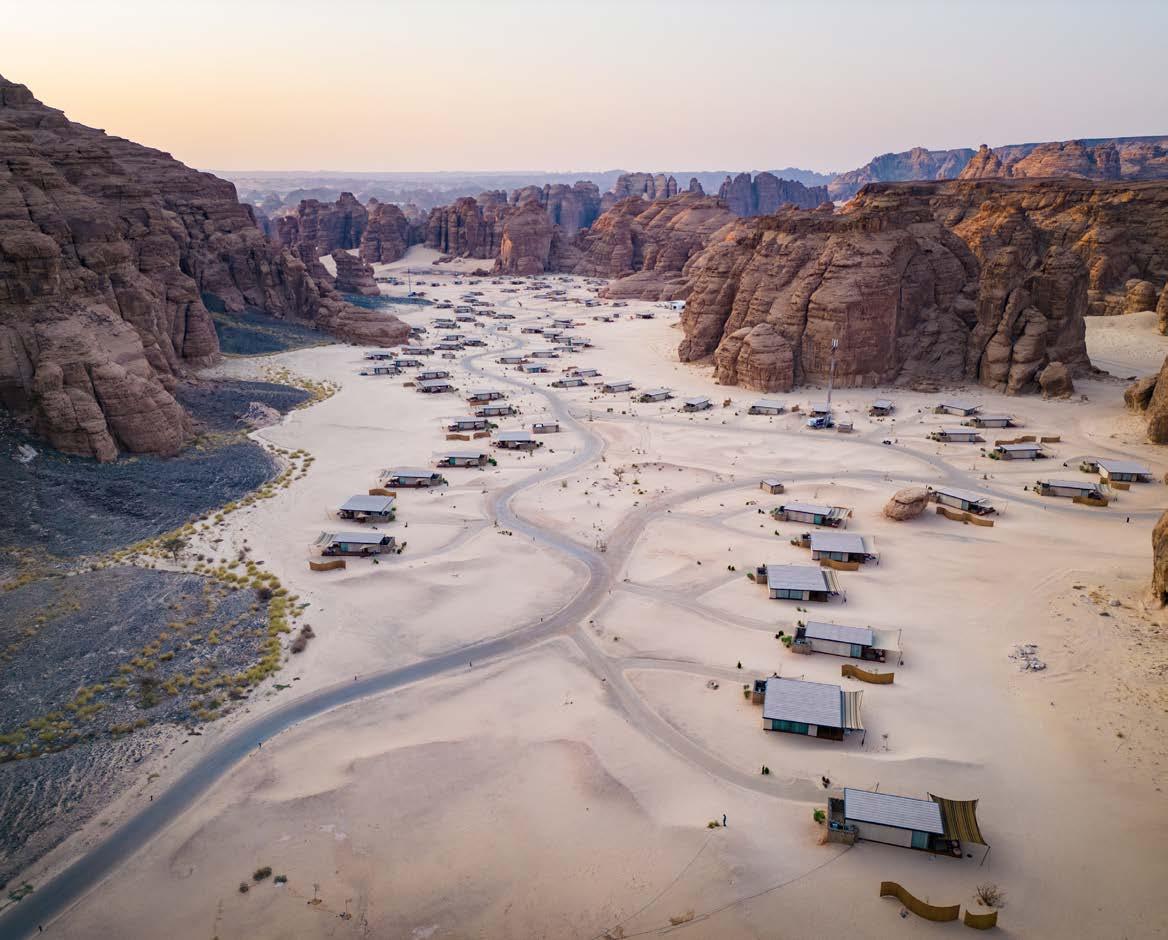
120 LUXURY LONDON ESCAPE LUXURYLONDON.CO.UK
THE SANDSTONE CANYONS THAT SURROUND HABITAS ALULA

Pan Pacific London partners with luxury children’s brand Bonpoint to offer exclusive wellness experiences for children aged 6-16. Skincare treatments and packages provide little ones to dip their toes into a world of wellness.
80 Houndsditch, London, EC3A 7AB
T: +44 (0) 20 7118 6888 enquiry.pplon@panpacific.com @panpacificlondon
PANPACIFICLONDON.COM
121 LUXURYLONDON.CO.UK Singapore • Kuala Lumpur • Penang • Malacca • Langkawi • Bangkok • Yangon • Nay Pyi Taw • Hanoi • Ho Chi Minh City Phnom Penh • Siem Reap • Jakarta • Dhaka • Beijing • Tianjin • Xiamen • Suzhou • Ningbo • Dalian • Sydney • Melbourne Perth • Tokyo • London • Seattle • Vancouver • Whistler, British Columbia • Toronto • Nairobi The World of Pan Pacific Hotels Group | panpacific.com Graceful Luxury Sincerely Yours
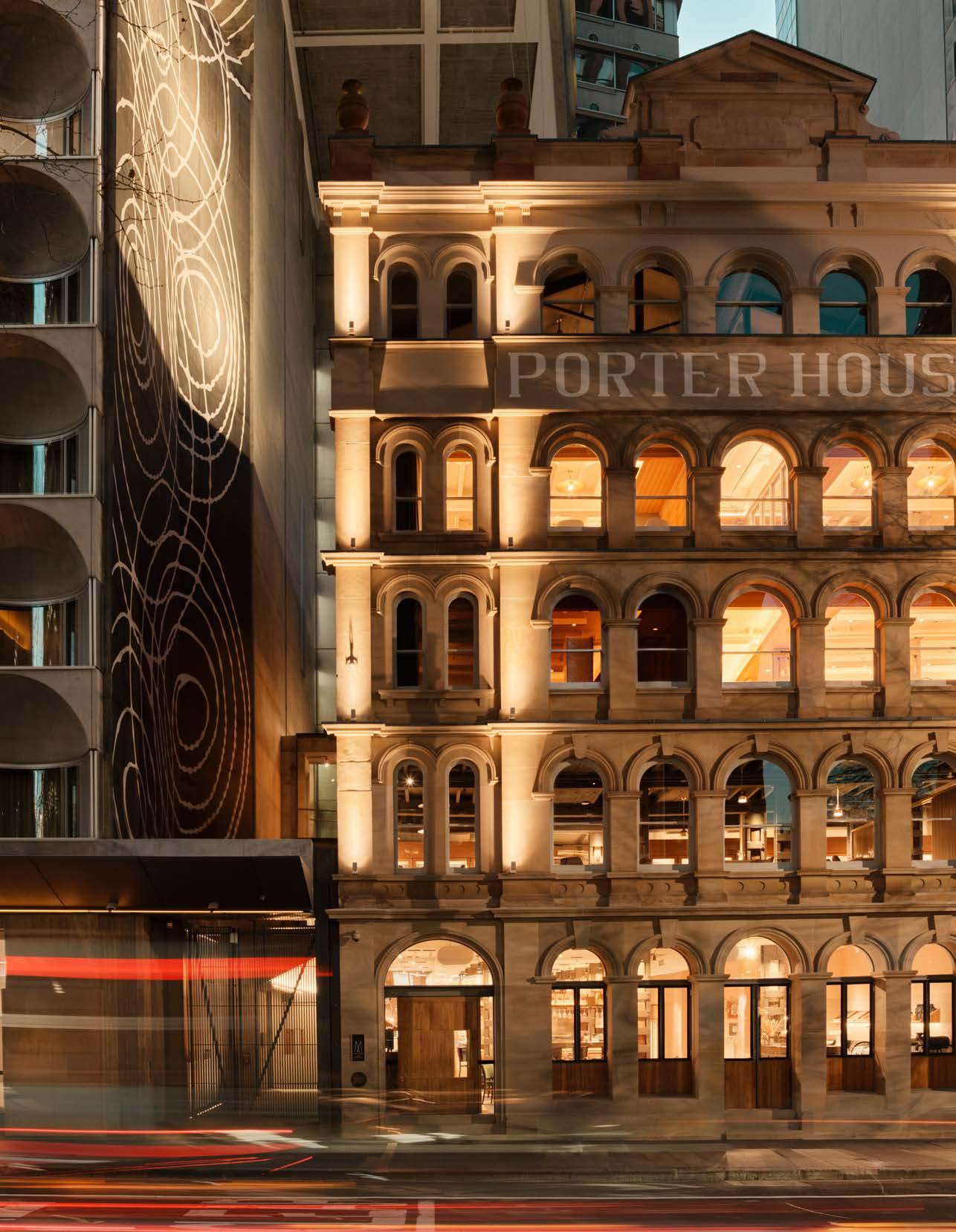
THE PORTER HOUSE HOTEL ©STEVEN WOODBURN

How Sydney got its Swag Back
Words: Jack Phillips
When it comes to luxury travel, it’s fair to say that Sydney has been left wanting in recent years. Save for a handful of longstanding namesakes like The Langham and Park Hyatt, there really hasn’t been much to shout about when it comes to noteworthy places to stay. Sydney fell by the wayside as other Aussie cities –Melbourne, Brisbane, Adelaide – were buoyed by foreign investment, striking new architecture and the high-spending travellers that were attracted by the buzz.
In 2024, however, Sydney is set for a kick in the caboose with several new hotel openings worth shouting about. And about time. The city’s natural beauty, cultural richness and world-class bars and restaurants make it an attractive destination for those seeking the finer things in life. According to The Reserve Bank of Australia, Sydney’s luxury
travel sector has grown by 10 per cent since the pandemic and is now worth more than £1.3 billion a year. Growth has been attributed to both domestic and international travellers, drawn to a heady mix of the old and the new.
The city’s restaurants, such as Quay, Aria and Bennelong, have long garnered international acclaim, while bars such as Maybe Sammy, Baxter’s Inn, Cantina OK! and Re have more recently appeared on the lauded list of The World’s 50 Best Bars. A profile by Netflix’s Chef’s Table in 2020 saw the popularity of Firedoor Restaurant skyrocket, resulting in owner and chef Lennox Hastie opening a new Basque-inspired venue, Gildas, in 2022 – to much pomp and acclaim. With high-end Korean joints like Matkim and 12-seater Allta slated to open this year, alongside many more tasting experiences across the city, it’s no wonder that Sydney has swagger.
AUSTRALIA’S MOST FAMOUS CITY HAS REDISCOVERED ITS MOJO THANKS TO A SLEW OF SOPHISTICATED NEW OPENINGS

And it’s not just food that’s catching up in Sydney. It seems the traditionally hesitant highend sector is finally embracing cutting-edge technology. Restaurants and hotels are finding new ways to utilise tech to improve user experience without removing the personal touch. From contactless check-ins, to immersive virtual reality travel previews, to paperless receipts (why are paper receipts still a thing in 2024?), technology is redefining the way travellers encounter the city.
The W Hotel, which opened at the tail end of 2023 at the cost of £520 million, encapsulates the city’s current renaissance. Situated in the heart of Darling Harbour, the five-star hotel beckons guests with a sleek yet classic charm. As you would expect from a W Hotel, the lobby is laden with contemporary art and was fully booked for almost three months following its opening.
The guestrooms at W Hotel are elegant, offering views of Darling Harbour. Each room is thoughtfully designed, featuring plush furnishings, neutral tones and techy amenities. The hotel’s
culinary scene is worth staying in for, with the acclaimed Razor Restaurant serving a fusion of Australian and international flavours. The property is taking sustainability seriously, too, using linens partially made of recycled materials from Ekocycle, the environmental brand formed in 2012 by Black Eyed Peas singer Will.i.am and Coca-Cola.
For travellers seeking a quieter retreat, the muchanticipated Capella is a new gem nestled in the heart of Sydney’s historic district, The Rocks. Rooms at the latest opening from the Kwee brothers and
For travellers seeking a quieter retreat, Capella is a new gem nestled in the heart of Sydney’s historic district, The Rocks
124 LUXURYLONDON.CO.UK
CAPELLA SYDNEY

ACE HOTEL SYDNEY
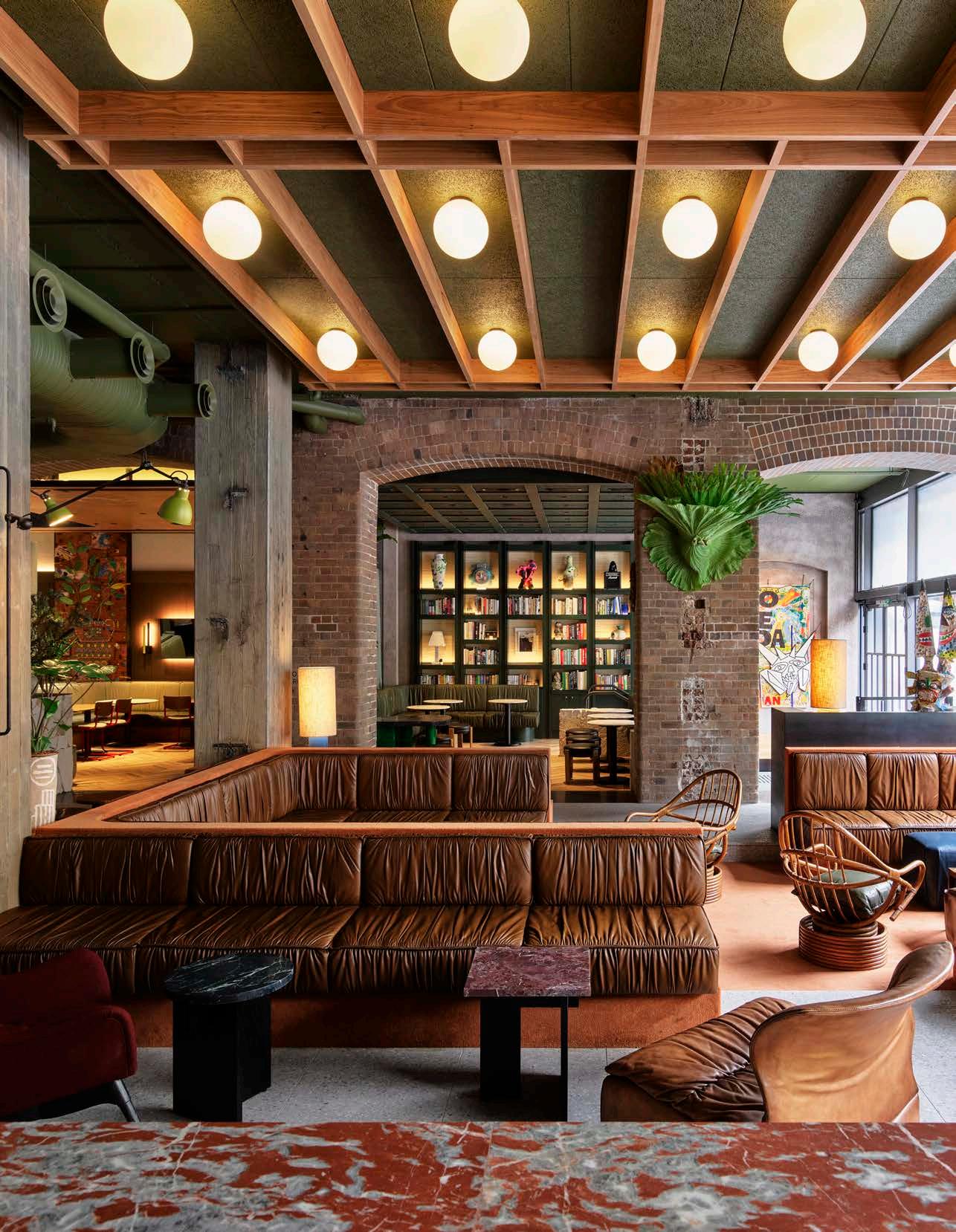
ACE HOTEL SYDNEY
Pontiac Land Group (Conrad Centennial Singapore and Capella Singapore) pitch themselves as works of art, designed with handpicked furnishings that nod to Sydney’s maritime past. The hotel’s standout feature is its lush private gardens, which provide an oasis of greenery amid the concrete sprawl. It’s refined, restrained and easily sets a new bar for luxury hotels in Sydney.
A stone’s throw away is Porter House, which finds its home in the heritage-listed Porter House building, and is reminiscent of a bygone era. The hotel combines old-world charm with modern amenities, making it a great choice for travellers seeking classic elegance without the Capella price tag. The rooms at Porter House are spacious and tastefully furnished, with an emphasis on preserving the historical integrity of the building. The dining options at the hotel are modern twists on classic fare, with the brasserie, Dixson & Sons, offering a delectable menu served by staff dressed in stylish, formal attire.
Although it opened back in 2022, Ace Hotel is still bringing a welcome vibrancy to the neighbourhood of Surry Hills. It’s a paradise for art aficionados and travellers who appreciate cutting-edge design. As those who have frequented the Ace Hotel London and New York can attest, there are cool-cat creative types aplenty, rooms are retro and Instagram-worthy, and the clientele rarely skews north of 50.
Each guest room at Ace Hotel is a canvas, with murals and custom furnishings. The hotel’s commitment to the local art scene is distinct and manages to bridge cool and classy; it runs an Artist in Residence program, with the artist in question rotating quarterly. You expect this is where The Rolling Stones would stay if they were to play Sydney.
Overlooking the picturesque harbour is the Kimpton Margot, which offers a breathtaking vista of one of the world’s most iconic landmarks. This luxury hotel is a haven for travellers who desire not only opulence but awe-inspiring views. Kimpton Margot’s design ethos is a fusion of contemporary aesthetics and a connection to nature.
The guest rooms at Kimpton Margot are meticulously designed, with a focus on natural materials and earthy colours. The hotel’s rooftop bar, Harbour Rooftop Bar, is the ideal spot to enjoy the city’s iconic sunsets, and the hotel’s commitment to sustainability is evident in its green initiatives and eco-friendly amenities.
As a London ex-pat that’s lived in the city for more than a decade, it feels like Sydney is having something of a moment. If you’ve never visited before, 2024 is shaping up to be a good year in which to come and say ‘g’day’.
WHERE TO STAY
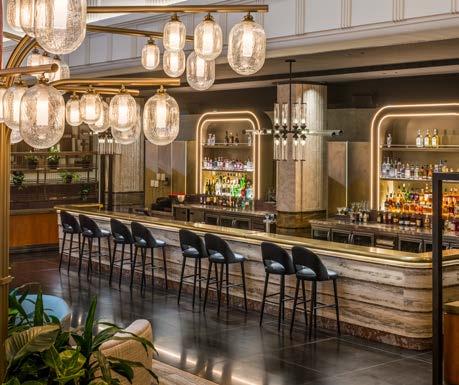
W HOTEL
Best room: Extreme Wow penthouse suite
What to drink: Sake at Living Room Bar
What to eat: Anything by Janice Wong at the 2AM:dessert bar
From approx. £200 per night, marriot.com
CAPELLA
Best room: Skyline Suite
What to drink: Day After cocktail at McRae Bar
What to eat: Spanner crab at Brasserie 1930
From approx. £360 per night, capellahotels.com
KIMPTON MARGOT
Best room: Hammond Suite
What to drink: Mystery cocktail at Wilmot Bar
What to eat: Tasting menu at Luke’s Kitchen
From approx. £160 per night, ihg.com
THE ACE
Best room: Ace Suite
What to drink: Ruby Margarita at The Lobby
What to eat: Small plates at Kiln
From approx. £150 per night, acehotel.com
PORTER HOUSE
Best room: Junior Suite
What to drink: Tan Line Martini at Spice Trader
What to eat: Murray cod toasty melt at Henry’s Bread + Wine
From approx. £140 per night, porterhousehotel.com.au
127 LUXURY LONDON ESCAPE LUXURYLONDON.CO.UK
THE WILMOT BAR AT THE KIMPTON
Through the keyhole: The Whiteley
A LONDON INSTITUTION IS THE SUBJECT OF A BILLION-POUND RENOVATION AND AN INTERNAL INJECTION OF AMERICAN IRREVERENCE
Over in Bayswater, the regeneration of the former Whiteleys shopping centre gears up towards its grand opening later this year. The UK’s first department store, originally opened in 1863, is being transformed into a 1.1 million sq ft residential and hospitality address, comprising 139 homes, including 14 branded residences, and a 109-room Six Senses hotel.
We are now at the exciting part of the project, where individual homes are being unveiled. And they’re every bit as spectacular as one would expect from a £1 billion redevelopment. The first completed residence is a three-bedroom, 3,193 sq ft apartment by New York-based, AD100 designer Kelly Behun.
Fittingly for such a storied landmark, the apartment draws inspiration from the past. There are nods to The Whiteley’s original architecture throughout: ceiling heights of more than four metres, heritage windows, fluted millwork columns, and herringbone floors.
Yet, The Whiteley is also a beacon of the future of high-end London property, and reflects this in its design – the space is open plan and loftstyle; it feels vibrant and contemporary. This was perhaps inevitable when development managers Finchatton and investment partners MARK and C C Land appointed Behun to make her UK debut.
The apartment is full of bespoke and handmade twists: in one of the guest bedrooms, a wall is decorated in wallpaper that depicts a forest
dreamscape (personally designed by Behun for Calico Wallpaper). Elsewhere, a walnut dining table by Belgian artist Benoit Viaene was selected for its organic shape; behind it hangs a surrealist mural born of a collaboration between Behun’s studio and scenic backdrop painter, Sarah Oliphant.
The offbeat design extends to the living area, which is home to a unique rug by fashion designer Mary Katrantzou, a pair of torchiere-style sconces from artist Chris Wolston, and a gorgeous painting by Kathleen Mullaniff, inspired by a traditional English country garden. Strategically placed at the heart of the home is the kitchen – the island is attended by statement stools from Bali, and a custom wicker pendant serves as the focal point of the space. Despite untraditional elements, Behun’s designs are always mindful of setting; the apartment employs a palette of golds, greens, roses and lavenders, drawn from The Whiteley’s proximity to Hyde Park. In this vein, the home is filled with plants, enhancing its connection to the natural world.
This is not like other show apartments in other landmark developments, where things are all rather serious. Perhaps it is Behun’s removed influence that has allowed her to give the space a playful treatment, rather than one that is overburdened by reverence. That said, the calibre of this property within The Whiteley should be taken very seriously indeed.
£12.5million, search.savills.com


128 LUXURY LONDON PROMOTION LUXURYLONDON.CO.UK
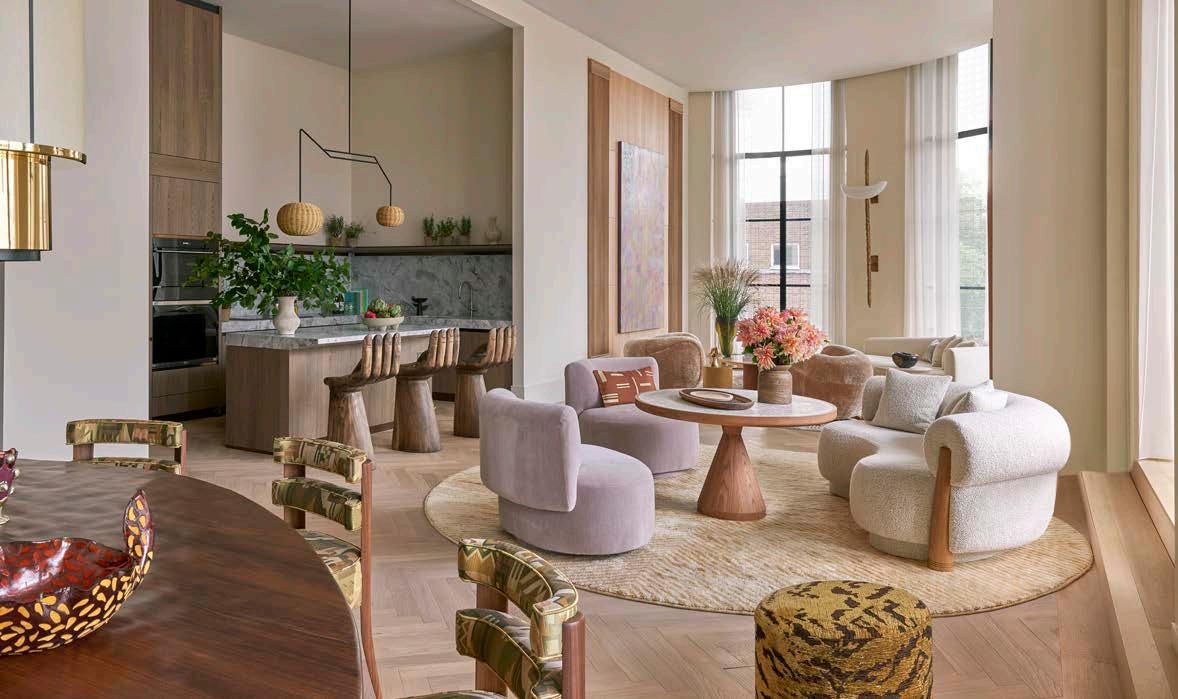
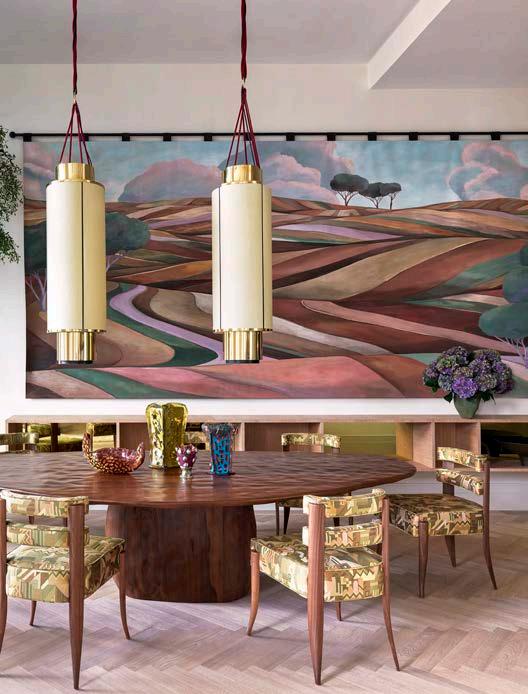
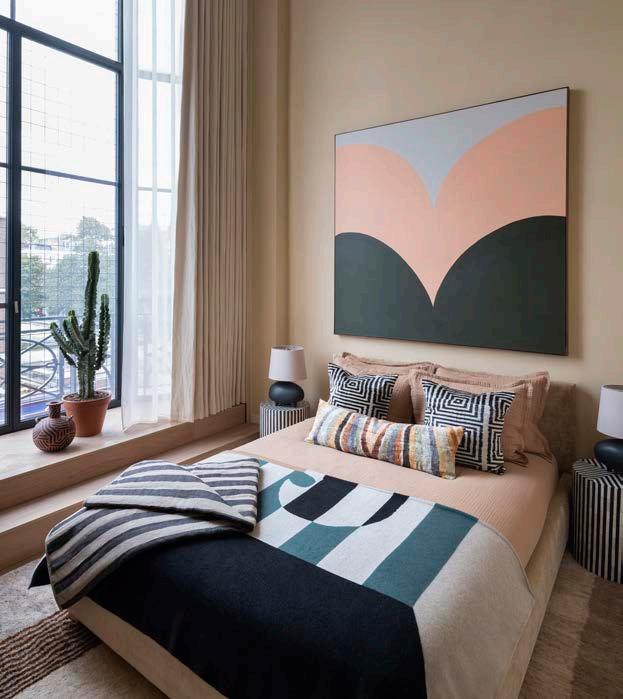
129 LUXURY LONDON PROMOTION LUXURYLONDON.CO.UK

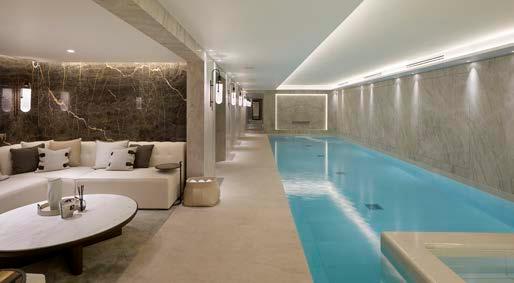
ON THE MARKET
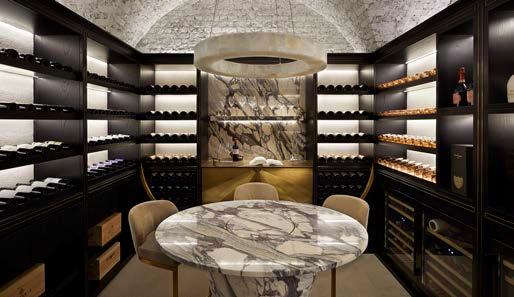
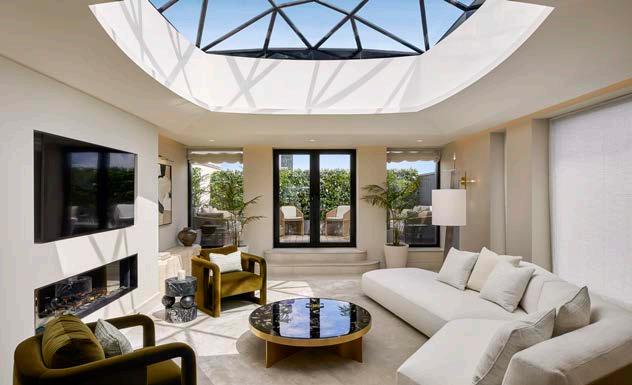
33 Portland Place, Marylebone
AN 18 TH CENTURY MANSION THAT FEATURED IN THE KING’S SPEECH HAS BEEN RETURNED TO ITS FORMER GLORY BY THE CHAIRMAN OF A PREMIER LEAGUE FOOTBALL CLUB
An asking price of £75 million is rare, even in London. To ascend to such dizzying heights, a property must tick the big three boxes: size, location and a recent (big-money) renovation. But it also needs something else. Something extra special. An X factor. In this case, that clincher is star quality, literally: this property, at Marylebone’s 33 Portland Place, provided a backdrop for the Oscar-winning film The King’s Speech, as well as to the music video of Amy Winehouse’s Rehab and an Agent Provocateur campaign starring Kate Moss. Indeed, 33 Portland Place has been hosting society’s movers and shakers for almost 250 years.
Let’s start with the basics. This is simply one of the most impressive homes in the capital. Spanning almost 21,000 sq ft, the Grade II* property was originally built in 1775 by neoclassical architect, interior specialist and furniture designer, Robert Adam. It was first owned by Colonel John Montresor, a military engineer and cartographer in America, before belonging to both Sir Richard Bulkeley Philipps and The Earl of Abergavenny. Prime Ministers Archibald Primrose and Herbert
Asquith both dined at the premises, before it became the embassy of Sierra Leone in the 1950s. It 1998, it was acquired by property developer (and later convicted fraudster) Edward Davenport.
Inside, a revamp by interior design studio 1508 (which recently kitted out the new Raffles London hotel) was funded by West Ham United chairman David Sullivan, who purchased the property as a project and has spent almost £50 million during a seven-year renovation. The turnkey home now boasts a classic aesthetic created via bespoke joinery, tonnes of marble, handpainted wallpaper and artisanal chandeliers. Period details have been preserved – most notably in the form of a wall installed in the 1800s, where double-leaf mahogany doors drop into the floor to create an open 30-metre space. Elsewhere, there’s a gym, swimming pool, cinema room and wine cellar.
The location is a massive tick, too: Portland Place sits on the doorstep of Regent’s Park. Tick, tick, tick.
33 Portland Place is on the market for £75 million with Sotheby’s International Realty, sothebysrealty.com
130 LUXURYLONDON.CO.UK
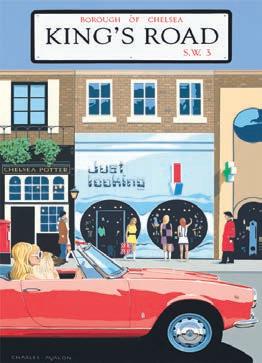




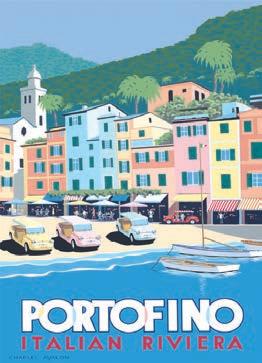
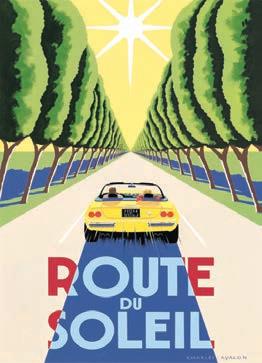



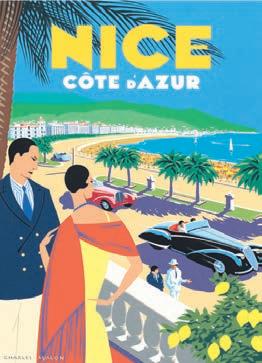

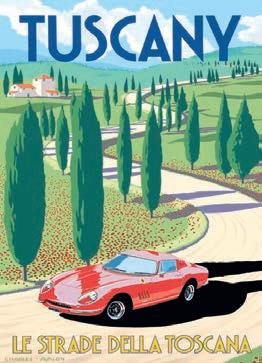

Limited to editions of 280, our newly-commissioned Art Deco posters feature glamorous holiday destinations around the world, ski resorts in the European Alps, and the world’s greatest historic automobiles. Over 100 designs to choose from, all printed on 100% cotton fine art paper, measuring 97 x 65 cms. Priced at £420 each (inc. UK sales tax). Private commissions are also welcome.

@pullmaneditionsposters
All images and text copyright © Pullman Editions 2024









Pullman Editions
94 Pimlico Road
Chelsea London SW1W 8PL
+44 (0)20 7730 0547 info@pullmaneditions.com

Our central London gallery
131 LUXURY LONDON FEATURE LUXURYLONDON.CO.UK
View and buy online at www.pullmaneditions.com
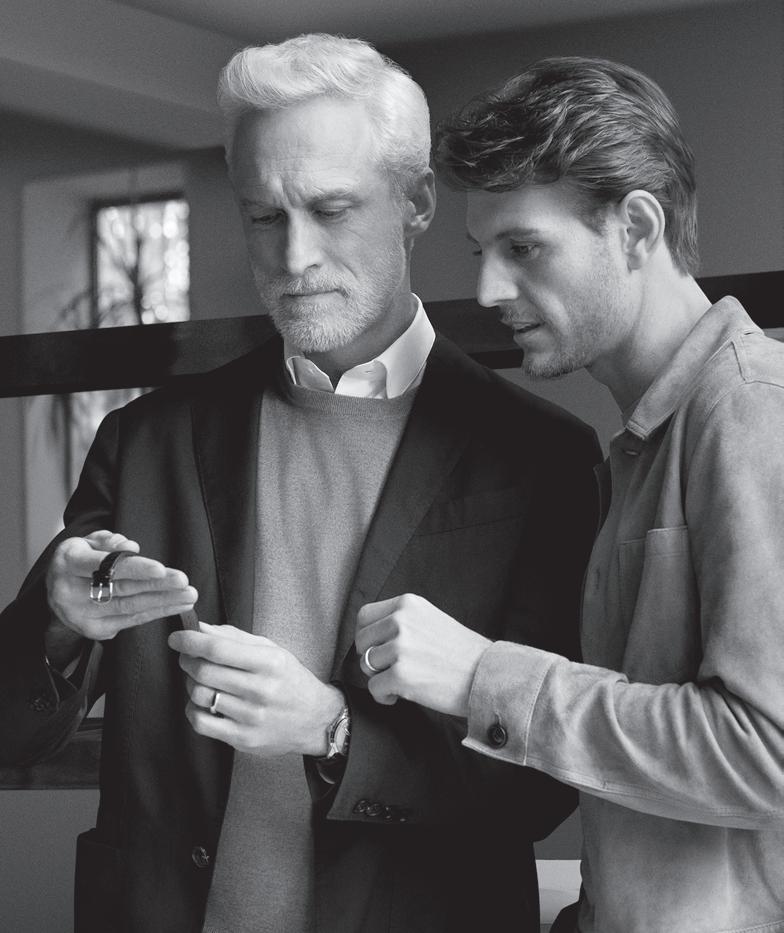


















































































































































 FENG CHEN WANG
FENG CHEN WANG















































































































































